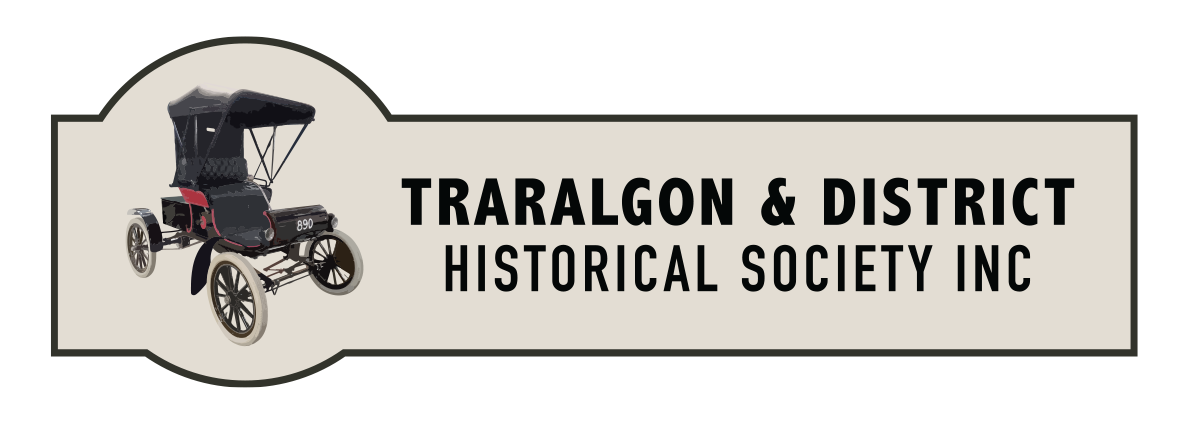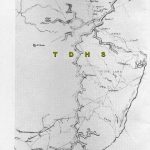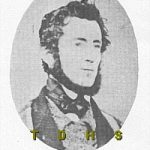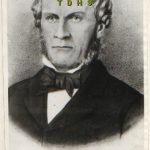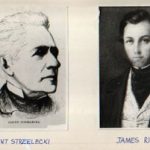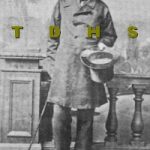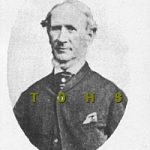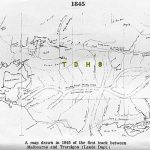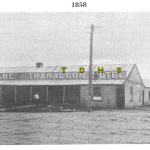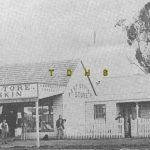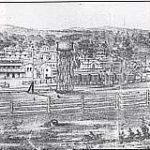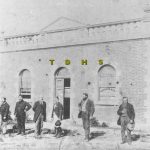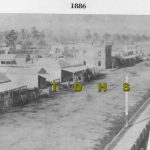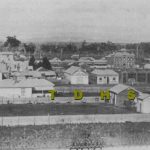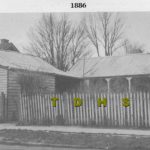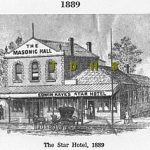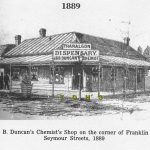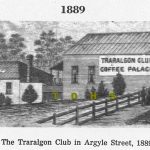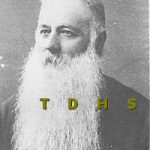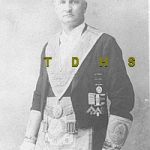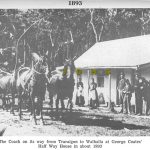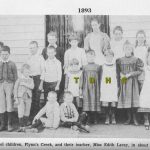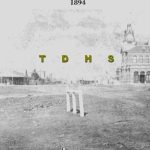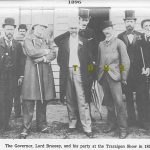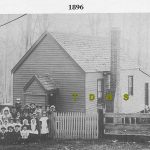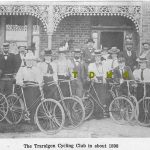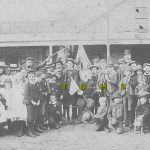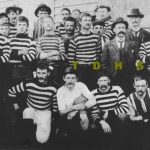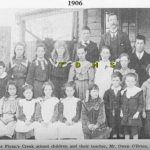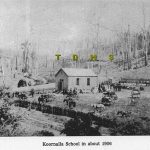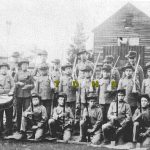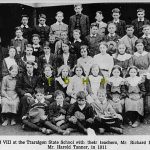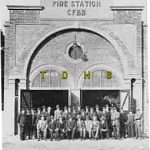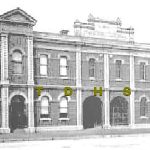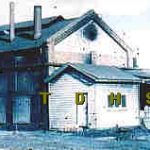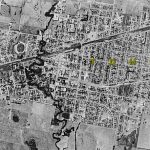The River of Little Fish
By Mr. William J. Cuthill
An historical account of Traralgon, written for the boys and girls of the city. First published in 1970.
About the Author - Mr. William J. Cuthill
Foreword by the Author - The River of Little Fish published on CD ROM - 2001
 Traralgon is an industrial City, 160 km to the east of Melbourne, with a population of approximately 26,000. The children are fortunate in having their own history of their City, written for young people by the author, Mr. William J. Cuthill.
Traralgon is an industrial City, 160 km to the east of Melbourne, with a population of approximately 26,000. The children are fortunate in having their own history of their City, written for young people by the author, Mr. William J. Cuthill.
Mr. Cuthill was a resident of Traralgon for 18 years, and was the Clerk of Courts. He retired from the Victorian Public Service in 1974, when he was the Chief Stipendiary Magistrate for the State of Victoria. He has agreed to the reproduction of his book, on CD ROM, for distribution to the schools of Traralgon and District.
His method of retaining the interest of his young readers was copied from "The History of Bermuda" by Canon Tucker, a unique book. Mr. Cuthill has assured the Society that he is grateful to it for allowing him to leave a small "footprint on the sands of time" and hopes that you, too, will enjoy your reading of "The River of Little Fish".
W.J. Cuthill - January 2000
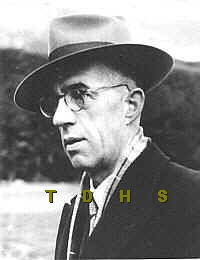
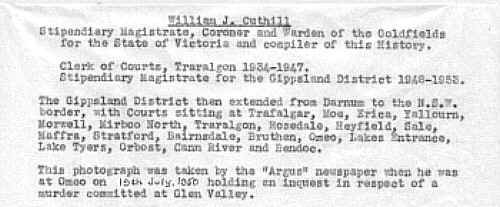
The study of local history forms part of the curriculum in our schools. both in Grade V and later in Form 1, and in the past the children of Traralgon have had no suitable source of information.
In 1946, the Centenary Celebrations Committee published a pamphlet entitled "The First Hundred Years" which was prepared by its Historical Committee, and that pamphlet has had to serve as a basis for their studies, for there is no other published History of Traralgon.
When in Bermuda during 1961, I was shown a History of Bermuda written specifically for the school children of Bermuda by Canon Tucker. This History was published in book form by the local Education Authorities and, as a result, the school children there are all fully informed on the history of their island, which has been written down to their own particular levels.
On my return to Australia, I began to give consideration to preparing a History of Traralgon particularly suited for children. Upon hearing that those seekers of information for school projects first called at the "Journal" office, with little result, and then sought the help of the late Miss E.M. West , and after conversation with other members of the Traralgon and District Historical Society , I considered that I might find time to draft a simplified history for the children which, through the kind offfices of Mr. W.A. Thompson, might be published in serial form in the "Journal" so that those children who were interested might compile their own personal copy by keeping all the instalments as they appeared.
The compilation of such a history has not been easy. I have followed the incomparable style of Canon Tucker as far as possible, and felt that, by so doing, I will have enticed my young readers to read further. But, although research into the earlier periods of the history of our town is fairly complete, little effort has been made to compile any record of happenings during the twentieth century. As a result, I feel that the latter chapters of the story are somewhat scrappy, and fail to achieve their purpose to the extent which I would desire, despite the assistance given by members of the Traralgon and District Historical Society who perused and checked the draft before it was published.
I feel that this attempt at compiling a children's history might be the basis of revision over the years as research progresses and further chapters of the reference history held by the Society are written. I am pleased that the Society has seen fit to publish the story in book form. The basic data will always form portion of the main History of Traralgon for the information of those who would seek to improve upon what I have been able to achieve without precedents and with but little assistance from modern institutions in Traralgon who seem most reluctant to compile a detailed history of their organization and activities to hand down to future generations.
W.J. Cuthill - 1970
My Dear ****
This is going to be a story all about Traralgon, the place where you live, and I do hope you will like it so well that you will read it from the beginning to the end.
What do those stars mean?
Well, you see, they stand for the letters of your name, the name of the boy or girl who is reading the story, and you must put the letters in for yourself, because I cannot do it for you, as I do not know the names of all the boys and girls in Traralgon, though I am glad to say I know the names of a great many.
So, if your name is Jack, or if it is Joan, the number of the stars will be all right for you, but if your name is Betty, or Katherine, or Herbert, all you have to do is add as many stars as you like. But, if your name is Jim or Ann, what you must do is take away a star, and there you are. When you have changed the stars into letters of your name, you will see that the story is really and truly written for you, my dear ****.
Suppose I were to ask you to tell me all about your own home, you would say "Well, that's easy enough", and you would tell me what kind of house it was, and where it was, and perhaps who built it, without stopping to think. And then perhaps you would go on to tell me about the garden, and the fruit trees. and the fowl yard, and the dog kennel, and where the cats and their kittens live. You know all about it.
And if I were to ask you about your school, it would be just the same. You would have everything at your fingertips, and could tell me all about the classrooms, and the playgrounds where the boys play cricket and football, and the girls their basketball and softball.
But if I were to ask you to tell me all about Traralgon, your own town, how about that ? I am quite sure that boys and girls do not know the story of Gipps' Land and Traralgon nearly as well as they ought, and this story is to help them know more about it.
It's a very sensible idea, my dear ****, to begin at the beginning, and most people do so, except those who like to begin at the end of the story, and that takes away all the fun. If you read a fairy tale and knew how it ended, you would miss a great deal of pleasure and wonder, and when it came to the end, when the Prince was married to the beautiful Princess, and they lived happily forever afterwards, you would say, "Oh, I knew all that", just because you didn't begin at the beginning.
So let me begin my story at the right end, which is the beginning, and not at wrong end, which is the end. It sounds a bit queer, this, but it really isn't so.
We must go right back for one hundred and thirty five years, when the people of England were still sending out shiploads of convicts to New South Wales and Van Diemen's Land to stay there, some for seven years and some for fourteen years as a punishment for their crimes. There were quite a number of adventurous people too, who decided to sail right across the world to make their homes in far away Australia. All the eastern part of our continent was called New South Wales, and there was just one big town - Sydney.
Tasmania was still called Van Diemen's Land, and two men there decided to come to Port Phillip Bay with their friends and their sheep and their cattle, and make new homes where no white men had ever built their houses before. And what were their names ? John Batman and John Pascoe Fawkner. That was in the year 1835.
Their new village on the banks of the Yarra had to have a name, and what did Governor Bourke in Sydney call it ? Why, Melbourne of course.
But the settlers on the northern side of the Murray River, who had moved down from Sydney, were still seeking more and more land for their sheep and cattle. There was plenty of land for everyone - just pick the best place, and squat. All you had to do was tell your neighbours which was your piece of land- your "Run" - you became a "squatter", and the land was yours for £10 a year.
By the year 1838, some squatters had come right over the Australian Alps, and had taken up a run at Omeo. and a bold Scotsman called Angus McMillan, in the next year, even rode down as far as the Latrobe River near Sale. Of course, there was no City of Sale there then. On a later journey he called this new river the Glengarry. Glengarry, a chief of his clan back in Scotland, arrived at Port Albert in 1841, with some of his people to settle there.
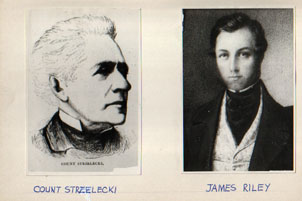
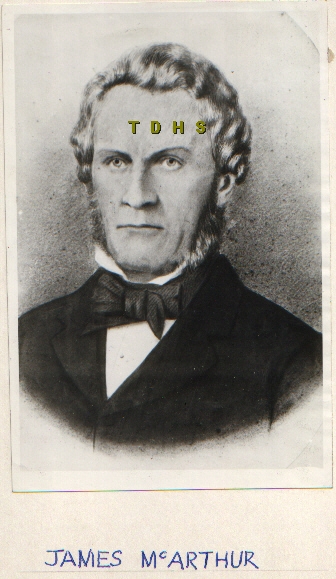 In the year 1840, some squatters near where our Federal Capital of Canberra now stands, thought that they would like to see if there was any good land further on past Omeo. Their names were James McArthur and James Riley who was only a lad of 19 years. They had a blackfellow with them called Charlie Tarra. There was a very learned man named Count Strzelecki, a scientist, who had heard about their journey, and he asked to come along, too.
In the year 1840, some squatters near where our Federal Capital of Canberra now stands, thought that they would like to see if there was any good land further on past Omeo. Their names were James McArthur and James Riley who was only a lad of 19 years. They had a blackfellow with them called Charlie Tarra. There was a very learned man named Count Strzelecki, a scientist, who had heard about their journey, and he asked to come along, too.
We must always be careful how we spell his name.
So, with their two other servants, the six of them made their way right across this part of New South Wales. making for Corner Inlet. On the way, the Count climbed a mountain, the highest in Australia. He called it Mount Kosciusko, after one of the leaders back in Poland, his native land. The party reached Omeo, and from then onwards, there were no more settlers - just blackfellows in their gunyahs. They were able to follow McMillan's tracks for part of the way, and explored the country around the Gippsland Lakes, before heading west again.
They crossed the River Thomson near the present town of Heyfield, and called the river the Machonochie. They were heading for Corner Inlet, and crossed the Latrobe River about three miles east of our town in the middle of April, 1840. As they were the first white men who had ever been there, the date is a very important one for us.
Although Angus McMillan had reached this river thirty miles further downstream a year before, he did not give it a name then, but Count Strzelecki did not know this, and named the river La Trobe, after the Superintendent of the Port Phillip District, which was the part of New South Wales around Melbourne. The river has kept the name La Trobe, although nowadays we usually write it Latrobe.
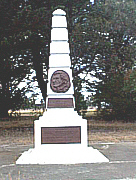 PHOTO: of the Strzelecki monument - probably you have passed it many times!
PHOTO: of the Strzelecki monument - probably you have passed it many times!
If we go out on the Princes Highway three miles on the way to Rosedale, we will find a monument on the right side of the road. It marks the place where Strzelecki, McArthur and Riley passed through away back in the year 1840.
Pushing on to the south, Strzelecki and his companions soon found themselves climbing the hills near Koornalla, and it was quite impossible to get through the huge trees and over the big logs with their four horses. They had to leave them here, and the Count decided to make straight for Western Port where they knew they would find settlers. He guided the party in a straight line up and down the ranges, and they were all very lucky that they did not die from starvation and exhaustion before they reached Western Port at last, after twenty two days in the forest. They even ate koalas when their food was all gone.
When they reached Melbourne, Strzelecki reported his discoveries to Governor Gipps in Sydney, and he even called the new country Gipps' Land in honour of the Governor. And we are still proud to call it Gippsland, although we now make it all one word.
How did Traralgon look to the Count and his companions ? The La Trobe River ran through a morass three miles wide in places, full of thick scrub and rushes. But on the higher ground there was a beautiful red gum forest, and plenty of kangaroo grass. And all the ranges were covered in forests of big gum trees like the few we have left in Bulga Park. There were not many blackfellows in this part. There were more eels, fish, ducks and kangaroos around the Gippsland Lakes, and that is where most of the blackfellows lived, although they would visit the Traralgon area at times. They called themselves the Briakolung or "Men of the West" , and their leader was a huge fellow named Bungaleene. They believed that a spirit called Loo -errn lived on Wilson's Promontory, and that deadly yellow snakes lived near Mount Baw Baw where there was also a boiling pit into which you would be sucked if you went too far in that direction.
Soon after their arrival in Melbourne, another party went back to get the horses, and the Count's specimens which he had collected on his journey. James Riley and John Rutledge took with them Charlie Tarra and a New South Wales blackfellow called Pigeon. They left in June, and were back in Melbourne by August, 1840. They found only one horse alive out of the four, and found that the country where they had been left was without water, and this in the middle of winter. We think that the horses must have been left in the ranges between Koornalla and Jeeralang, but of course we are not sure. All we know is that this party went along the line of the Princes Highway in both directions, and were the first white men to do so. There were some settlers this side of Dandenong, but none at all once they entered the forests near the Bunyip River.
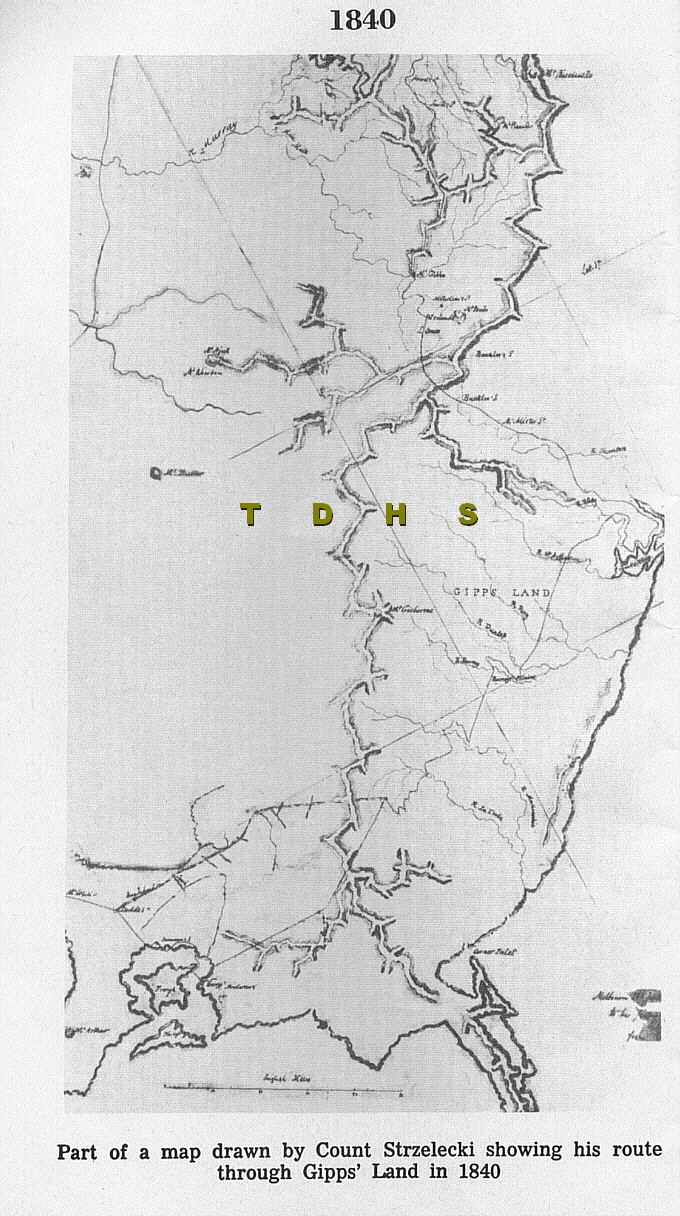
PHOTO: map drawn by Count Strzelecki showing his route through Gipps' Lane in 1840.
When Count Strzelecki's story was told in Melbourne, some settlers there decided that they would go to Gipps' Land and see for themselves, and take up land there. They thought that the easiest place to reach by sea would be Corner Inlet. They joined together and called themselves the "Port Albert Company". They were going to this new port, and being loyal subjects of the Queen, they called it Port Albert after Prince Albert who had married their Queen Victoria a few months before.
They sailed round to Port Albert in a little steamer called the "Singapore" at the end of 1840, and, after landing in this part which had never been visited before by white men, built huts and storehouses. This was the first settlement in Gipps' Land. When Angus McMillan made another journey down from Omeo, he was surprised to find them there when he reached Corner Inlet.
Early in the year 1841, these people at Port Albert divided up into three parties. Some went back to Melbourne in the "Singapore" , some decided to walk back to Melbourne, and three men stayed behind to look after the settlement. We are interested in the men who walked back through the bush.
We have their names - W.A. Brodribb, Alexander Kinghorne, Kirsopp, Norman McLeod, Malcolm MacFarlane and Charlie Tarra, the blackfellow who had been with Strzelecki. They followed the track which had been marked by Angus McMillan on his way down to the coast some months before, and had a really good look at all the country around the Gippsland Lakes, before setting out for Melbourne. They travelled along the north side of the La Trobe River on 2nd April 1841. We must remember that date too, and that the men from the Port Albert Company probably had a better view of Traralgon across the river, than Strzelecki and his party had out at Loy Yang. It seems that these men crossed the Tyers River and they called it the Kinghorne. They then crossed the La Trobe to the Morwell side, and must have gone past the place where Morwell now stands, because they called the Morwell River the Kirsopp.
During the year 1841, the little settlement at Port Albert grew bigger. Among the newcomers was Glengarry, the Scottish Highland Chief, who arrived with 23 servants. But there were 3 other men who decided to travel through the bush from Port Phillip to see for themselves if they could drive cattle into the new country. Their names were Albert E. Brodribb, Edward William Hobson, and Dr. Edward Barker. We must remember these men, especially Edward Hobson, for he was the first settler at Traralgon. Edward Hobson was a squatter near Arthur's Seat , where Dromana now stands, and Dr. Barker had his run next to Hobson. One of the leading doctors in Melbourne in those early days, was Dr. Edmund Charles Hobson, a brother of Edward Hobson. He was one of the gentlemen who founded the Melbourne Hospital. In June 1841, Brodribb, Hobson, and Dr. Barker with four blackfellows from Western Port, made the journey to Port Albert, and, so far as we know now, came through the Traralgon area, and then cut across through Rosedale to get to Port Albert. They ran out of food and nearly died of starvation, and decided that they had no hope of bringing in their cattle along the line where the Princes Highway runs today. They went back to Port Phillip along the coast, and found it much easier. The track along the coast became the first way from Melbourne into Gipps' Land.
So now we have had three parties going past the site of our town. First Strzelecki in April 1840; then the men from the Port Albert Company in April, 1841, and now Hobson, Brodribb and Barker in June 1841.
Although there was quite a settlement at Port Albert by this time, and squatters were moving up into the plains around Sale, which at that time was known as Flooding Creek, there was no Government of any kind in Gipps' Land. The settlers were settling their own disputes, and trying to protect themselves from the blacks, who were spearing their sheep and cattle. In addition there were bad men coming over on the cattle boats from Van Diemen's Land where they had finished their punishment as convicts, and had been given tickets of leave. So, in 1843, Governor Gipps in Sydney named Charles J. Tyers, an officer of the Royal Navy, Crown Lands Commissioner, and told him to go to Gipps' Land to make sure that the laws were being obeyed. We will not forget his name either, for the Tyers River is named after him and so also is Lake Tyers in East Gippsland.
But it was not easy to get to Gipps' Land, as Tyers found out. He had a party of police, both black and white. The black policemen were natives who dressed in uniforms, like soldiers, and rode horses. They carried a carbine and a sword. Commissioner Tyers and his party tried to travel through the bush as Hobson, Brodribb and Doctor Barker had done, but the country was all flooded, and they were forced to go back to Melbourne. They then heard that some settlers had travelled into Gipps' Land from the Devil's River, up near Mansfield. So Mr. Tyers and his men went there, but found that they had no hope of getting over the mountains to get into Gipps' Land through the place we now call Licola. So they went back to Melbourne once again, and this time they tried to go around the coast to Port Albert, but again the country was all flooded after heavy rain.
In the end Mr. Tyers had to take a ship and sail around to Port Albert, and he left his men to follow on by land when they could. He reached Port Albert in January 1844.
His first job was to see what land each settler claimed for his run, and to make sure that all the boundaries were correct. As he had all Gipps' Land to do, he must have been a very busy man. In February 1844, he came to the station of John Reeve, called Snakes Ridge, which was the place we now call Rosedale. He found Edward Hobson there with Commissioner Powlett, who was the Crown Lands Commissioner for Western Port. They had ridden up from Port Phillip through the bush, crossing the Buneep Buneep, as it was then called, and going around the head of the Moe river.
Dr Edmund Hobson had already put his name down for a run on the banks of the Morwell River, and it seems that his brother Edward, acting for him, picked instead 25 square miles where the Traralgon Creek ran into the La Trobe River for a run. He must have been told by Mr. Tyers that the run was his, for he returned to his own run at Arthur's Seat to get his cattle ready for the long drive to Gipps' Land.
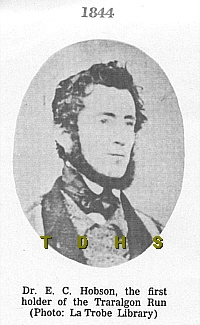 PHOTO: Dr Hobson in 1844
PHOTO: Dr Hobson in 1844
The party of police which Mr. Tyers had left in Melbourne were all ready to push a new track round through the bush of South Gipps' Land to Port Albert. They had all their food and tents in a dray which was pulled by bullocks, and they waited for Hobson to join them with his cattle. He did not arrive, and they at last set out without him. They had a terrible time, and ran out of food in the ranges near Wilson's Promontory. To keep alive, they even had to kill one of the bullocks which was being used for pulling the dray.
Edward Hobson, however, was following on behind them. He left Western Port in April 1844, seven days behind the police party. He had a large mob of cattle, and another settler named Hugh Reoch had his cattle in the mob as well. They had two drays to carry their food and tents, and even then it took them two months to drive the cattle all the way to Traralgon. It was a big party of twenty men, but they still lost 240 cattle and two horses on the journey. As the Hobson brothers held a run at Tarwin Meadows near the present town of Inverloch at this time, we can suppose that they paused there for a while on the way here. There was no grass at all in the mountains of South Gipps' Land, and they had to swim their beasts across each river as they came to it. They would have come right around to Port Albert and then through Holey Plain near Rosedale to reach here.
Hobson's were the first cattle to be driven from Port Phillip into Gipps' Land, and June 1844 is, possibly, the most important date in this story, for it was the beginning of the Traralgon we know today.
In this chapter, I hope to be able to give you all a good picture of how Traralgon looked 126 years ago, and how its first settlers lived. You must remember that it was just a little corner of Gippsland, with nothing beyond but a couple of settlers and then the deep dark forest of huge gum trees, where there were a few lyrebirds, a few koalas, sometimes a few wandering black fellows, and not a blade of grass to feed horses or cattle, and Melbourne up to a week's ride away on horseback, especially when the creeks and rivers were in flood in the winter time.
When Edward Hobson reached here in 1844, he was able to take up the run for which his brother, Dr. Edmund Hobson had applied in Melbourne. He took the land on both sides of the Traralgon Creek and his run went from the river out to Traralgon South and two and a half miles west from the creek towards Morwell. Another squatter named James Rintoul had taken up a run where Sheepwash Creek runs into the Latrobe River. He called his run "Loy Yang".
It must have been the Hobsons who gave the Traralgon run its name. The name comes from the aboriginal words "Tarra", meaning a river, and "Algon" meaning little fish, and that is why I have called this story "The River of Little Fish". It was probably Edward Hobson who spelt the name as we spell it today, for the Doctor, who did not come up to see the run for three years, spelt it "Tralgon" when he was writing a letter to his wife in Melbourne while he was here.
There are other places still carrying native names here. "Loy Yang" means Big Eel after the huge Conger eels which were once very plentiful in the river. "Koornalla" means Running Water, but that name was given to that place only early in the 20th century. At the same time, Le Roy was named after Roy Lee, the son of a farmer in that area. Then Flynn's Creek, which was first spelt "Flinn's Creek", was named after a police officer named Flinn who was at Alberton in 1848. And Callignee was given its name by the Tanner family after a place in Ireland. You have already read that Tyers was named after Commissioner Tyers, the Chief Government man in Gipps' Land. Glengarry was first called Eaglehawk, and it was many years before the name was changed.
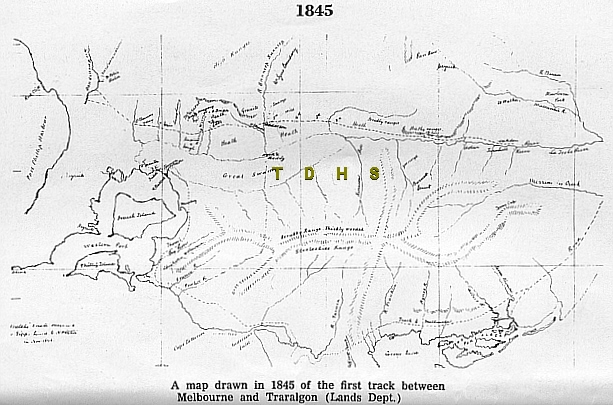
PHOTO: map drawn in 1845 of the first track between Melbourne and Traralgon. (Lands Dept.)
When he arrived, Edward Hobson's first job was to build himself a house. Of course, he had to have water nearby, and it was rather difficult to find good dry land anywhere near the creek or the river, there being such a mass of rushes and scrub along both banks. So he picked a high piece of ground near where the creek runs into the river, and near a large waterhole. The waterhole is still there but it is often dry in these times, now that the farmers have cleared and drained the creek flats, but in those days it was full of water, and as there were no tanks to hold water, water from the waterhole was used in the house.
If you turn left off the Princes Highway down Park LanFeaglee, you will eventually reach the farm of Mr. Jack Gilmour. The big dry waterhole is right near his house, and Mr. Gilmour can point out a spot on the bank of the waterhole where there is a lot of broken crockery mixed up in the earth. It is here that it is thought Hobson had his house. Rev. Francis Hales, who called there in 1848, wrote: "His house is very small, formed with wood and lined with packing cloth", and Mrs. Fanny Perry, who was here in 1849, tells us that it was weatherboarded and had a roof of stringybark. Further around the waterhole there is a hole in the ground, which might have been a well in those far off days. One of Mr. Gilmour's boys found an English penny with the date "1847" on it, near where Hobson's house stood.
It must have been lost by Edward Hobson or one of his visitors.
And who were the Hobsons? I can tell you for there is quite a lot about them in the old books. They were both Australians. They were born in Parramatta near Sydney, Edmund in 1814, and Edward in 1816, but were brought up in Van Diemen's Land, where their grandfather was a government doctor. Hobson's Bay was named after Captain William Hobson who brought Governor Bourke from Sydney to Port Phillip in 1837 on board H.M.S. "Rattlesnake", and he was a cousin of the father of our two Hobsons.
Edward Hobson started off life as a sailor on a small sailing ship which traded between Van Diemen's Land, Swan River (as Perth in Western Australia was called), New Zealand, and Port Phillip. In 1837 about eighteen months after Melbourne was founded, and he was about 21, he brought a flock of sheep and some cattle to Port Phillip where he settled. His run, which he called Kangerong, was near Arthur's Seat as I have already told you, and he was the first settler to that part. The long flat stretch where Dromana now stands was called Hobson's Flats. He also had all the land from Rye to Point Nepean, and he called this run Tootgarook.
Edmund Hobson was two years older than Edward. He studied to be a doctor in Hobart, and then went to London and later to Germany, where he passed his examinations. He came back to Van Diemen's Land in 1838 as a doctor. Sir John Franklin was the Governor of Van Diemen's Land at that time, and Dr. Hobson went on an overland expedition from Melbourne to Sydney with Lady Franklin in 1839. In 1840 he came to Melbourne to live, and son became one of the chief doctors here. As I told you earlier, he was one of the doctors who founded the Melbourne hospital. He seems to have used some of his money in dealing in cattle, which he kept on runs managed by his brother Edward. The Hobson's little schooner was called the "Rosebud" and she was wrecked in Port Phillip in 1840 where the town of Rosebud is nowadays. That is how it received its name. The Hobson's had a part in naming other places too, but as this story is about Traralgon, I will let those stories remain for another day.
Hobson's run had an area of about 19,200 acres. "How much land is that ? " you ask. Well, it is really 30 square miles. Five miles along the Latrobe River was the north boundary, reaching half way to Morwell on the west, and out to the dry creek beyond the Maffra railway line on the east, and the run went out south, to where the good land stopped and the ranges commenced. The Traralgon run was thought to be good enough to graze 1,600 cattle, or 12,000 sheep.
James Rintoul, although he wrote his name "Rentoul" - maybe he was not as good at spelling as you are - was Hobson's neighbour on Loy Yang run. He was a stockmen for a squatter named Pearson whose run was near Kilmany, and maybe, the 700 cattle he had grazing on Loy Yang belonged to his boss. Loy Yang is still pronounced "Low Yang" and I think this is the way it was pronounced at this time, for you will find it spelt "Low Yang" in some of the old Government books.
This run was not quite as large as Traralgon run. It contained about 16,000 acres, which is just 25 square miles. The books do not tell us how many cattle it could take- they just show 6,000 sheep.
It was not long after Edward Hobson's arrival at Traralgon that more squatters arrived seeking more land, and they had to go further on towards the Haunted Hills where the grass finished and the forests began. William Bennett and his brother-in-law, Albert Brodribb, with the help of Hugh Reoch, picked out a run on the Morwell River, with the north boundary along five miles of the La Trobe River. Hobson's friend, Hugh Reoch, pronounced "Roach" tried to get this run for Dr. Jamieson, a squatter in Western Port, but he gave it up in favour of Gorringe.
Hobson soon had an acre of land ploughed up ready for a spring sowing, and then set off for Melbourne in November to bring in some more cattle.
Soon after he left for Melbourne, some visitors called. They were Alick Hunter and three friends, and they had ridden right over the ranges from Devil's River near Mansfield looking for more runs. Of course they were disappointed to find Hobson away, but Hugh Reoch was there. He was living at Hobson's until he could get his own huts up on the run he had selected for Dr. Jamieson. Alick Hunter, Reoch, and two of the others cut a big log five feet through and dropped it across the La Trobe, and then went exploring the bush towards Mount Baw Baw. They saw plenty of huge tree ferns and lyre birds. On their return to Hobson's, they took their horses and rode up to Morwell to see if there was any more country left. Of course they could not have the land already picked by Bennett and Brodribb for themselves and Gorringe. They crossed to the far bank of the Morwell, and spent some hours exploring on foot. When they returned they found that three of their horses had escaped. So they put four saddles on one horse, and walked back to Hobson's to find one horse had reached home before them.
Alick Hunter kept a diary, and he tells how, while they were out looking for a run and were camped on the bank of a creek at night, they were awakened by one of their dogs barking. They immediately moved out of the glare of their camp fire, and could see at least one blackfellow hiding in the reeds. Hunter knew that his pistol was well loaded, so he told Reoch to fire first. As he expected, the pistol had to be fired a couple of times before it went off, and Reoch missed the blackfellow. The blacks then coo-eed to each other, and then disappeared, and all that Hunter and Reoch could do was lie down near their horses in case the blacks tried to spear them. Next morning they found that one of their dogs had been speared, and they felt that, if the dogs had not given the alarm, they, too, would have been speared.
This is the only story I can find where the blacks attacked the settlers hereabouts. All this happened while Hunter was on a journey across the river near Glengarry where he thought there would be some good land for a run, so I think they must have been camped on a creek over towards Toongabbie when the blacks attacked them. Hunter decided to put his name down for this land with Mr. Tyers in case he could not find any better land over the Tarwin River in South Gipps' Land.
At this time, there were many swamps and morasses where we now have streets of houses. All the flat area around Mitchell Street, was a swamp, and if you wanted to cross the creek from Hobson's you would ride up to the first bit of high land, which was near the Long Bridge. It was just below here that the first bridge was built over the creek, and it was known as Hobson's Bridge.
The year 1845 saw the arrival of the cattle of Brodribb and Bennett and also Gorringe. Brodribb and Bennett took their cattle to Hazelwood run, and Gorringe occupied his new run next to Hobson. He called it Mary Ville, and the town of Morwell is now standing on part of his run. Hobson also drove a second mob of cattle around though South Gipps' Land to his Traralgon run.
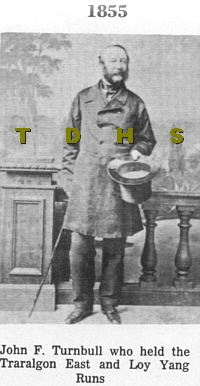 In April 1845 John Fowler Turnbull bought Loy Yang run from James Rintoul. Turnbull was really the chief man in the Traralgon area for many years, and we must remember the part he played in our little village, just as much as we do Edward Hobson. He was a Scotsman who went to New Zealand first, and came over to Port Phillip in 1838. He and his brothers were wealthy men, and were big traders in Melbourne in those early times, and were also interested in Port Albert. He took up several runs for his cattle, and for a time, was a partner with Hugh Reoch. He was a storekeeper at Port Albert when he first came to Gipps' Land, and then he had a run near Flooding Creek (Sale) before coming to Loy Yang.
In April 1845 John Fowler Turnbull bought Loy Yang run from James Rintoul. Turnbull was really the chief man in the Traralgon area for many years, and we must remember the part he played in our little village, just as much as we do Edward Hobson. He was a Scotsman who went to New Zealand first, and came over to Port Phillip in 1838. He and his brothers were wealthy men, and were big traders in Melbourne in those early times, and were also interested in Port Albert. He took up several runs for his cattle, and for a time, was a partner with Hugh Reoch. He was a storekeeper at Port Albert when he first came to Gipps' Land, and then he had a run near Flooding Creek (Sale) before coming to Loy Yang.
Another settler who came here towards the end of 1845 was Maurice Meyrick. The Meyricks were friends of Hobson. There were three of them. Alfred and Maurice were brothers, and their cousin was Henry Meyrick. Henry Meyrick wrote some very interesting letters to his people at home in England while he was staying at Hobson's and they have all been kept for us to read, and are in the La Trobe Library in Melbourne.
Maurice Meyrick thought that there was enough room for him to squeeze in between Traralgon run and Hazelwood run, but he had to get out, and Hobson let him run his sheep on Traralgon run while he looked for another place for them.
In Gipps' Land, everybody looked to Port Albert for everything. There was only one road, and that was a track that led from Longford to Port Albert. You could cross the Glengarry River, as it was called there, by boat, and swim your horses, and ride on into Flooding Creek, and then on to the Mitchell, as they used call Bairnsdale. Or, if you were coming to Hobson's, you turned off at Longford, and came along the south side of the river through the various runs. Beyond Hobson's there were just the two runs of Mary Ville and Hazelwood, and then bush for miles. Few people would think of trying to ride through the forest to get to Melbourne.
It was much easier to go to the Port, and take a ship, if one was here, or to ride on through South Gipps' Land. However, in November 1845, a party of the black police on their way back to the station at Dandenong, marked a road through the bush to Melbourne. In marking the track they would have blazed trees here and there by chipping off a large piece of bark. They kept to the north side of the River La Trobe until they reached the Moe area. Here they crossed to the south side and found a way though all the fern gullies, and eventually reached the runs of the settlers down near Mount Ararat.
Everyone was pleased that a direct road had been found into Gipps' Land.
The settlers in Gipps' Land were trading by selling their cattle to the butchers in Van Diemen's Land, where there were so many convicts and soldiers to be fed. Cattle were worth about £3 each if sold in Port Albert, but could get £4 or £4.10.0 in Van Diemen's Land, so it was well worth sending the cattle across Bass Strait in the cattle boats. Hobson did not own all the cattle on the Traralgon run. He was grazing quite a number for a Melbourne Bank, and would be paid at so much for each beast for each month's grazing, and, when ready to be sold, they would be driven over to Port Albert and then shipped off to Van Diemen's Land.
It was at about the end of 1845 that people came to live where our town stands today. Thomas Windsor and his wife, Elizabeth, and their two small children, Thomas and Eliza, came here from Holey Plain near Rosedale, and built a house on the high ground where the Methodist Sunday School is now built. When he first came here, Windsor was employed as an overseer by Hobson. His house would have been just as rough as Hobson's, for there were no sawmills to cut boards, no iron for the roof, and no tanks for the water. So you can picture it with its red gum slab walls, stringybark roof and earth floor.
Early in 1846, Henry Meyrick set out from Port Phillip for Gipps' Land with his sheep. He came round through South Gipps' Land like all the others, and left his cousin Alfred in Melbourne to collect their cattle and to follow on. Henry had, as one of his assistants, a young fellow called George Eagle, about whom I will tell you more later. Eagle also had 200 sheep in the flock. The Meyricks had decided to take up two runs on the Macalister River called Glenmaggie and Glenfalloch. Of course you have heard of those names even today.
Well, Henry Meyrick eventually reached Hobson's with his sheep in April, and in his letters he tells his brother in England how he has lived under a tarpaulin for the last twelve months. The way of making a camp in those days, was to throw your tarp over your dray, and you had a ready made home. He had three flocks of sheep, one each Alfred, Maurice, and himself - but he had only had one man to help him look after them. He had 1500 lambs born to his sheep in 1846, and 1350 of those lived!
The direct road into Gipps' Land was now being used by the police parties, and they could make the journey from the La Trobe River, which really meant Hobson's, to Dandenong in three days. Up until this time, there was only one post office for the whole of Gipps' Land, and that was at Alberton, and the letters used to be sent away from there by sea. As there were seldom any ships calling at Port Albert other than the cattle boats going to Van Dieman's Land, the mail to and from Gipps' Land used to be sent through Launceston, and it often took up to six weeks for a letter to go from Port Albert to Melbourne by that way. When the police found that the way into Gipps' Land was so easy along the new track, they started to carry the mail as well, and also the money for the Treasury at Port Albert.
There was very little spare money about in Port Phillip in those times. People used English money - sovereigns, half sovereigns, shillings and pennies, and the banks in Melbourne had their own different bank notes. But up at Hobson's and on the other runs, there would often be no money at all with which to pay for goods or for work done. So, instead of writing a cheque on a bank - there was no bank at all in Gipps' Land then - the settlers would write out a piece of paper like a cheque, which was called a bill of exchange, asking the Turnbulls or one of the other storekeepers at Port Albert to pay the man who handed it over the counter so much in real money, and to charge it against the settler's account.
There are quite a number of those old "shin plasters" as they were called, still in the La Trobe Library in Melbourne.
In his letters home, Henry Meyrick tells how the settlers around here went out hunting for blacks, whom they shot. He also tells that his cousin Maurice and Gorringe from Mary Ville, who were out with such a party, refused to fire on the blacks. Henry wrote that if he caught a blackfellow actually killing his sheep, he would shoot him, but he could not shoot the poor blacks just for the fun of it.
Henry Meyrick kept the sheep on Hobson's run during the winter, and decided to go on to his runs up the Macalister after the shearing in the spring. But, on 31st July, 1846, death came to Hobson's. George Eagle and Henry were working together when about four o'clock in the afternoon, Eagle felt ill and lay down. He died within an hour. Nowadays we think he may have been bitten by a snake, but it was in the wintertime and there should have been no snakes about. Henry thought he had burst a blood vessel. Henry and Hobson got some boards to make a coffin, but when they went down the next day to where he had died, they found the poor fellow's body in such a condition that all they could do was put him between some sheets of bark and to bury him where he lay. If you are allowed to pass through Mr. Gilmour's farm, and go down onto the creek flats, you can see his grave.
For over one hundred years there was just a grassy mound, and nothing more to show that there lay George Bolton Eagle, the first pioneer to die here at Traralgon, far away from his home in England, with just his two friends here, Edward Hobson and Henry Meyrick, to bury him.
Alfred Meyrick had finished all his business in Melbourne, and he too, came to stay on Hobson's run. He was a sick man and poor Henry had to do the shearing almost on his own. He sheared nearly 4,000 lbs. (1820 Kg) all by hand. Maurice Meyrick gave up trying to make a sheep station up near Glenmaggie, and took up a run near the Mitchell River instead.
Edward Hobson married his cousin Marie Napper on 9th September, 1846, and so there was now a lady living on the Traralgon run. You can see his marriage certificate in the office of the Government Statist in Melbourne. Hobson belonged to the Congregationalists, and he was married down at Point Nepean on his old run. He gave his address as La Trobe River, Gipps' Land, and it seems that the name Traralgon still meant nothing as an address.
But Alfred Meyrick was still a sick man, and all the work of looking after the sheep fell on Henry. As soon as the sheep had been shorn, the Meyricks rode up to have a look at the Glenmaggie country. They had been offered £200 for the Glenmaggie run, and they hoped to be able to exchange their run for one in flat country.
It was about the end of the year 1846 that William Windsor was born at Traralgon. He was the first white child born here, but we have no record of his birth. You see, people did not have to register the births of their children until 1853, and unless babies were baptized by some minister or priest who wrote the baptism in a church book, there is no way we can find out anything about the births of children like William Windsor, for there was no church at all in Gipps' Land at this time. We know that Rev. Pryce from the Church of England at Bombala came down into Gipps' Land on a short visit at about the end of 1846, but he would not have come over to such an out of the way place as Hobson's. But what we do know is that William Windsor died at Bairnsdale on 28th June, 1917, and he is probably now lying in an unmarked grave in the cemetery there - nothing to show that there lies Traralgon's first son.
On 14th January, 1847, John Fowler Turnbull, from Loy Yang, married Anne Macarthur in Melbourne. They were Presbyterians, and, no doubt, Mrs. Turnbull, like Mrs. Hobson, made life in the bush much better living for her husband.
Henry and Alfred Meyrick had hoped to buy the Traralgon run from Dr. Hobson. It was up for sale, and they sold their run at Glenmaggie only to find, on going to Melbourne, that Dr. Hobson would not sell.
Crown Lands Commissioner Tyers had found a better road to Melbourne. Instead of going along the north side of the La Trobe, it started at Hobson's Bridge, and ran along our "Old Melbourne Road" to the "Morewill". Here his men had built the first Morwell Bridge.
From there it ran over the Haunted Hills to reach the mouth of the "Naracoon" where it flowed into the La Trobe. His men were building the first bridge over the Moe, and from there his line of road ran over the ranges which lie between the Moe Swamp on the left hand, and the La Trobe River on the right until it eventually reached the station of a settler named Anderson, on the Bunyip River. This new line of road is important, for after this time in March, 1847, travellers started to ride through the bush between Gipps' Land and Melbourne. When these people came to Traralgon, if they did not camp out, they would stop for the night at Hobson's at Traralgon, or Turnbull's at Loy Yang, for there was no Travellers' Rest or Inn here yet. They could drive a gig as far as the Moe, but from there to the Bunyip River, it was just a bridle track through the bush. You could not go on at night, for your could not see the marked trees in the dark, and if you were still in the bush when night fell, you had to camp there until daylight came and you could see your way again.
Mr. Tyers had the help of Hobson and Brodribb in finding the last part of his line of road down at the Bunyip end. Hobson must have been a good bushman when we remember how he made those early rides through the forest soon after Strzelecki went through.
After leaving Glenmaggie, Henry and Alfred Meyrick went to live for a while with the Desaillys at their station on the Thomson River. It was here that in May, 1847, a further tragedy occurred. Mrs. Desailly became gravely ill, and Henry insisted on riding all the way to Alberton to get a doctor, there being none anywhere else in Gipps' Land at that time. The Thomson River was in flood, and in swimming his horse across, he drowned. A coffin was made for his body when it could be found, but poor Mrs. Desailly died a few days later, and his coffin was used for her. His body was found later and was buried on the banks of the Thomson River.
Two of our more important settlers were now made Justices of the Peace. Across the other side of the La Trobe there was a run called Rosedale - not where the town of Rosedale is now, which was called Snakes Ridge run, but on Rosedale Creek. The settler here was David Parry Okeden, and he was made a J.P. in August, 1847. Hobson was made a J.P. in September 1847, and his address is still given as La Trobe River.
It was in October, 1847, that Dr. Hobson first came to Traralgon to see his run. Edward Hobson's first baby, Teddy, was born at about this time, and maybe that is why the Doctor was here. He wrote a letter to his wife, and spells the address "Tralgon". I will now tell you part of what he wrote:
"The country is by no means an interesting one, being very thickly timbered, except on the banks of the rivers, where the plains are extensive and exceedingly rich. On my run I could plough 1,000 acres of the richest soil in the world without cutting down a tree. In sight of the hut there is a splendid mountain, now white with snow, rising to the height of 5,000 feet, to which, if I have time, I am very anxious to go before I return."
We know that he was looking at Mount Baw Baw. He wrote his letter so that the Black Police, who were supposed to call next day on their patrol through Gipps' Land, could take it to Melbourne for him.
Superintendent Latrobe, who was in charge of the Port Phillip District of the colony of New South Wales, told Governor Gipps in Sydney that he was going to inspect the new road into Gipps' Land. It was in November, 1847, and he had a party of the Black Police with their white officers with him. When they were on the track between the Moe and the Morwell, it became dark and started to rain, and even the Queen's Superintendent had to sleep that night in a tree.
But, on 29th November, 1847, he arrived at Hobson's, where Mr. Tyers and Brodribb met him. Superintendent Latrobe went on to John Reeves Snakes Ridge run the next day, and back to Hobson's again for the night. Can you just imagine Mrs. Hobson entertaining the head man for all Port Phillip in her humble home. You see, there was no place to stay between Anderson's hut on the Bunyip and Hobson's, unless you turned off at the Morwell Bridge and rode south of the track for four miles over to the Bennett's at Hazelwood.
Alfred Meyrick, who was now living at Alberton, was also thought to be a worthy citizen, for the Governor made him a Justice of the Peace in December, 1847. Hobson sometimes sat in Court as a J.P. There was a Court at Flooding Creek and another at Alberton, and he sat at both places on occasions, and Alfred Meyrick also sat in the Court at Alberton. It was nearly thirty years before a Court was opened here at Traralgon. The chief squatters were usually made J.P.'s and the Government relied on them together with the Police Magistrate to hold Courts to punish people who broke the law and to settle other disputes.
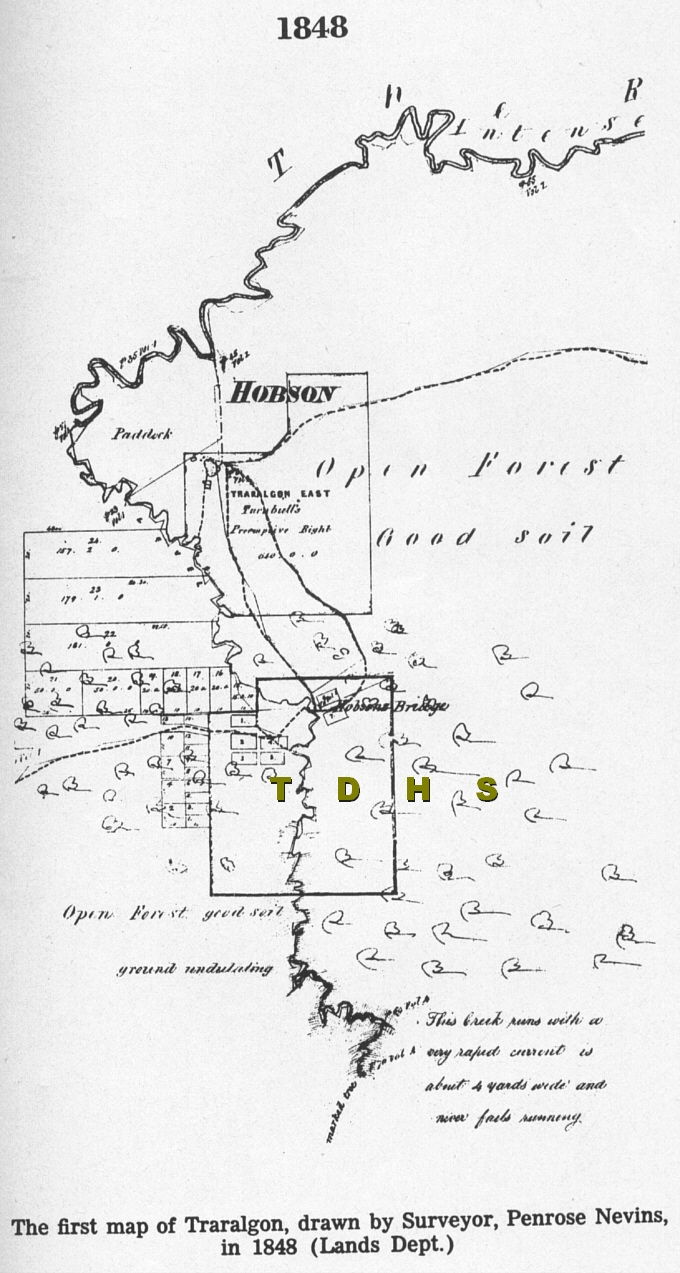 PHOTO: map of Traralgon drwan in 1848 by surveyor Penrose Nevins. (Lands Dept.)
PHOTO: map of Traralgon drwan in 1848 by surveyor Penrose Nevins. (Lands Dept.)
Another sad event occurred on 4th March 1848. Dr. Hobson, who had been a sick man for many years, died at his home in South Yarra. His death came as a great shock to all the citizens of Melbourne, who thought much of him, for he was only 33 years of age. He was buried in the Old Melbourne Cemetery, which was removed some years ago to make room for the Victoria Market. A beautiful monument was erected over his grave, and when his body was removed to the Fawkner Cemetery, the monument was re-erected over his grave there for us all to see.
After Dr. Hobson died, the gentlemen who had been named in his will to look after his property, continued to hold the Traralgon run for the next five years. Edward Hobson still lived here and managed the run.
In April, 1848, the first Minister of any Church visited Traralgon. He was Rev. Francis Hales of the Church of England, and set out for Gipps' Land on horseback from Melbourne. He was told to carry pistols for protection against the blacks, but he would not do so. He rode up as far as the Bunyip River in company with other travellers and, on the way, stayed the nights at the homes of the settlers, but there was still fifty miles of silent bush through which he had to ride alone before he reached Hobson's.
After he crossed the "Narrikan" River, it began to get dark, and he dismounted so that he could still feel the notches in the trees marking the track. But he eventually had to camp the night alone in the bush only thee miles from Hobson's. Next day was Sunday, 9th May 1848, and he found Mr. and Mrs. Hobson out, but their servants were there, and they made him comfortable. The Hobsons returned later in the morning with their little boy Teddy, who was now six months old. That afternoon, when all were together, Rev. Hales held the first Church service ever at Traralgon. He went on up to Flooding Creek to see the people there about getting a Church for North Gipps' Land, and he called at Turnbull's at Loy Yang. He had tea at Crooke's at Holey Plain, and then pushed on in the dark to stay with the Desaillys on the Thomson River. And do you know that the Crooke family still hold Holey Plain after 120 years ?
Rev. Hales came back this way at the end of the month, and stayed at Hobson's for a couple of days. Then he left for Melbourne, calling to stay with the Bennetts at Hazelwood. On Sunday, 4th June, he held a Church service there, the first ever in the Morwell district.
When you post a letter in Traralgon nowadays, it is delivered in Melbourne the next morning. But back in 1848 it was not like that. I have told you how the letters were carried along the bush track by the Black Police. But, in July 1848, the Post Office people started a mail service once a fortnight, right through to Alberton. The mailman left Melbourne on horseback at midday on Tuesday, and reached Alberton at midday on the following Saturday. The return mail left Alberton at midday on the following Thursday, and reached Melbourne on the following Monday at noon. If the mails were heavy, they would be carried on a packhorse. Any stranger travelling through the forest would wait and ride with the mailman in return for a few shillings.
But there was only one Post Office for all of Gipps' Land, and that was at Alberton. But in September, 1848, a new Post Office was opened at Flooding Creek, and the people of Traralgon could have their letters sent there instead of having to collect them at Alberton.
In July, 1848, a daughter was born to the Turnbulls. She was called Margaret, and was baptized in Melbourne, and I cannot tell you whether she was the first girl born in the Traralgon district, or not, because the old books do not show it. She may have been born in Melbourne. The Hobsons also had a daughter Margaret who was born in December 1848, but she died when only eleven weeks old. She was probably born in Melbourne for she was baptized there , and when she died, was buried there.
The Roman Catholic Church first came to Gipps' Land in December 1848. Bishop Goold, who came to Port Phillip in 1848, decided to send Father Kavanagh from St. Francis' Church in Melbourne to tour Gipps' Land, and I have seen the old books of this Church where all the marriages and baptisms are written down. From these I can tell how Father Kavanagh went right through Gipps' Land, where he baptized 21 children and performed two marriages. These were all in South Gipps' Land, so Father Kavanagh may have taken the South Gipps' Land road. There were few Roman Catholics in Gipps' Land in the early days, most of the settlers having come from England and Scotland. Father Kavanagh went up as far as the Mitchell River before he returned to Melbourne early in 1849.
In January, 1849, Rev. Willoughby Bean, the first Church of England minister to be stationed in Gipps' Land, visited Traralgon when he was having a look at all the country that had been put under his charge. His church was to be at Tarraville, over near Port Albert, but that did not stop him from riding his horse everywhere to see that people who belonged to the Church of England. He visited Mr. Okeden, who had his run at Old Rosedale, as I have already told you, and then they rode their horses through the ford over the River Latrobe. When they reached Hobson's, they found that he had gone to Melbourne with Mrs. Hobson, and that Brodribb, who had been left in charge, had gone over to Bennett's at Hazelwood. He stayed at Hobson's that night, and rode over to Bennett's in three hours the next day, and stayed the next night with them. On his return to Hobson's he was promised that Hobson's gig would be ready for Bishop Perry and his wife, who were coming to Gipps' Land.
He then rode on to Turnbull's, and he wrote in his diary that it was a "neat little cottage, too near the morass, but altogether a more English-looking place than any I have seen in Gipps' Land." The Turnbulls were also away in Melbourne, so he rode on to Snakes Ridge run, and stayed the night with Mr. King.
In February, Bishop and Mrs. Perry came through Gipps' Land. The Bishop, who was head of the Church of England in Port Phillip, was quite an important man, so he had an escort of native policemen. Mrs. Perry kept a diary, in which she tells us all about her trip. By this time, little wayside inns had been built here and there along the Melbourne Road, and they stayed at these. Mrs. Perry rode in a spring cart for the first twenty miles from Dandenong, and they had lunch at a little inn called the "Latrobe". From here to Moe, she had to ride sidesaddle on horseback, for the road had not been made for carts - just a bridle track through the forest. They rode on for another twenty two miles, and came to the little inn on the Bunyip River, where they stayed the night. The next day's journey was through the forest to Moe, and they reached there after dark. Mrs. Perry spells it "Mowie", and Rev. Hales had spelt it "Moay". They stopped the night at the inn here, and it was a very poor place for travellers. There were gaps between the slabs which made the walls, there was a foot space, both at the top and the bottom of the bedroom door, and the window was a hole sawn in the slabs. There was no glass in the window. There was no milk and no butter - just very salt beef, bush tea, black sugar, and happily, good bread. Rev. Bean and the secretary of the Gipps' Land Church Committee met them at Moe with Hobson's gig, and they travelled in style to Hobson's the next day. Mrs. Perry wrote in her diary just how Hobson's looked when she first saw it, and I will tell you exactly what she wrote so that you can close you eyes and see the place for yourself. She writes:
"Exceedingly pretty it is, perched upon a kind of cliff, with a large lake on one side, and a very pretty deep river on the other, while the Gipps' Land ranges rise in the background. Some of these are said to be upwards of 8,000 feet in height, but I am sure they did not look higher than Ben Nevis or Cruachan.
The house is a neat little place, weather-boarded with a bark roof, as is the case with most of the roofs in Gipps' Land, bark being more easily obtainable than shingles. It has a very picturesque effect, being prevented from blowing off by four long poles placed, two horizontally, and two perpendicularly, on each side of the roof. the view from the windows was charming, and we used to see the natives paddling out in their canoes on the lake, and spearing eels."
At this time the Windsors had made their house a stopping place for travellers, and I suppose it was about as good as the place at Moe, so no wonder the Bishop and his lady stayed with Edward Hobson.
The Perrys left Hobson's a week later, and set off across country to Port Albert. When they returned early in March they stayed the night at Turnbull's. Next day they went on to Hobson's to collect their horses and to meet the Native Police escort again.
But, while they had been away, one of the policemen, called Calcheron, had thrown away his uniform, and joined up with the local blacks. The other black policeman, called Robinson, said that Calcheron was "plenty foolish". The Perrys had lunch at Bennetts at Hazelwood, and reached the inn at "Mowie" again for the night. This time the landlady had meat that they could eat, and even cream, coffee and butter for them. But they could still look out of the little square that called itself a window, and could see the Black Police sitting around their two large camp fires amid the gum trees, cleaning their uniforms and arms, ready for the next day's ride.
It was while the Perrys were at Hobson's that grief struck Edward Hobson and his wife. They were in Melbourne with their sick baby, Margaret, and she died on 5th March, 1849.
Rev. Willoughby Bean of the Church of England called at Traralgon from time to time. The Windsors were a Church of England family, and I also find that in September, 1849, Rev. Bean baptized a baby girl, Fanny Hebbs at Loy Yang. We put all these little bits together, and we end up with quite a story. Maybe Fanny Hebbs' father, William Hebbs was working for Mr. Turnbull.
I have already told you how Father Kavanagh came on a visit to Gipps' Land at the end of 1848. In January 1850, Bishop Goold decided to come to Gipps' Land himself to see about starting a Roman Catholic Church down near Port Albert. He rode up the Gipps' Land Road, and was invited by John Turnbull to stay at his station. He wrote in his diary:
"On the 4th celebrated Mass privately at this gentleman's home. There were no Catholics on the station."
This is the first record of the first Mass ever celebrated here at Traralgon.
On 11th January, 1850, a son, George, was born to the Turnbulls, a brother for Annie. I found his name down on the list of children baptized by Rev. Willoughby Bean. The Turnbulls were Presbyterians, as I have already told you, but their church had not yet come to Gipps' Land. So, when Rev. Bean was at Loy Yang in July, he baptized the Turnbull baby and also Mary Allen who had been born in December, 1849.
In March, 1850, one of the Meyricks left Gipps' Land for California to seek his fortune on the goldfields there. I do not know if was Alfred or Maurice, or if he ever came back. I also think that about this time, Edward Hobson left Traralgon to live on his other run down at the mouth of the Tarwin River near where Inverloch is now. He may have spent part of his time with his friend James Purves on his run at Tootgarook as well. From this time on, I have not found his name in any of the old letters or books, so I think that he must have moved and taken his family with him, leaving his men to watch over the cattle on the run.
When Bishop and Mrs. Perry rode through the bush in February 1849 on their way to Gipps' Land, they caught up with a dray which was being pulled by six bullocks. It was only the second cart which had tried to get in that way, and it had been many days on the road. The Perrys passed it on the Melbourne side of Shady Creek.
The road was slowly getting better each year, and carriers, with their bullock drays, were bringing goods from Port Albert, even as far as Hazelwood. I have read a letter written by Henry Scott who kept the little inn at the Moe. He wrote to Robert Turnbull, the storekeeper at Port Albert, to see if he could get a dray to come right up to Moe with stores, and he wrote that the roads were first rate. At the top of his list of goods needed was 30 bushels of oats. You see, he had to keep oats to feed the horses of the travellers, for, as I told you, there was no grass for horse feed once you entered the forest. But it was to be many years before the road was good enough for the coaches to run to Melbourne.
From the beginning of the year 1851, the mailman rode his horse along the road with the mail every week instead of every second week. Of course, when the floods were up in winter, the mailman could be held up at the many rivers which he had to cross. Where possible, he would swim his horse across and try to keep the mail on time, but the travellers would have to wait until the floods went down before continuing their journey.
When the Melbourne Road became good enough, the settlers in Gipps' Land started driving their cattle to Melbourne to sell them there. You know, of course, that gold was first found in Victoria in 1851, the same year that our District of Port Phillip was cut off from New South Wales and made a new colony, and was given the name "Victoria" in honor of the Queen. When the people in Europe, America, New Zealand and other colonies heard that gold could be found so easily, many of them came to Melbourne to go to the diggings, and Melbourne became a very busy town. All these people needed meat to eat, and the squatters in Gipps' Land found that they could get more for their cattle in Melbourne than they could in Van Diemen's Land where they had been sending them in the past. So the road to Melbourne through the forest soon saw mob after mob of cattle on the way to market there.
How far can you drive cattle in a day ? Maybe twenty miles or so. But they had to eat, and to rest too. So there would be a mob of cattle resting here in Traralgon, another one ahead, perhaps at the Morwell, and another mob coming along behind at Holey Plain. The drovers would camp out, or stay at Windsor's for the night. I found in one book, where at this time, a mob and their drover stayed at "Hobson's Old Place, Tarralgon Creek". The driving of cattle to Melbourne made Traralgon more important, because it became a stopping place for drovers instead of just a run where cattle grazed.
During the winter, the mobs of cattle could not go through because, when the floods were up, you had to swim your horse over the Morwell, Moe, and Bunyip Rivers, and the swamp at the Bunyip was about fifteen miles across.
Now, until this time, all the land here belonged to the Queen, and people like Dr. Hobson and John Turnbull had been paying £10 or more each year for permission to graze their cattle on their runs. But, in 1852, the law was changed, and if a man held a run, he could ask permission to buy part of his run from Queen Victoria and it became his forever. He was allowed to buy only one square mile - that is 640 acres. Edward Hobson applied to buy a square mile of the Traralgon run to take in the part where he had his house. But it turned out that he did not even have the lease for this run. It was Dr. Hobson's run, and when he died, the gentlemen named in his will still had charge of it. They may have let John Turnbull have it for a while.
All the cattle going through had made Windsor's Accommodation House a busy place, and it was at about this time, at the end of the year 1852, that Peter Jeremiah Smith took it over. The Windsors still lived elsewhere in Traralgon, but where their home was, I cannot say. But Peter Smith looked after the travellers in the house on the rise where the Methodist Sunday School is now.
In March 1853, the gentlemen looking after Dr. Hobson's runs decided to cut the Traralgon run into two. They called the two halves Traralgon East and Traralgon West. Traralgon East was the half of the run on the east side of the creek, and took in Hobson's old house, and Traralgon West was the half lying on the west side of the creek. They sold Traralgon East to John Turnbull of Loy Yang, and Traralgon West to Edward Hobson. Of course, John Turnbull was able to join Traralgon East to Loy Yang, and his two runs gave him all the land from the Traralgon Creek almost to Flinn's Creek.
Edward Hobson who, as I told you, was no longer living here, sold Traralgon West straight away to his friend James Purves of Tootgarook, and from now on he fades out of our story. He was in trouble with the law in later years, but you must always think of him first as the stout pioneer who came to Port Phillip when just a young man, built up his herds of cattle at Kangerong, explored the wild Gipps' Land bush, and pioneered the first run in this area.
So now I have told you in the first chapter how the settlers first came to Traralgon, and took up their runs, and in this chapter how they lived by selling their cattle in Van Diemen's Land and later in Melbourne, and how, once the mobs of cattle started going to Melbourne, Traralgon became a stopping place for the drovers. In the next chapter, I will tell you how Traralgon grew into a village and received its name.
Gold ! Gold! Gold! How that word rang throughout Victoria. Diggers were searching creeks everywhere for nuggets, and finding them, too. And then there would be another rush to the new diggings. The people here in Traralgon heard it, and Port Albert was almost deserted, all the men who could, having gone off to the goldfields in Central Victoria, like Ballarat and Bendigo. Most of them came back after a while, for the lucky ones who made the big finds were few. But they did not give up searching for gold here in Gipps' Land, and finding it too, as we shall see.
You have already read how the Churches held their first services here, but I have not told you about the Presbyterians. Nearly everyone in Traralgon was a Scot, and I must tell you about their Church. The first Presbyterian minister to be stationed in Gipps' Land was William S. Login, and like Rev. Bean, he travelled all over Gipps' Land on his pony from Sale. He held the first Presbyterian service here on 12th February 1854, at Loy Yang, and we can be almost sure that it was in Mr. John Turnbull's best room.
Now there was a Scotsman named Duncan Campbell managing a run called Mewburn Park near Maffra for a Mr. Johnson, and his brother, John Campbell, was on a station called Kilmorie up near Bruthen. These two men had been in Gipps' Land since the beginning, and, in July 1855, they came here to Traralgon. You know all about Hobson. You must now learn just as much about Duncan and John Campbell.
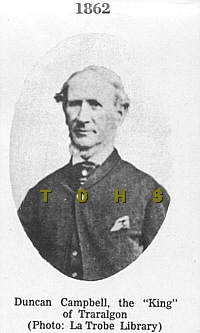 Duncan Campbell bought the Traralgon West run from James Purves. He also had another run called Gelantipy away up past Buchan. When they came here to Traralgon, they built themselves a homestead down where the Traralgon Park homestead is now, and part of the old building is supposed to still be there. And you will see how, before long, Duncan Campbell owned almost everything in Traralgon, while his brother was one of the chief drovers of the mobs of cattle that were being sent to Melbourne.
Duncan Campbell bought the Traralgon West run from James Purves. He also had another run called Gelantipy away up past Buchan. When they came here to Traralgon, they built themselves a homestead down where the Traralgon Park homestead is now, and part of the old building is supposed to still be there. And you will see how, before long, Duncan Campbell owned almost everything in Traralgon, while his brother was one of the chief drovers of the mobs of cattle that were being sent to Melbourne.
When we read the old stories of Gipps' Land, where do you think we can find them? Well, up until now they are scattered in the old books and letters. But in October 1855, the first newspaper was started in Gipps' Land. It was called the "Guardian" and they printed it over at Port Albert. It was just a little paper - one big page folded down the centre - but from this time on, you and I can find things out for ourselves by reading the "Gipps' Land Guardian". There is no "Guardian" newspaper now though. It last only until 1869, and the owner sold all his type because it did not pay to print the paper any longer.
You will remember how Edward Hobson tried to buy part of his run from the Queen, but could not do so, because the run had always been under the name of his dead brother, the doctor.
In November of this year, 1855, John Turnbull bought a square mile of his Traralgon East run, and that was the first Government land ever sold here. He got it for only £1 an acre, and the part he bought was all that corner where Hobson's old house stood.
The road to Melbourne was still all mud during the winter. Who would think of trying to ride to Melbourne that way when you could travel fifty miles over to Port Albert in comfort in a gig and then catch a steamer to Melbourne in the afternoon, arriving there the next day ? For £5 you could have a cabin, but if you could afford only 45/-, you would travel in the steerage or second class part. So the Melbourne road was still being used chiefly by the cattle who stamped the mud with their hooves and made it deeper.
In our Parliament in Melbourne, we have the two Houses, the Legislative Council and the Legislative Assembly. The Legislative Assembly was first elected in 1858, and the Electoral Roll or list of voters was printed in the "Guardian". Only men had a vote, and they had to be earning £2 a week or have a house. There were only eight men on the roll for Traralgon. They were Duncan Campbell and his men, John Blair, Alexander McCrae and John Simpson; John Turnbull and his men, William Morris and James Peck; and our old friend, Thomas Windsor. John Campbell did not get a vote - maybe because he lived in Duncan Campbell's house.
There was not even a policeman here. If anything happened, the Police at Sale looked after the Glengarry side of the river, or rather the Eaglehawk side, if we keep the correct name, and the Police away over at Alberton looked after this side. There was a bit of horse stealing going on, too, and there was talk about putting a policeman at Moe, the horse thieves could be caught easily while getting through the forest there, for there was no other way to Melbourne, but nothing was done about it.
And all this time there was not one bridge across the Latrobe river anywhere. Where it was shallow, men used to ford it with their horses. But, further down, you had to use a boat. The people at the Ridge at Rosedale used to keep a boat there for those wishing to cross. They could swim their horses behind the boat. Further down at Sale, there was a punt which was big enough to carry a horse and cart. But, in 1857, the first bridge was built across the river at Longford, although it was not really opened until May, 1858, and what a difference it made. Straight away some people in Sale started to run a coach service from Sale to Port Albert, taking two days for the journey. This was the first coach service in Gipps' Land, and people from Traralgon could now drive up to Sale through Holey Plain and Longford and catch the coach to Port Albert from where the little steamer carried them round Wilson's Promontory at night to reach Melbourne next day. It was only a five horse wagon, but it was, at least, some way to save walking all the way for those who had no horse.
When Edward Hobson left Traralgon, there was no Justice of the Peace here and, in August,1857, John Fowler Turnbull was made a J.P. As he was the leading citizen and a man of good standing, the choice was a good one, and, for many years afterwards, he helped to keep the law in our little village.
Other parts of Victoria were having railways built from Melbourne but poor Gipps' Land was so cut off by the forest that nobody could ever think of finding all the money needed to build a railway 130 miles to Traralgon and Sale. So there were many people who thought that it would be better to build a short railway from Sale to the steamer at Port Albert, the country being flat all the way. They even talked about putting down wooden rails, and if they couldn't get a railway train, they could, at least, use it for a horse tramway. The wooden rails would save pulling wagons through the mud. Gipps' Land had no stone for roads, and they even had to bring rocks over from Wilson's Promontory to make the roads around Port Albert. But you and I know that no railway was ever built from Sale to Port Albert.
At the beginning of the year 1858, the Government in Melbourne sent up a surveyor to Traralgon to mark out the township. Other surveyors had been up here ten years before, and they had drawn maps of the river showing where Hobson's and Windsor's houses were, and where the tracks went, but this surveyor marked out our first streets.
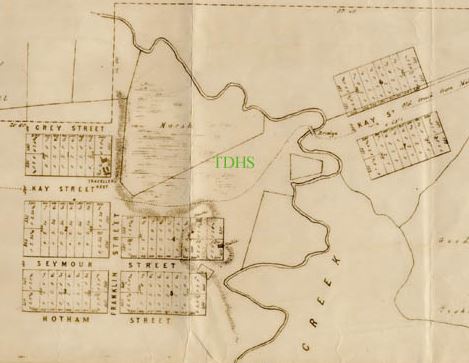 PHOTO: part of the Plan of Traralgon Township, drawn in 1858. (Lands Department)
PHOTO: part of the Plan of Traralgon Township, drawn in 1858. (Lands Department)
All he saw was just the track to Sale past the Hotel, and the rest was all open, grassy forest. So he called this track Kay Street on both sides of the creek after Captain Kay, who was a Government officer in Melbourne at that time. Cutting Kay Street north and south he marked Franklin Street out in the grass and named it after Sir John Franklin who had been Governor of Van Diemen's Land and who was lost while exploring near the North Pole. He also put in Grey Street, Seymour Street and Hotham Street, naming Grey Street after Lord Grey who had been Prime Minister of England, Seymour Street after another Government Officer and Hotham Street after Sir Charles Hotham who had been Governor of Victoria but a short while before. The map which he drew does not go past Hotham Street, and down on the Mitchell Street flat the surveyor has drawn in a big swamp. He also marked out part of the land across the bridge on both sides of Kay Street, which you now call Rosedale Road. .... All this was being done ready for the sale to the settlers of blocks of land in the township.
The most important thing in Traralgon for many years was its bridge, and each time a new bridge was built, there was an argument. about where it should go. Hobson's old bridge was wrecked by floods, and a new bridge was built some distance down stream from our present Long Bridge, which meant that travellers could not go straight down Kay Street, we call it Argyle Street nowadays, but had to turn left down the bank, across the flat, over the bridge, and to the right again to get back to Kay Street. This winding road caused the Star Hotel to be built in the wrong place some years later, and I will tell you more about that in the next chapter.
Another thing happened, too, which helped to hold up the building of a good road into Gipps' Land. A bold young man sailed his schooner across the bar into the Gippsland Lakes and right up the Mitchell to Bairnsdale where he unloaded goods, and he then went up the Tambo almost to Bruthen. This was the first time that such a thing had been done. The entrance to the Lakes was then in a different place to where you see it now when you drive down the hill into Lakes Entrance. That entrance was made by some clever engineers, but I am telling you about the entrance that the rivers used to make for themselves when the floods were up. There was nothing to stop this young fellow, Malcolm Campbell, for that was his name, from sailing across Lake Wellington and landing goods at Longford either. So why worry about a railway from Sale to Port Albert, or why worry about a road to Melbourne through the mud in the forest. If all the goods for Sale and the miners at Omeo could be brought in by sea, it would save all the money that had to be paid to the carriers who had to haul the wagons all the way from Port Albert. Anyhow, the road was so bad during this winter that the coach service had to stop until December. When the coaches started to run again, they tried to do the journey in one day instead of two. When the roads were dry they were able to get through in twelve hours.
In 1858, the biggest thing by far appeared in Traralgon. Duncan Campbell decided to build a Travellers' Rest - an hotel. He put it on the corner where the Traralgon Hotel now stands. You see, all this part of Traralgon was his run, so he picked the last piece of high ground before the track led down to the bridge over the creek. It was quite a big building for such a small place. It had a large dining room, four sitting rooms and eight bedrooms, as well as a bar and a cellar, and out in the yard were six more bedrooms, the laundry and the kitchen. It was built of red gum boards which had to be sawn here by hand as there were as yet no steam saw mills in the district. So the sawyers made a sawpit over on the Old Shire Hall corner, and there, with a long cross-cut saw, they sawed the red gum logs into boards, one man on top, and the other down below in the pit, being covered in sawdust with each cut of the saw. The cellar was built first, and the first load of grog brought up from Port Albert was drunk in the cellar before a stick of the hotel was put up.

PHOTO: the Traralgon Hotel, which was built by Duncan Campbell in 1858. (This photo was taken in about 1913).
Duncan put his relative, Peter McColl, into the hotel, and when the Court over at Alberton gave him the licence, they decided not to give any more licences to Peter Smith for his shanty on the Methodist Church corner. Of course, Peter Smith and his friends were not very pleased. but, if Duncan Campbell was ready to spend all that money, he really deserved to get the licence for his hotel, don't you think?
On his plan of Traralgon, the surveyor has drawn in the new Travellers' Rest and also Peter Smith's house, and even his stable on the bank of the creek. There were no other buildings anywhere - just red gum trees and grass and the dusty track from Morwell passing the new Travellers' Rest and running down across the flat to the bridge and then over to Turnbull's at Loy Yang.
Of course, during the winter months of 1859, the Sale to Port Albert coach stopped running again. The Old Port Road was in a dreadful state before it dried out in the spring when they started up again. So, about every ten miles or so, there was a little inn where those walking to Sale could stay each night.
The Government decided to start selling land at Traralgon now that the surveyors had finished their plans, and, on 29th August, 1859, the first land to be sold here was sold up at Sale. The Police Magistrate there was the auctioneer at these sales, and he sold all the land on the north side of Grey Street from Church Street up as far as Cumberland Park. And whom do you think bought it ? Why, none other than our old friend, Duncan Campbell. It was part of his run that Captain Carey, the P.M., was selling anyway, so he bought all that land back to the river for £1 an acre.
And all this time there had been gold prospectors trying all the Gipps' Land creeks for gold. They found gold up near Mount Baw Baw, and the news soon got around. A policeman was sent all the way from Alberton to see if it was true, and, sure enough, it was. This was in September, 1859. In telling the story, the "Guardian" said that the find was in the ranges about thirty miles from Traralgon, and just in case you have been thinking that Traralgon was well known, the paper says: "It may be as well to state for the benefit of strangers to the locality, that Traralgon is between 50 to 60 miles from Port Albert, on the main Melbourne Road." This gold discovery soon made Duncan Campbell's Travellers' Rest a busy place with those seeking their fortune calling in. They could go on to Peter Smith's at the Morwell or Henry Miller's at the Moe, but Duncan's place must have been a palace compared with the other shanties.
On 30th November, 1859, the Governor of Victoria gave Traralgon its name when he fixed the boundaries for the township as drawn by the surveyor. The spelling was now correct, and there was only one way to spell it - TRARALGON. This, too, is one of our important dates. At the end of December, the first blocks in the new township were sold by Captain Carey up at Sale. The Traralgon Hotel corner was sold with the new Travellers' Rest on it. Anyone who wanted to buy it had to pay Duncan Campbell £1,725 straight away for his hotel. That was a lot of money in those days, and there were no takers. So Duncan bought that corner for £4 for the half-acre and paid himself for his hotel. This land has been sold over and over again since then, and the hotel is now owned by the Ryan family. The name of Travellers' Rest was changed after a few years to the Traralgon Hotel, so, although the old building was pulled down fifty years ago, the Traralgon Hotel is really over 100 years old now. Police Sergeant Coleman of Sale bought the service station corner at Church and Kay Streets, and Constable John O'Connor of Sale bought Clauscen's corner. He came here the next year as our first policeman. John Campbell also bought some blocks. Captain Carey also sold the Grey Street School corner and Duncan Campbell bought it too, and thus he now owned the whole of the north side of Grey Street.
Peter Smith had left Traralgon after he lost his licence to sell beer at his place on the Methodist Church corner, and he went down to the bridge over the Morwell River and there set up another hotel of a kind. It was the first inn in that area, and those people who could not walk the extra ten miles to stay at Duncan Campbell's nice hotel would stay the night at Peter Smith's little place on the Morwell.
Early in the year 1860, it was decided that there should be a policeman here to keep order. There was a police station at Sale and one at Dandenong and not a solitary policeman anywhere between. There was no place for a policeman to stay except at the hotel or at John Campbell's house so a police station was built on the Post Office corner. It was just a small two-roomed weatherboard place with a roof of shingles, and the inside walls and ceilings were lined with calico, and here Constable John O'Connor moved in with his bride in September. His district went right down to the Bunyip River, and he had to visit the gold diggings up near Mount Baw Baw regularly to see if the miners were behaving themselves. He was a very good officer, and he was well liked by all the people here.
To get to the diggings from Port Albert, the only road for a dray was up to Longford first, and then along the river through Holey Plain to Traralgon, but you could walk or ride a horse from Stradbroke across to Rosedale and then to Traralgon, but there were no inns at which travellers could stay on the track from Stradbroke to Rosedale. Gold was being found in many other creeks running into the Tangil River. So Duncan Campbell decided to open a store at his hotel. Up until then, the nearest store to the diggings was at Rosedale. Duncan was advertising in the "Guardian" in October, 1860, that his store was the nearest to the Shady Creek diggings, and that, besides groceries, he stocked picks, shovels, tin dishes and blankets for the diggers. His best Adelaide flour was 5d. a pound.
So, by the end of these years, we have a hotel, a police station and a store. The village was growing, and, on 1st January, 1861, a post office was opened here. And who was the first postmaster? Have a guess.
Duncan Campbell, of course. He was paid but £10 a year, and Traralgon was the nearest post office to the Baw Baw, Russell's Creek and Shady Creek diggings, The post office was at the hotel, too.
The people at Rosedale were thinking of asking the Government to put a bridge across the river there, and this did not please the Traralgon people who looked forward to the day when small steamers would sail up the river as far as Moe to carry goods and passengers to the diggings, there being, as yet, no talk of a coach service here, for the coach service from Sale to Port Albert was not paying. It was bad enough having the river blocked by a bridge at Longford, and they didn't want another bridge further upstream.
Every ten years nowadays we have a census or a counting of the people. They held a census from time to time in early days at Traralgon, but the first one that tells us very much about our village was in the year 1861. There were 21 men and boys and 15 women and girls here, and they lived in the six buildings here . You already know the hotel, the police station, the Traralgon Park homestead and Peter Smith's old house. The other two places were a tent and a hut. I can count but 8 men and boys and 13 women and girls whom I know were then here, so I think that about 20 other men, such as miners and drovers and travellers were here when the count was being made.
Duncan Campbell decided to sell the rest of his Traralgon West run that had not been sold at the land sales and also his run up at Gelantipy to some Melbourne men who had other stations and from this time on, although it changed hands several times, the Traralgon West run was no longer owned by a citizen living here in Traralgon. On 31st July,1861, the first copy of the "Gippsland Times" was printed. That newspaper is still going strong at Sale. It was not the first paper there for, in January, 1861, there was a little paper called the "Independent", but the owner ran out of money and stopped printing his paper after four months. Just as you read the "Journal" today, people one hundred years ago read the "Guardian" from Port Albert and the "Times" from Sale to find out what was going on in Gipps' Land, and even now you and I can see those old papers in the LaTrobe Library in Melbourne, and can read all about things that happened here at Traralgon long, long ago.
There was still more and more gold found up near Mount Baw Baw, but the miners still had to come all the way to Traralgon if they wanted to go to the Post Office to send an important letter - 40 miles each way over a bad road.
People were still trying to find better tracks through the bush. A new track was discovered to shorten the road from Port Albert to save going through Willung and Rosedale, and down near Warragul Ken Bennett from Hazelwood and a companion found a better track than that which was being used. Their new track did not go up and down the fern gullies, and missed a lot of the swamps. We must remember this find by Bennett and his friend for, after a few years, it became possible for coaches to get through to Melbourne on this much better track.
New Year's Day, 1862, at Traralgon must have been its best day up until then, for Duncan Campbell ran a sports meeting on the Traralgon Park behind his hotel. There was even a steeplechase, and the crowd there on this day was probably the biggest ever at Traralgon up until then. Every year after that, at Christmas time, there was a sports meeting with horse races behind the hotel.
The mailman was now going through to Melbourne three times a week and the mail took only 67 hours from Sale to Melbourne - about 2½ days from Traralgon to Melbourne. Of course the mailman did not ride in the dark. Few people travelled at night in those times when there were no lights. If possible, they waited for a moonlight night.
Traralgon West run had new owners too. They still paid only £10 a year for their licence. John Turnbull was paying £15 for Loy Yang run and £10 for Traralgon East run. More and more land around the town was being sold by the Government, but often there were no people who would buy. Ben Russell bought the two corners where Henry Street runs into Breed Street - five acres on each side - for £25. But the rents of the runs were soon to go up.
It was in this year, too, that Captain Carey the Police Magistrate opened a Court at Rosedale coming there every month from Sale, but there was not enough work for him and the Court was closed down until the end of 1863. The people of Rosedale, Traralgon, Morwell and Moe must have been good citizens, for Rosedale was their nearest Court. The first bridge over the river at Rosedale was finished and now people going to Sale crossed the river there and travelled on a better track than that round through Holey Plain and over the bridge at Longford. It also meant that people going from Traralgon to Toongabbie did not have to risk fording the river - they could ride or drive down to Rosedale and go round that way.
A surveyor named McDonald found a new track to Melbourne which left the Morwell Bridge and ran along the tops of the ridges south of Moe. It was called McDonald's track, and we are still using part of it for our roads even today. It was a good winter track on which travellers would not get bogged in mud, but because it kept up in the hills, there was no water for the mobs of cattle and it never really came into use.
Gold had been found by a man named Ned Stringer on a little creek which people called Stringer's Creek after him. Later on this place was called Walhalla. There were other places up in that part, too, where there were miners seeking gold so a policeman was sent to Rosedale to look after all the people on those diggings. It was much shorter for people reaching Port Albert by ship on their way to these diggings to come up to Stradbroke, then across to Rosedale over the new bridge, on to Bald Hill, which we now call Seaton, and then on to the diggings. There were so many people on that road that some coach owners who called themselves Cobb & Co. started to run coaches direct from Port Albert through Rosedale to Bald Hill. At the Melbourne end there was also a coach running from Melbourne to an inn kept by a Mrs. Bowman some miles this side of Dandenong. As the track became better the coaches got as far as the Bunyip river and, by Christmas 1862, the coach ran three times a week from Connor's Bunyip Hotel to Melbourne, the fare being 17/-.
You have already read how much the people of Gipps' Land depended on selling their cattle to the Melbourne market, to Tasmania and over to New Zealand. Now, at this time, cattle in some parts of Victoria began to get sick from a disease which killed them off very quickly. It was called pleuro-pneumonia. No one knew how it started, and no one knew how to stop it. All they could do was to try to treat the sick cattle, but they had very little success. So it was thought best to keep all strange cattle away from a clean district. Gipps' Land was a clean district for a start and New Zealand stopped taking cattle from anywhere except Gipps' Land. So the Gipps' Land squatters were glad to have this chance to keep the New Zealand trade all to themselves, but their good fortune did not last.
For, despite all the care taken by the squatters and settlers, somebody sneaked some sick cattle in, and the disease started up near Sale in 1863. Cattle caught it and died everywhere, and it must have cost the Gipps' Land settlers many many pounds. But, by killing or treating the sick cattle and stopping mobs of cattle from being driven all over the place, the disease died down after a couple of years. Nowadays, of course, we would be better able to stop the disease, but, a hundred years ago, the poor settlers were taken by surprise.
It was hard for these people to look ahead to today. They could see little chance of a railway ever being built all the way from Melbourne where, for about fifty miles, there were no people at all living. They could not imagine that their Gipps' Land Road would ever be much more than a dusty track in summer and miles of mud and bogs, cut up by all the cattle, in winter. You see, there was no stone in this part of Gipps' Land either to use for making road metal. Some wise fellow tried to get them to put their money into an idea to put a canal through the swamps. He told people that it should be possible to sail a steamer up the river from Sale to Moe. From Moe he proposed making a canal through the Moe and Koo-wee-rup swamps to join up with the creek that flows into Port Phillip near Mordialloc. But, of course, he had never been through that part for he would have found a range of hills in the way of any canal.
The people of Traralgon still used water from the creek, and I find that, at the end of 1862, Alexander Dodds agreed to keep the police station supplied with water at the price of 1d. per gallon.
In March, 1863, the Presbyterian Church started holding regular Sunday services at Traralgon, being the first Church to do so. Rev. Login had received an assistant, a Rev. Souter, and, between the two of them, they were able to hold Sunday services at Traralgon and Rosedale as well as at Sale. Church was held in the dining room of Mr. John Campbell's home. But, when Mr. Souter left later in the year, the best that Mr. Login could do was to cover Sale and Rosedale, so there were no more Sunday Presbyterian services here at Traralgon for some years. Duncan Campbell, who was the postmaster, storekeeper, butcher, baker and almost everything else, now took over the running of his hotel from another relative, Hector Munroe, who had followed Peter McColl in the hotel when McColl started a farm on the creek just above the bridge in Shakespeare Street. Duncan truly was the King of Traralgon.
And the road through the bush was now almost good enough for a coach, for one fellow proved it by driving an express wagon through to Sale.
I am now coming near the time when the settlers at Traralgon were to start running their own town. The Government in Melbourne looked after everything in Gipps' Land except around Port Albert, where the people had their own Road Board - just like a Council. But, in September, 1863, the people of Sale formed themselves into a Borough. They were allowed to vote for a Council and, from then on, they looked after their own roads, their own town lighting, their drains and all those things which are under the charge of a local Council. In later years, the Borough of Sale became a Town, and then a City. The people of Traralgon, too, were looking forward to the day when they could have a Council.
How many schools are there in Traralgon now? In 1863 there was none, and none at Rosedale either.
There had been a school at Sale since 1853, but there was no education whatever for the girls and boys here. A gentleman who was living at Mr. John Campbell's was seeking a job as a tutor in a private family, or even as a clerk in a solicitor's office, or as a book-keeper on a station. There were no solicitors here - the nearest was at Sale or Port Albert. But there was to be no school at Traralgon yet for another seven years. Maybe he did get a job teaching Mr, Turnbull's children, I do not know if he did,
In August, 1864, John Turnbull made his superintendent, Charles Henderson, his partner in his two runs. Mr. Henderson was a good worker for Traralgon as we shall see, and it was he who did so much towards getting the first school house built over in Campbell Street.
During 1864, a telegraph line was laid all the way from Melbourne to Sale, and, in September of that year, the first message went along the wire. There was an operator in Melbourne and one in Sale - none here in Traralgon although the wire went through our town. But what a wonderful thing it was for the people of Sale. Instead of the news taking 67 hours to come up with the mailman, it came over the wire in less than a second. But the people of Traralgon still had to go up to Sale to send a telegram for some years yet. The telegraph line - just a single wire - was often broken by trees falling on it in the forest, and sometimes the operator in Sale had a hard job to work out what was being sent over the wire, and made a guess which was sometimes wrong. But it was the beginning of this new idea of sending messages through to Gipps' Land.
The big event of the year was, of course, the Boxing Day Sports run by Duncan Campbell at the rear of the Traralgon Hotel. There were horse races as well as climbing the greasy pole, catching the greased pig and even sack races. This was followed by another race meeting on New Year's Day at the same spot.
Our village was growing. I have the names of most of the families who were living here at the end of 1864. There were fourteen of which I know, and I will give them to you - John Turnbull, the squatter at Loy Yang, and his Superintendent, Charles Henderson; Duncan Campbell, who owned the hotel; John Campbell, his brother, who was also a squatter and a drover; Peter McColl, their relative, who was a farmer on the creek; William Vesper, a carrier; John Whalley, who looked after the horses at the hotel; Samuel Bradley, a labourer; William Noble, who kept the hotel for Duncan Campbell and who also sorted the letters; Constable William Smythe; Victor Bladin, a carpenter; Benjamin Russell, a labourer who lived at the bottom end of Henry Street; Charles Linden, who married Eliza Windsor; and Alexander Dodds, a gardener. An old book tells us that there were 81 people altogether in Traralgon by the year 1865.
At the end of 1864, Constable O'Connor left Traralgon to take over the Police Station at Rosedale, and his place was taken by Constable Smythe. At that time the cemetery was on the hill overlooking the creek near the railway yards. You pass the old cemetery as you walk down Hotham Street on your way to the Showgrounds. Did you know that? This was years before the new cemetery was started out on the Bluff on the road to Tyers, and most of the people who died in these early days were buried here in the town. Mr. Charlton Kinchant, who was overseer of the Tyers station, and who was drowned while crossing the Latrobe River on a log, was buried there. There would have been at least twelve graves there when the new railway line being built to Sale cut through the burial ground. While they were here, Constable Smythe and his wife had a little baby girl who died, and she was buried there on that hill.
He always looked after the baby's grave and kept a fence around it. He has now passed away, and the Railway people have put a concrete tablet on the grave. If you go around to the back of the last of the Railway houses in Hotham Street, you will see the grave there right beside a big poplar tree. I do not know the little girl's christian name or exactly when she died. The Smythes came to Traralgon at the end of 1864 and they left in 1871. So here, tucked away out of sight, is the town's earliest link with the past - the last resting place of a little girl who, although not much can be found out about her, will still be remembered by boys and girls like you. Why not go round to Hotham Street and see the grave for yourself?
Although the people of New Zealand had tried to keep pleuro-pneumonia out of their country, cattle from Australia must have brought it in, and by 1865 there was no further need for the New Zealanders to refuse to take our cattle. They opened their ports once again, and the cattle boats could start taking cattle from Port Albert. This must have been a great help to all the cattlemen in Gipps' Land.
The road, too, was getting better. Coaches were running from Sale to Morwell with the mail. From there it was carried on a packhorse as far as Nar Nar Goon where it was carried on by coach. One thing about the coaches, they did not stop anywhere for the night, and the mail was being carried very much faster. In the Spring of 1865, when the better track picked out by Ken Bennett and the others dried out, the coaches started running all the way. They took 36 hours for the journey from Sale to Melbourne for a start, but they soon had it down to 24 hours. The horses were changed every 15 or 20 miles, and here at Traralgon the stables were at the Traralgon Hotel where the coach horses were kept. As the coaches left Melbourne and Sale in the daylight, the bad part through the forest between Moe and Nar Nar Goon was always done at night. These coaches were just like those you see in the westerns on T-V.
What a change the coach service made, too. Instead of travelling fifty miles or more to Port Albert through Rosedale, Willung and Stradbroke and then taking the steamer to Melbourne, you could now catch the coach when it stopped at the Traralgon Hotel. If you were lucky or were a lady, you had a seat inside in the dark. If you were unlucky, you rode outside on the top of the coach in the cold and rain. Kerosene lamps had just been invented and the coaches still used candles for lights.
It was at the end of this year that Duncan Campbell and some of the other citizens of Traralgon picked all the land on the west side of Franklin Street between Hotham Street and Seymour Street for a schoolground, and Rev. Login sent in their application to the Board of Education in Melbourne. Although it was just an unfenced paddock then, they did not get that land after all, for some land on the corner of Peterkin and Gwalia Streets, opposite the Scout Hall, was given to them instead, as I will tell you in the next chapter.
In about 1866, there were two rooms built next door to the hotel in Kay Street about where there is now a small brick building. These rooms were the first public hall in the village. They were used for services of the Presbyterian Church dances, and concerts were held there, and even the Court sat there when it first started in Traralgon. Even men who tried to get into Parliament held their meetings there. If anyone threw anything at the speaker, he could escape quite easily outside in the dark, for there were no street lights then, and outside it could be as black as pitch.
Traralgon was well in the news in these days. Some gold was found at Tyers and black coal nearby. But the big brown coal fields on both sides of our town still had to be discovered. The parts of the Traralgon East and Loy Yang runs that John Turnbull had not bought from the Queen had now come into the hands of William J. T, Clarke. "Big" Clarke was a millionaire, and he had many cattle runs at this time. You may have heard of "Rupertswood" near Sunbury. This was also one of his stations. These big cattle men did not really help Traralgon grow, but sometimes they had a good manager here who is remembered by us as a good citizen of the town. This was more the case with the Traralgon West run as I will tell you later.
The coaches had great difficulty in keeping up the service to Melbourne during the winter. As you know, all the country to the north of Warragul and Drouin is red soil. The coach road went through that part then, from Moe to Shady Creek to Brandy Creek and on to Melbourne. The road became very muddy - sometimes over two feet of mud -and the passengers had to get out and walk in the middle of the night to help the horses. People called it the "Gluepot", and every winter this part of the road became just a sea of mud.
In September, 1866, Uriah Hoddinot, who had another run called Sunville over near Stradbroke, obtained the Traralgon West run. His son, Joe Hoddinot, managed the run here for him, and he built a homestead down on the creek out near Mr. Jim Dunbar's "Homestead". The old homestead is gone now, but the poplars planted by Joe Hoddinot are still there. A couple of years later, Thomas Row, who was the manager for another Melbourne firm, built "The Homestead" where it now stands and moved part of Hoddinot's place up on the rise from the bank of the creek below.
In 1867, Duncan Campbell started to get rid of some of his many jobs. Charles Denis became postmaster in the two rooms next to the hotel where he was also running the store. Denis was an old soldier who had fought for his Queen in the Crimean War. At the Battle of Inkerman he had lost an eye. He was also the first registrar of births and deaths here and the Mining Registrar who kept all the books in which the gold mining claims hereabouts were written down. And the magic wire of the telegraph still went through Traralgon, but you still could not send a telegram from here. But, in this year, the Post Office people sent a telegraph operator up to Rosedale, and from this time onwards, people from Traralgon had to ride only 14 miles to send a telegram. And on arriving at Rosedale, they might find that the wire was down in the forest and the telegraph was not working.
The best parts of the Traralgon East, Loy Yang and Traralgon West runs had been sold to John Turnbull, Duncan Campbell and others, and the remainder of the runs - just the right to graze cattle and sheep there year after year until the Government decided to sell more land, if the run holders paid their licence fees - kept changing hands from one big cattle man to another.
In the year 1868, Richard Goldsborough and Hugh Parker bought Traralgon West from Uriah Hoddinot, and their manager, Thomas Row, became a very good citizen of the growing township. Thomas Row was a good worker in getting our first school here. He also played cricket with the first Traralgon Cricket Club and was the starter for the first Racing Club,
We are now nearing the end of the reign of Duncan Campbell. He leased his hotel to Thomas Shiells in 1869 and went to live with his wife on the east side of the creek. He died at Sale in May, 1877, at the age of 68 years. He had done his part for Traralgon although he was often fighting people in Court at Rosedale. At times he bought too much land and ran out of money for, in 1863, the people who had loaned him money were just about to sell his hotel to get their money back.

PHOTO: photograph of the Campbell home, "The Retreat", in Kay Street, which was the first Post Office before the new building was erected in 1886. This photo which appears also in Par. 4, was taken before it was demolished in 1953.
His brother, John Campbell, lived on for another fifty years and he lived with his family in "The Retreat", a weatherboard villa just around the Post Office corner in Kay Street. His youngest daughter, Rodena, who was later Mrs. Wallace, lived on here up until after World War 2, and, as she was born here in 1866, her memory could take us back to these early days of our town. She remembered the old Police Station and the first school and the first train. But now she has gone, and we have nobody now old enough to tell us of those days.
In the next chapter, I will tell you how the citizens here first had a chance to run their own town when the Shire of Rosedale was formed and the people first learned to tax themselves to pay for their roads and bridges.
In this chapter I will tell you how Traralgon grew from a village into quite a busy town in ten years, due first to a change in the laws which allowed settlers without money to take up land for farms and to the building of the railway line from Sale to Melbourne.
You already know that, from 1855 onwards, the people who were leasing runs could buy a square mile of the run for themselves and how, later on, new settlers were coming in and picking out the best parts of what was left of the runs for themselves. But to do this they needed money. In 1869, the Government made a law which gave the little man a chance to get land. He could pick out 320 acres, which is half a square mile, of any run and mark his boundaries. He then had to pay 2/- a year for each acre for the next three years. At the end of that time, he could get a lease of the land for the next seven years provided he kept on paying his 2/- per acre each year. But if he had the money, he could pay up the lot, 14/. for each acre, and so the new law gave him a chance of buying a farm for £1 an acre, provided he fenced the land and lived on it, and also cultivated one acre out of each ten. Under the old law, all the names went into a hat, and only the lucky ones received land. This new law was the reason why settlers took up the land all around Traralgon, and soon there was nothing left but forest country where you could not grow crops.
It was in 1869, too, that a different family of Campbells came to Traralgon. You know all about Duncan Campbell and his brother John. These new Campbells were four brothers, Hugh, Nicol, James and Dugald Campbell, and they were the Campbells whose descendants have held Traralgon Park for nearly a century. Mr. Dugald Campbell of Traralgon Park is a grandson of James Campbell. These men came from Scotland to Victoria when they were children, with their father, and, when Duncan Campbell was selling up his land, which ran right along Grey Street, the brothers bought it. They bought other land at the land sales held by the Government from time to time, and they also selected other parts while the law permitted them, with the result that Traralgon Park with its excellent cattle became a well known feature of Traralgon ever since. If all that good land had been sold as small farms one hundred years ago, Traralgon might have grown much more quickly than it did.
In our present times, we are quite used to thinking that every part of our State is in some Shire, Borough, Town or City. It was not always like that. I told you in the last chapter how the Borough of Sale started in 1863, while, before that time, the people over at Port Albert had a kind of Council which was called a Road Board. The men of Rosedale also wanted a Road Board and for many years they had been holding meetings about it. Some wanted one Board for the north of the river and one for the south but, in the end, only one Board was set up by the Government. The territory of the Board stretched from Lakes Entrance to the Morwell River, and from Merriman's Creek to the Thomson River. "A lot of land," I can hear you say. Yes, but a lot of gum trees, too, and not many people nor roads. The Rosedale Road Board was set up on 19th May, 1869, and, since that day, the people of Traralgon have had a Local Government of their own. Just as today we have councillors, there were six members elected to sit on the Board, but there was not even a polling booth here at Traralgon. Maybe people like Nicol and Dugald Campbell and Thomas Row were interested, but it was the men of Rosedale who had really persuaded the Government to let them have their Road Board.
In June, 1869, Duncan Campbell leased his hotel to Thomas Shiells who also took over the butcher's shop there. Shiells had been in hotels at Bairnsdale before this and was also running the coaches from Sale to Bairnsdale at the same time. It was in this year, too, that our second hotel appeared. It was opened by Charles Taylor and was called the "Bush Inn". It was out at Loy Yang on the road to Rosedale. Horse race meetings were held near the Bush Inn on Boxing Day each year, starting in 1870, the racing taking place along the Loy Yang Road. I wonder if any of you know exactly where that old hotel stood.
At this time, too, there was a School Committee of five men appointed by the Traralgon people to do something about getting a school, and once again they asked the Board of Education in Melbourne that the piece of land which they had picked out in Franklin Street be kept for a school ground. Duncan Campbell, Thomas Row and Peter McColl were on that Committee. The Presbyterians also picked out a site for their Church. It was over in Campbell Street near where the railway line runs today. At this time, the Government could give Churches a piece of land, but, later on, the law was changed, and Churches had to buy their land, the same as everybody else.
If you are trying to find the newspapers in which the doings in Traralgon can be found, you must remember that the "Guardian" had closed down and that another paper called the "Mercury" had started at Sale. So the two Gippsland papers were now the "Gippsland Times" and the "Gippsland Mercury".
Everything was not going so well for the new Rosedale Road Board. It had to get some money to keep going, and the law gave it power to make all the landholders in its area pay rates. Turnbull and Henderson, who held the Loy Yang and Traralgon East runs, took the Board before the Rosedale Court, saying that they were being charged too much. Each side won one case and lost the other. There were but 23 ratepayers in Traralgon when the rates had to be paid, but, of course, there would have been many more people who were not landholders and who did not have to pay rates.
Every time you go down Hotham Street to the Show Grounds, I hope you think of the old burial ground there. But, in 1869, a new small cemetery was opened in Stockdale Road in Traralgon Park. I do not think that it was ever used for, in 1872, the present cemetery out at the Bluff was opened, and, from then on, all the pioneers who passed away were buried out there. You will read their names in this story, and when you visit the cemetery, and read the names on the headstones, you may remember those about whom I tell you because they played their part in building our town.
In the year 1870 there were many applications for land and, when we read some of the names, and how much land they had already, we wonder how greedy they may all have been - Nicol Campbell, C. N. Henderson, John Campbell, Dugald Campbell, James Campbell, J. F. Turnbull, J. O'Connor, Kate Campbell and Peter McColl.
It will be of great interest to all girls and boys to learn that the first school at Traralgon was opened on 16th May, 1870. It started off in an old wattle and daub building with a bark roof which had been built somewhere on Clauscen's corner. I think it was the house in which Peter McColl had lived after he left the hotel and before he took up his farm on the creek, and it was rather in need of repairs.
The school at Flinn's Creek had been started earlier and was numbered Rural School No. 25, while Traralgon was Rural School No. 66. The first teacher was Henry Curling. The children had to pay 1/- a week, and the Board of Education in Melbourne helped to make up the teacher's pay. The teacher also had to pay 2/- a week rent for the school-house. To help him run his school, the parents of the children supplied the firewood, and he had board and lodging at half price. There were about twenty-two children who could attend, and the usual number at school was about fifteen. Thomas Crawford lived next door, and so did the four Campbell girls. The McDonalds lived two miles out and the three Shiells children at the hotel across the road. The four McColls had to come in one and a half miles, and the two Liddiard girls lived just over the creek. Anne Smith and the four Whalley children made up the first scholars. Mr. Curling started night classes too so that the grownups who had not learned to read and write could go to school as well.
The bridge over the creek, which had become very weak, had to be replaced. Some heavy mining machinery on its way to the diggings at Russell's Creek had nearly fallen through it, and it had to be patched up. This was the first big job to be done in Traralgon by the new Rosedale Road Board. The Board's gang set to work and put up another bridge still further down the creek near where the foot-bridge is today. It was just a cheap job, but it was used for many years, but it meant now that, after leaving the Post Office at Campbell's, the coaches had to go right across the centre of the Mitchell Street flat and, after crossing the bridge, to travel back along the other bank until they came to the road to Rosedale. That street along the east side of the creek was later called Bridge Street for that reason. Duncan Campbell was not happy about this, for he had a lease of the Mitchell Street flat for grazing, and it was now being cut up by the coaches and other traffic. But he may have been happier when he received £5 from the Road Board for the damage done before his lease ran out.
In August, 1870, Charles Henderson, who was John Turnbull's partner and manager on Loy Yang run, was elected a Councillor on the Rosedale Road Board. This was the first time that Traralgon had ever taken part in electing one of its own men to any kind of Government, and he was our first Councillor. The Road Board collected its first rates in 1870, and this was the first time that the people of Traralgon had paid taxes, for there was no income tax in those early times. Of course, when they asked for a Road Board, they knew that they would all be paying rates to pay for the road works and bridges.
In 1870, there was another store opened by Charles Welch who was also a baker. He had a five-roomed house just across the creek on the road to Rosedale. In October of this year, Rosedale Court granted him a beer licence for his house, and he called it "The Oddfellows' Arms". So Traralgon had two hotels now, with a third out at Loy Yang. Of course, Welch, too, had to run sports like high jumping and sack races at his hotel on Boxing Day in opposition to the race meeting at the Bush Inn, about which you have just read.
In January, 1871, the first step was taken to help the telegraph in Sale to work better. The Post Office people put an operator at Shady Creek, and he was able to relay the messages on to Rosedale and Sale.
Parliament in Melbourne had changed the laws dealing with local Councils, and the Rosedale Road Board decided to turn into a Shire. The Shire of Rosedale was formed in March of this year, and its area was probably the same as that of the Road Board, and stretched from Lakes Entrance to the Morwell River.
And you must remember that both Traralgon and Morwell were, at this time, in the Rosedale Shire.
Early in 1871, Mr. Henry Curling decided to give up teaching the children of Traralgon and the school was without a teacher for a while. Mr. Henderson advertised in the "Mercury" for a teacher, and in April, Mr. Henry Sanders was appointed. He had been teaching in Church schools before coming here. There were now 24 children on the school roll and he was getting the usual 1/. a week from each child, but usually only about fifteen went to school. The Board of Education paid a further £45 a year, so his weekly pay would have been about 30/-.
You will remember that I told you that we have a census or counting of the people every ten years and that there were 36 people here in Traralgon in 1861. The ten years was up again, and in the 1871 census we find that Traralgon had grown to twenty dwellings and that there were 63 men and boys and 48 women and girls - 111 in all. In July of this year, too, the Government picked out the place for a school. It was to be on the corner of Gwalia and Peterkin Streets, opposite the Scout Hall, where there are two deep gullies running across the land. The streets were not named then, of course.
Every August we have Shire Council elections throughout Victoria and they did so too in these early times. In August, 1871, the very first election took place in Traralgon , when the people voted here for their Councillor on the Rosedale Shire Council. Before this time, they had to go to Rosedale to vote.
It was about this date that Charles Welch left the Oddfellows' Arms Hotel and went back to the Traralgon Hotel to carry on his bakery there, and James Flinn, who was a son of the policeman after whom they named Flinn's Creek, took over the shop and hotel. So they had Denis in the store at the Traralgon Hotel and Flinn in the store at the Oddfellows' Arms.
I suppose you should also keep a note of the name of the local policeman, too. Const. Smythe left and he was followed by Const. David Donoghue who was the chief Government man here, of course. And it was in December, 1871, that William Whittakers bought Loy Yang from Turnbull and Henderson. The Whittakers family were leaders in the little town for the next fifty years and they really deserve a place in your list of important people.
When John Fowler Turnbull left Traralgon, he moved up to Sale and later to Melbourne. He did not live long to enjoy his retirement and died at Northcote on 5th April, 1875, at the age of 61. As he owned both Traralgon East and Loy Yang runs and was the chief man here for about twenty-five years, entertaining, as you have read, all the important people who called here, you may feel that his name should be given to some part of Traralgon, just as Hobson is remembered in Hobson Park. Maybe Turnbull would look better for a name than Traralgon East.
As I feel that the boys and girls of Flynn's Creek are reading this story too, I think I should tell them that their Post Office was opened on 21st February, 1872, and that the name was spelt "Flinn's Creek". And, by this time, too, the Traralgon Post Office had been moved from Denis' store at the hotel to John Campbell's new house in Argyle Street. Here Miss Kate Campbell, his daughter, became the postmistress.

PHOTO: School children, Flynn's Creek, and their teacher, Miss Edith Lacey, in about 1893.
In June, 1872, the new school was built. The people had to pay for it themselves, and William Whittakers, who had taken over from Charles Henderson, had carried on the good work.
Rev. Login, from the Presbyterian Church at Sale, kept things going, too, for the idea was that the school was going to be used for a Church as well. But they could collect only about £35, and the school cost about £50. It was not for about six years that the builder, Hugh Fisher, was paid the rest of his money. The local people did not like the land with all its gullies which had been given to them by the Government for the school, so they decided to put it further over in Campbell Street on the Church land. What did they care about the Government in Melbourne. And the schoolhouse itself had red gum slabs for walls and a roof of stringybark. The floorboards did not fit too well together, and you could put your fingers down the cracks. But it was a bigger and better school than Peter McColl's old house, and when Mr. Saunders took his fourteen pupils over there, everyone hoped that there would soon be enough children for the Government to take it over and call it a Common School.
Most of the people in Traralgon were Scotsmen and Presbyterians, and in June, 1872, when Rev. J. Cameron was made the first Minister at Rosedale, he was able to look after the Church services in the school-house at Traralgon instead of Rev. Login from Sale.
The Traralgon Hotel changed hands again and George Haxell took it over from Thomas Shiells who had had a lot of trouble in Court with old Duncan Campbell, who still owned the hotel. More shops were being built around the hotel - James Price had a butcher's shop there, and Charles Phillips a blacksmith's shop.
But if you wanted to go across the river to Eaglehawk or, as we now call it, Glengarry, you still had to go right down to Rosedale to the bridge. In September, 1872, Dr. MacDonald was calling public meetings at Toongabbie and the people there were all hoping that the Shire of Rosedale would spend a lot of money out of their small collection of rates in putting in a bridge to give the Toongabbie people a quick way into Traralgon, and the Traralgon people a short road to Walhalla.
At the end of 1872, the laws for school children were all changed, and what a difference it made to the boys and girls. From now on, they all had to go to school at least sixty days each half-year or their parents would be taken to Court and fined. All teachers had to know their job, too, and poor Mr. Sanders, the Head Teacher, was not good enough. The Inspector even thought that Mary Campbell, the 15-year-old monitress, was a better teacher than he. He lost his job and had to get out. The next teacher was Thomas Mattingley, and he started here in March, 1873. With the new law making children go to school, he now had forty pupils to teach. But Mr. Sanders still lived in the old schoolhouse on Clauscen's corner, and Mr. Mattingley had to live in the new school room as there was not even an empty hut in Traralgon. He hung a blanket across the middle of the room and he and Mrs. Mattingley and their children lived at one end and school was held at the other. There was not much room, for the school had only one big room 30 feet long by18 feet wide.
It was in the year 1873 that I find the first record of cricket at Traralgon. There had been a Cricket Club at Rosedale as far back as 1864 and Charles Henderson from Loy Yang was one of their regular players. But in April, 1873, the married men of Traralgon played the single men, and they then decided to take on the Rosedale cricketers. They defeated them both at Rosedale and at Traralgon, but the newspapers then claimed that it was just a scratch town team each time and not the proper Rosedale cricket team that was beaten. So we have had horse racing here since 1861 and cricket since 1873.
Instead of having a School Committee to help run the school, the Education Department had a Board of Advice for each Shire. The Rosedale Board of Advice kept its eye on the Traralgon school, and, when it was elected first in July, 1873, Thomas Row of the Traralgon West Station was elected a member. You must remember, too, that it was that Board of Advice that took the parents to Rosedale Court when the children did not go to school.
The Education Department did build a residence for the teacher. It was close by the school and was also on the Church land, and Mr. Mattingley was able to move into it by the end of 1873. It was a little better than the school house for it had an iron roof.
But one of the most important events in the story of Traralgon occurred on 27th November, 1873. Parliament in Melbourne made a law which provided the money for a railway to be built from Oakleigh to Sale. Why Oakleigh? Well, they could not make up their minds by which route the line would run into the city. You will see later how the building of the railway gave work to hundreds of men, and how the lives of the people changed when the trains started to run.
At the end of this year another well remembered citizen arrived here. His name was Henry Breed, and, in later years, Henry Street and Breed Street were named after him. He was a butcher, and he had his small shop in Argyle Street just around the corner from Franklin Street. Like the school, it was built of slabs and had a bark roof. He was not fussy about breaking the law then, for he sold grog without a licence and, as far as I know, was never caught. In later years, he became a Councillor and helped to run our town. Traralgon was not yet big enough to run two butchers' shops and the people went to Breed's shop and James Price, the butcher over at the hotel, had to close down his business until things improved.
On 1st January, 1874, the school became a State School. Quite a number of Rural Schools were taken over by the Education Department on that day. Flinn's Creek or Flynn's Creek, depending on which way you find it spelt, was numbered 1320 and Traralgon 1328. Of course, when the school was moved over to Grey Street forty years later, it was given a new number.
The people across the river were still trying to get the bridge built at the Scarne, which was the name of the run there. They were holding meetings because they hoped to get it built by the time the trains started to run, and they could then catch the train to Melbourne at the Traralgon Railway Station.
The Post Office required that the mail had to be carried from Sale to Melbourne by coach in twenty-two hours in the summer and twenty- seven hours in the winter, but the coaches to Melbourne were soon to disappear when the trains started, although they still ran to places like Walhalla which had no train.

PHOTO: the Coach on its way from Traralgon to Walhalla, at George Coates' Half Way House, in about 1893.
More well remembered people were arriving here. Henry and Joe Mapleson set up a bootmakers' shop in Flinn's store across the creek, and they were the first bootmakers here.
Some of our citizens were not playing the game when they took up land. John Campbell and Charles Denis each had land over near Cowwar - that is how it was spelt then - taken from them because they were just "dummies" for a big cattle man at Heyfield named James Tyson. They had never intended to live on the land themselves, and because Tyson already had so much land, he had to deceive the Government by getting people like Campbell and Denis to put down their names instead of his.
In November, 1874, the first Sunday School was started by Rev. George Robertson who was the first Presbyterian Home Missionary in Rosedale and Traralgon. It was held in the schoolroom and there were forty children there for a start.
Then Traralgon saw its first real store. Oswald Marriage, who had had a store in Rosedale, sold out and came here where he opened the first store on Clauscen's corner. This was the biggest shop in Traralgon for many years and, like Breed's butcher shop, Marriage got most of the business and Charles Welch over at the hotel had to close his store, too. But Charles Phillips, who had his blacksmith's shop at the hotel was so busy now that he had two men working for him.
The time was getting near for school holidays once again. Let me tell you how few holidays the children had then - not more than thirty days in a year. There were ten days at Christmas, five days at Easter, as well as Good Friday, Queen Victoria's birthday on 24th May, which is now our Empire Day, Separation Day, 1st July, so that the children would not forget the day when Port Phillip left New South Wales and became Victoria on 1st July, 1851, the Prince of Wales' Birthday on 9th November and Constitution Day in memory of the granting of self- government to Victoria. The remaining ten days were left for a few more holidays at Christmas and for special occasions.
On 3Ist December,1874, work started on the railway to Melbourne at the Sale end. We must not forget that there were no bulldozers then. Picks and shovels, horses and drays and ploughs had to be used. Labourers were paid 7/- a day and tradesmen 10/- a day, horses and carts 13/- a day and bullock teams 20/- to 25/- a day. You see, it was easier to bring things like rails and sleepers to Sale because the steamers and sailing ships could come round from Melbourne, through the Lakes Entrance and up through Lakes Victoria and Wellington to the wharf on the river at Longford.
Here at Traralgon work started soon after on the big cutting up the hill, and at least twenty men were cutting sleepers from the local red gum trees. Canvas towns were springing up all along the line. The farmers were being paid 5/- each for trees used for sleepers and 2/6 each for trees used for piles for the bridges. Parties of men were being sent up the creek to cut mountain ash timber for posts and rails for the fences along the line. Traralgon had never been so busy, for the farmers were harvesting, too, and there was a great deal more work here than could be done by the men.
The Rosedale Shire was able to get the people who were building the railway to take on the job of building the bridge over the river at the Scarne as well. They would have had the pile drivers for the railway bridges and could easily put a bridge over the Latrobe as well.
And now there was room for another butcher. John A. Petersen, who came from Shady Creek, started business here in a new shop in 1875. He became a hotelkeeper in the following year as you will see.
Good land was becoming scarce, for the settlers had taken it all. So the Government decided to let them buy the morass which, as you know, runs along the river and is a mile wide in places. And in those days, it was all swamp, tea tree and rushes, but, of course, was a good place for grazing cattle.
With all these people coming to Traralgon, there was still no doctor here. Dr. Macdonald lived across the river at Eaglehawk and Dr. Simmons was at Rosedale, and it was another ten years before we had a doctor living here in Traralgon.
I suppose you have been wondering for how much longer would the Traralgon people have had to go up to Rosedale to send a telegram. On 15th May, 1875, the telegraph was installed in Miss Kate Campbell's Post Office in Argyle Street and, at last, Traralgon was in quick touch with the rest of Victoria.
The Roman Catholics here still had some years to wait for their Church to be built, but, in June of this year, the Roman Catholic Church at Rosedale was opened, Masses were still being said in the public rooms next door to the Traralgon Hotel.
The building of the railway also brought a brickmaker to Traralgon. His name was Peter Bonhomme, He was joined by another brickmaker, W. Steadman. In a few years, there were huge claypits here because Traralgon clay makes very good bricks. The builders of the railway needed plenty of bricks for their drains, for the concrete pipes were not used yet.
And with more people, I suppose they needed more hotels. They had three already, but another two were opened. The Rubicon was just around the corner from Marriage's store in Argyle Street, and another one was opened by F. G. Hickox and was called the Star. Now, I have already told you how the road to Rosedale went down across the flat to the bridge over the creek and then back along the other side until it came back to where the Rosedale Road is today. It was just at this corner that Hickox built his Star Hotel and the old building is still standing there today. Both of these hotels were given licences in June, 1875, and I know that Mr. Hickox was selling liquor at his hotel before he received his licence. In later years, he owned the brickworks in Hazelwood Road and his bricks were used to build the Post Office, Mechanics Institute and many other buildings.
In July, there was great rejoicing in Eaglehawk and Toongabbie. The bridge over the river was finished at last and all the farmers from Tyers to Cowwarr could now come to Traralgon without having to drive or ride all the way down to Rosedale. It also meant that the Eagle Steam Saw Mills were started at Eaglehawk by a man named George Anstey, and they were able to cut a lot of the beautiful red gum trees for use on the railway and later to send the timber to Melbourne. It was at about this time that one of the most famous citizens came here. His name was John Peterkin, and he became a big storekeeper and sawmiller here, and was later Shire President.
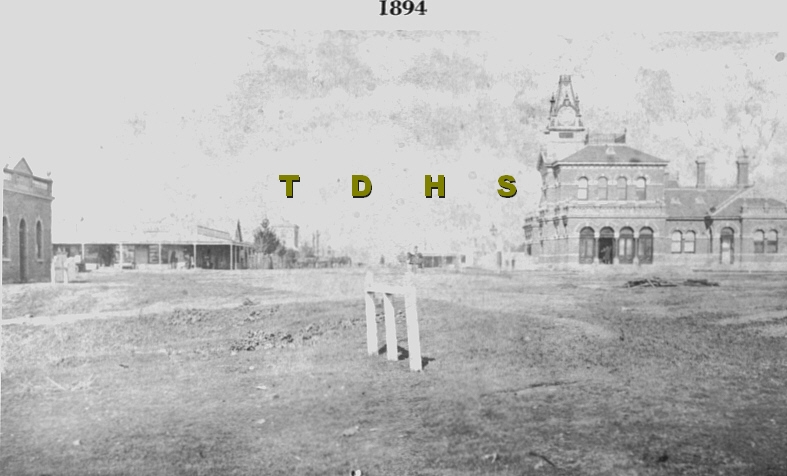
PHOTO: John Peterkin started his own store first and next year bought out Oswald Marriage, and his corner store became a town landmark. And his only monument or memorial is that his name has been given to the street which runs down past the Scout Hall.
In June, 1875, measles struck the town and the school had to close for a fortnight. With measles and influenza together, most of the schoolchildren were ill.
Although Breed and Petersen had butcher's shops here, Pyne and Price had re-opened the butcher's shop over at the Traralgon Hotel. Some fat which they were boiling down ran over and caught fire. The shop was burnt down and the hotel would have gone, too, had not the fire been put out.
The first bank in Traralgon was a savings bank which was started by the Post Office in July, 1875. Nine people opened their accounts on the first day and, in later years, these accounts were taken over by our State Savings Bank.
On 29th July, 1875, William Whittakers obtained the leases of Loy Yang and Traralgon East for himself, and it was at about this time that the well-known residence of Fernhill was built by him. Many of you will have seen that name on the gate on the Princes Highway at Loy Yang.
But although there was all this activity in Traralgon, blocks of land did not sell very well when the Government held land sales. There had been several attempts to sell the north-west corner of Franklin and Hotham Streets and, at last, in September, 1875, it was sold for £15. This corner will come into our story again shortly.
With all the work going on the railway out at Loy Yang, the men must have been thirsty. George Newport opened a hotel there at Sandy Creek. He called it the Red Gum Hotel, and I think that it closed down as soon as the railway workers moved on. But a hotel was opened at Flinn's Creek also at this time. Not many people will remember this hotel, although it was there for twenty-five years. The railway had been laid from the Sale end and, in October, the schooner, "Warhawk", landed a railway engine at Sale. Other small ships brought trucks and carriages from Melbourne to be used on the new line.
The Rosedale Shire seemed to be a bit too big to be run as one big Shire, and some people thought it would be better if it were divided up into sections called Ridings, so that each Riding could spend its own money, and Traralgon rate moneys would not be spent at the Lakes Entrance end of the Shire. But the Government would not agree to this.
Smallpox was a dread disease in those early times, and all babies were supposed to be vaccinated so that they could not catch it. But many citizens did not obey the law and were taken to Rosedale Court. In the first list of cases, I find the names of Edward White who owned Tyers Station and Charles Taylor who had the Bush Inn.
People still thought that Traralgon would grow up around Argyle Street for, when the Government held a sale of some land in November, 1875, blocks between Seymour Street and Hotham Street near the "Journal" Office could not be sold, while small blocks intended for shops on the flat between the Methodist Church corner and the creek were snapped up like hot cakes.
And up at Sale, at the beginning of December, the first train to run in Gippsland got up steam and made several triumphant journeys from Sale down to the first bridge over the river. Everyone who mattered was there, and what did they care if they returned all spattered with smoke and grime from the engine. They had only two open trucks in which to ride, but they had ridden on the first train.
The school was getting bigger every month and Mr. Mattingley had to get another teacher. Mrs. Mattingley was the work mistress there, but Mary Campbell, whom you will remember as the monitress with Mr. Sanders, started as a pupil teacher.
Another well remembered citizen arrived here in 1876 from Walhalla. He was Edwin Kaye, and he took over the Star Hotel from Mr. Hickox. A lot of people spell Kay Street as "Kaye" Street, which is quite incorrect, for Kay Street was named on the first plan of Traralgon drawn in 1858, while Mr. Edwin Kaye did not come here until nearly twenty years later.
For all these years, the people had used the two rooms at the hotel as a public hall. At last a Mechanics Institute was formed. The leading citizens held a meeting in the corner store and asked the Government for the south-west corner of Hotham and Franklin Streets. They had only £5 cash to build a hall, but John Peterkin and Oswald Marriage let them have all the timber and iron, and let them pay later.
So up went the wooden hall. It was opened with a dance, but no sooner had the building been finished than a violent storm hit Traralgon and flattened the Mechanics' Institute and also blew 60 feet of verandah off Marriage's store. So they had to rebuild the hall again, and Frank Hickox, Mattingley the teacher, Thomas Row and others got up a troupe of Nigger Minstrels and toured all the towns, even as far as Walhalla, to make money to pay for the rebuilding of the hall.
As Traralgon was getting bigger, it was time for a Court to be opened here. The first Court sat in September, 1876, the Clerk of Courts being Mr. Charles Du Ve from Rosedale. The Justices of the Peace who sat with the Police Magistrate were Dr. Macdonald from Eaglehawk and Mr. William Whittakers from Loy Yang. The Court sat in the two rooms over at the Traralgon Hotel where the public meetings had been held. They had called those rooms "Shiells' Rooms" after Thomas Shiells who had the hotel when they were built, but in later years they were referred to as the old Court House.
In August of this year, Traralgon itself had its first citizen, Dugald Campbell, elected to the Rosedale Shire Council. He was to serve the people for many years before he was killed by a fall from his horse.
And now it was time for a trading bank to open its doors. In 1876, the first bank to come to Traralgon, the Bank of Australasia, opened a branch in part of the store on Clauscen's corner. And there was room for another hotel, too. Charles Handley opened the Wheatsheaf Hotel on the Rosedale Road on the eastern side of the creek. That makes seven hotels so far, but do not be surprised, for there are more to come.
Even the schoolroom, with its new galvanized iron roof, which had replaced the bark which had split with the heat of four summers, was becoming too small for the 75 children at school, and, in October, 1876, John Peterkin drew up a petition to the Government seeking a new school, and it was signed by 72 fathers of school children.
The Church of England people, too, were doing their best to get a Church here. Rev. Kelly from Rosedale and William Whittakers went round the district collecting money for that purpose. The Presbyterians were more fortunate for they had already had the land for their Church given to them by the Government, but, as you will remember, the school had been built on the Church land, so the Presbyterians had to wait for an exchange. In the end they received all the land along Gwalia Street from Peterkin Street to Campbell Street.
At the end of 1876, John Petersen gave up his butcher's shop to take over the Rubicon Hotel.
Of course, on every New Year's Day, the big event at Traralgon was the race meeting on the Racecourse in Traralgon Park behind the hotel. In one year there were two rival meetings, one in the Park and the other behind the Star Hotel on the other side of the creek, and the crowd could go from one meeting to the other.
On 14th May, 1877, Duncan Campbell passed away in the Gippsland Hospital, Sale, at the age of 68 years. He was buried in the Cemetery at Sale.
The railway line was nearly finished, and when the track to the station had to be made, the Rosedale Shire Council decided that Franklin Street should be formed from the railway station to the police station, and that gravel should be placed on the two footpaths. So the paddock that was Franklin Street became a street with red gum kerbs and gutters so that the water would get away in the winter time.
On 1st July, 1877, the first train ran from Sale to Morwell.
The train started carrying passengers on 28th July, but they had to take the coach for the rest of the journey from Morwell to Melbourne while work was still being done on the two other sections of the line - Morwell to Bunyip and Bunyip to Oakleigh.
In July, 1877, too, important local citizens were appointed to control the new cemetery out at the Bluff. People had been buried there since 1872 and now the railway yards had moved into the old cemetery. John Peterkin was appointed by the Presbyterians, H. J. Mapleson by the Methodists and Charles Phillips by the Anglicans.
We come now to the next step in the history of the Shire of Rosedale. It was divided into separate parts called Ridings, and Traralgon and Morwell were called the Traralgon Riding. We can see the coming of the Shire of Traralgon a few years later. When a Shire is divided like this, a new election must be held. Three new Councillors were elected for the Traralgon Riding - Dugald Campbell, Robert Mill and Henry Breed. The Council had ideas, too, of building a better bridge over the creek so that the traffic would not have to take its winding course over to the bridge at the bottom end of Grey Street. They had picked the place near where the long bridge is today, and decided that a pump should be put on the creek bank there to allow the townspeople to draw their own water. You will remember how, in 1862, Alexander Dodds supplied creek water to the Police Station for 1d. a gallon.
The coming of the railway had caused the whole town to look to Franklin Street as its main street. The town was moving away from the Rosedale Road and the Traralgon Hotel corner. The Government was selling more blocks of land in the town and, when the section between Hotham Street and Princes Street was marked out, nearly all the blocks were sold quite easily.
The 8th October, 1877, was a red letter day for Gippsland. On that day, the first people ever travelled from Melbourne to Sale in the one day. Another part of the Gippsland Railway Line was opened from Oakleigh to Bunyip. The Gippsland Railway was being built by the Government, while the railways around Melbourne were owned by Companies, and they could not decide which way the train should take from Oakleigh into the city. There was talk of its going around the Outer Circle line, or connecting up with the Brighton Railway at Elsternwick or connecting with another line at South Yarra. So while they were making up their minds, there was no train between Oakleigh and Melbourne. The travellers left Melbourne at six o'clock in the morning and drove out to Oakleigh by coach. From here they were taken by the train to Bunyip. Then back on the coach to take them to Moe, and then by the train to Sale. The train was expected in at Sale at 8.30 that night with the Melbourne papers. But the coach had broken down in the middle section and the train did not get in until 11 p.m. But they had made it in the one day. Just fancy, the people in Sale were able to read for the first time the Melbourne papers which had been published that very same day.
 PHOTO: sketch of the railway, circa 1880. The Grand Junction Hotel and Franklin St., are visible on the left of the water tank tower.
PHOTO: sketch of the railway, circa 1880. The Grand Junction Hotel and Franklin St., are visible on the left of the water tank tower.
The school children were able to start work in the new school when they started in the New Year of 1878. This was the third school about which I have told you. The first was on Clauscen's corner, then there was the school with the stringybark roof in Campbell Street, and now a new wooden school between that school and the railway line where the pine trees are still growing around the old school ground. This school was enlarged in later years and eventually was moved over to Grey Street where it was used for years for the Higher Elementary School.
You already know how the brickworks started up to make bricks for the railway culverts. The Presbyterians decided to build their Church, and it was built of brick and stood on the corner of Campbell Street and Gwalia Street. It has disappeared now, but it was the first brick building in the town and was opened in February, 1878. Rev. J. G. Wilson, the Presbyterian Minister for Rosedale, used this Church only every second Sunday, and the Anglicans and the Methodists were both able to hold their services there on the other Sundays. At this time, Bishop Goold, the Roman Catholic Bishop in Melbourne, bought for his Church hall that land where you now see St. Michael's Church, the Convent and the Presbytery.
The contractors for the building of the railway line between Moe and Bunyip finished their section by 1st March, 1878, when the coaches were no longer needed for the middle section, and the Government took over the whole line from Oakleigh to Sale. They sent out some engines and carriages by road from Melbourne and started to run two trains a day. The first train left Oakleigh at 8 in the morning and reached the top of the Haunted Hills by 20 to 12, and arrived at Sale at 5 minutes past I in the afternoon. They could hardly believe it - five hours only. What a difference the railway was going to make in the lives of Gippslanders.
On 27th April, 1878, poor Henry Sanders, the ex teacher, died. He had always been a sick man and died from tuberculosis. How wonderful it is that nowadays we can have a free X-ray to check that we, too, do not die young from T-B- like Mr. Sanders. He was only 52, and left seven little children.
I do not have to tell you the story of Burke and Wills, King and Grey. You will have read how King, the only one left of the four explorers, was found by a search party led by Dr. Howitt who found the bodies of Burke and Wills and, after wrapping them in the flag of their country, buried them on the banks of Cooper's Creek. Well, Dr. Howitt also comes into our history. He was later a Police Magistrate here in Gippsland and, for some time, sat in the Courts in this part. He first sat at Traralgon Court on 18th May, 1878. He often visited the Whittakers at Loy Yang for his daughter was married to E. S. Whittakers.
William Whittakers had decided to give up his lease to Traralgon East run in May, 1878. He had abandoned Loy Yang run in the previous December. You see, there was very little of the runs left because the Government in Melbourne had been selling large pieces of them to new settlers. And as Mr. Whittakers already owned the best parts of both runs, having bought that land from Turnbull and Henderson, he really did not lose anything by forfeiting his rights to the runs.
In July,1878, our first clergyman arrived. He was Rev. Thomas Moorhouse of the Church of England. He was found a cottage on the east side of the creek by Mr. Oswald Marriage. The Anglicans continued to hold their Church services in the Presbyterian Church every second Sunday. Mr. Moorhouse had never ridden a horse before but he soon learned the art, and would ride to hold Church at Eaglehawk, Scarne, Flinn's Creek, Tanner's Park, which we now call Callignee, Hazelwood and in Miss McRory's bark and hessian school at Maryvale. It was the only public building in the Morwell district then. Of course, as you can expect, it was not long before Rev. Moorhouse was trying to get a Church of England built here.
You will remember how Hugh Fisher built the school over in Campbell Street in 1872 for £55. Well, you may hardly believe it, but it was not until September, 1878, that he was paid the £7/2/6 which was still owing on the building. And that was all because the people put the school on the Church land, and the Education Department would not pay until that land had been given back to the Government.
In January, 1879, a new publican took over the Traralgon Hotel. His name was Thomas Mitchell. The Mitchells were here for fourteen years, and Mitchell Street is named after the family.
And all this time work had been going on in building the railway from Oakleigh to South Yarra. The Government had decided that that would be the way into Melbourne. The line right through from Melbourne to Sale was opened in April, 1879. What was the result here? For the first time, butter could be sent to Melbourne by train. Farmers could start milking cows instead of just grazing cattle and driving them to Melbourne to be sold. It was better to truck the cattle to Melbourne. Butter factories were built in every main town. There was a good sale in Melbourne for red gum for buildings, and for the wood-blocks for the streets. So sawmills appeared everywhere to cut up the beautiful forests into timber which, up until now, could not be used locally, and send it to Melbourne. All the big Mountain Ash forest up at Callignee could also be cut. It split so easily into palings, and trainloads of palings were sent to Melbourne for fences around houses in the city. Traralgon bricks were of fine quality and were in great demand. Even the Court House at Warragul was built with Traralgon bricks taken there on the train.
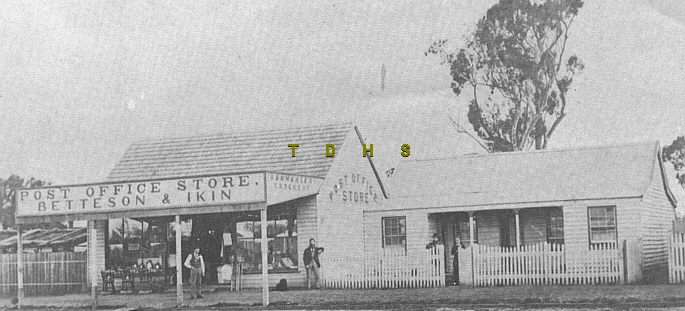
PHOTO: the store of Betteson & Ikin, in Kay Street, 1878.
Traralgon was growing so fast now that I just cannot tell you of all the changes in the butchers, bakers and storekeepers. But one result from the opening of the railway was that very little money was being spent on the road to Melbourne. The bush roads which ran alongside the railway were not needed, and it was not until the motor car was invented and then the Country Roads Board was formed that the road to Melbourne was much more than a bush track.
In April, there was a change of Head Teacher at the School. Mr. Michael Dwyer took over. The school was now getting too big for Mr. Mattingley to hold as he had not passed the necessary examinations. He was offered a smaller school, but he did not take it and went off to Queensland. The old school which Hugh Fisher had built in 1872 was shifted out to Traralgon Creek South, as they called it then, for a school there.
On 20th October, 1879, we come to another important date, for on that day the Government decided that the Traralgon and Morwell areas should be cut off from the Shire of Rosedale to form a new Shire - the Shire of Traralgon. The Shire boundary went as far as the Morwell River.
In December, 1879, two more hotels appeared. First there was the Club Hotel built by Frank Hickox who had started off in the Star Hotel in 1875. The Club Hotel was on the corner of Franklin and Hotham Streets, opposite the present day A.N.Z. Bank. It was a wooden building, and all the spaces in the walls were filled with red gum sawdust from John Peterkin's sawmill. It is said that, although several attempts were made to burn down the hotel for the insurance money when times were hard, it would not burn because the sawdust fell out and smothered the flames. I have told you how John Peterkin and Oswald Marriage supplied all the timber for the Mechanics' Institute and let the people pay later. Well, Mr. Peterkin once again helped Mr. Hickox in the same way by supplying, on credit, all the building material for the Club Hotel. George Fick also took out a licence for the Callignee Hotel which he held for the next five years.
So, in January, 1880, an election was held to decide who should be the Councillors for the new Shire. There were six elected - Councillors Kelleher, McGauran and Firmin from Morwell and Henry Breed, Dugald Campbell and Thomas Mattingley from Traralgon. John Bodycomb just missed a place, for he came equal sixth with Mr. Mattingley, and the returning officer in charge of the counting then gave his vote to Mr. Mattingley. The new Councillors held their first meeting in the Old Court House near the Traralgon Hotel on 26th January, 1880, and Councillor Kelleher was elected our first Shire President. The Old Court House was to be the Shire Office for the next two years.
And before I end this chapter, let me take you back over the last ten years. From just a small town in the area looked after by the Rosedale Road Board, Traralgon had become the chief town in a new Shire. The people had opened their own school, built another and the Government had then built a better one. The railway had been built, and Traralgon had changed from a sleepy hollow into a busy town in about two years. Butter factories, sawmills and brickworks were all springing up or planned. I hope you will agree with me that this chapter was one of the most important in our story.
We now come to a time in our story when so much happened that you will not be surprised to find that our town stood still for many years afterwards. The railway had changed the lives of the citizens of the new Shire, but, before I tell you how busy the town became, I feel that I should go back to the days of the Shire of Rosedale for a moment. So many things had also happened during those ten years that, in telling the story, I was bound to miss something.
The people were then setting up Friendly Societies - you probably call them Lodges - where they met and helped each other when someone was ill or out of work. The first Lodge in our district was the Excelsior Lodge of the Grand United Order of Odd Fellows. It started in Rosedale in 1871, but, so quickly did Traralgon grow, it moved here in November, 1875, and has been meeting regularly ever since. It was our first Lodge, but maybe it is not as well known to you as some of the bigger Lodges which followed it in later years. It was followed in 1878 by the Independent Order of Rechabites, which still meets here, too. Rev. W. Batten, the Methodist Minister, was the first Secretary of this Lodge. This brings me to the Methodist Church, which I should have mentioned. The Church started here in 1878 under Rev. Batten, a Home Missionary, and, like the Church of England, the Methodists held their services in the Presbyterian Church in Campbell Street. The next Minister, Rev. D. J. Flockhart, lost no time in erecting a wooden Church on the rise on the corner of Argyle and Mill Streets in 1879. This Church was enlarged in later years and, when the new brick Church was built in 1939, the old building was moved to one side and was used as a Sunday School for many years.
You will remember that Traralgon was a stopping place for the drovers taking cattle along the Melbourne Road to the markets in the City before the railway came, and how they would yard them here overnight. The Haxells, who were running the Traralgon Hotel at the time, had yards behind the Hotel, about where the Valley Theatre has been built. In 1875, an Auctioneer named Paterson started to hold cattle sales in Haxell's yards every three months, and this was the beginning of the cattle trade here. More farmers were able to send their cattle into Traralgon to be sold, instead of going to Rosedale, and, in 1879, the firm of Little and Borthwick opened another cattle sale yards in Breed Street at the corner of Hotham Street.
And now I can come back to the story of Traralgon when it first became a Shire of its own in 1880. Councillor Kelleher had been elected Shire President and, on 11th February, 1880, the Council sat down to deal with the first business of the new Shire. Mr. Mitchell, who was the licensee of the Traralgon Hotel, let the Council use the public rooms there free of charge, for the Shire had no money until a loan could be arranged with the Bank of Australasia.
One of the first things that the Council thought should be done was the building of a railway to Yarram through Callignee. This was the first of many schemes like this. Sometimes it was thought that it would be better to run the line through Gormandale instead, but, after about forty years, and the coming of the motor car, all chances of such a railway being built had disappeared.
Following on the opening of the Presbyterian and Methodist Churches, the new Church of England was opened in February, 1880, on the corner of Seymour and Church Streets. It was just a small wooden building - all that the people could then afford.
The story of Traralgon is really the story of the Shire. Mr. Frederick Farrell was appointed the first Shire Secretary and Engineer, and the Council then had all the houses and land valued. This having been done, the Council "struck a rate", that is, it decided that all landowners should be taxed according to the value of their land to help to pay for the running of the Shire. Some of those taxed thought that they were being asked to pay too much, and took the Shire before the Traralgon Court, just like some people still do today.
We now come to the story of the first "Long Bridge". There were now two bridges over the Creek - a small one, very rickety, where the footbridge is today, and the other under the railway line near the Recreation Reserve - also in a bad state. Where was the new bridge to go? Looking at the map, you would say it should go in a straight line with the road to Rosedale, but a lot of people thought otherwise, and there was much bad feeling about it. The Council decided that it should go in just south of the Star Hotel, the old building that is still there.
It was in these years that John Peterkin started building more sawmills. The people who built the railway had their own sawmills, and now that the railway could carry red gum timber to Melbourne, John Peterkin lost no time in taking a leading part in this trade. He built a large sawmill out at Toongabbie and, later on, one in Traralgon.
The Council held its usual election in August, 1880, and, this time, John Bodycomb from Callignee was elected a Councillor. Mr. Bodycomb served his Shire and the People for 38 years, being President on six occasions, and I think that the name Bodycomb should be written after those of Hobson, Turnbull, Duncan Campbell, Peterkin and Dugald Campbell.
Although the Council had very little money, it was already thinking of building a Shire Hall. And as Morwell was half of the Traralgon Shire - the better half perhaps in the minds of the people at Morwell l - they wanted the Shire Hall to be built there. But Traralgon won in the end.
In November, 1880, James Campbell became Shire Secretary and Engineer. He is the man who named the eastern end of Kay Street Argyle Street, because he came from Argyllshire in Scotland.
When Traralgon was in the Shire of Rosedale, the bridge at the Scarne was erected, and now people out at Tyers wanted to have a bridge built over the river at the Bluff near the cemetery. Tyers was in Rosedale Shire then, and when the Rosedale Shire refused to help by paying half the cost of the bridge, the people at Tyers set to work with a view to being cut off from Rosedale Shire and joining Traralgon.
It was at this time that a tannery was built in Traralgon at the Creek end of Franklin Street where the Council had its depot. It was quite a busy place, but it was closed down when the land was bought for a butter factory about twenty years later.
The year 1881 was the year of the Bridge. Some of the people were so dissatisfied about the bridge not being in line with the road to Rosedale that they even went to Melbourne to complain to the Minister in Parliament. He sided with them, and the Council eventually had to put the bridge in line with the road. This made it so much longer that it received the name of "The Long Bridge". It served Traralgon right up until 1932, and Mr. Murdoch, one of the builders, will be remembered by his name being given to Murdoch's Hotel at Morwell. Maybe the bridge, being so much longer, did not hold back the floodwaters in the creek as it may have done had it been shorter and built further north.
Traralgon was a poor Shire with very little money and no roads and few bridges. The Government in Melbourne decided to help those Shires which, like Traralgon, had all the work to be done and no money with which to do it. The Government decided to give such Shires £3 for every £I that they collected themselves. You can just imagine how that helped Traralgon, for any road or bridge that had to be built would now cost the Traralgon people only one quarter, the Government paying the rest.
The Traralgon Town Band was formed at this time. It met for a start in the Old Auction Mart, between the present "Journal" Office and the corner, and later in the Fire Station which used to be in the Railway Reserve in Princes Street. Mr. P. Morris was the first Bandmaster.
In the early Eighties, too, we had a second trading bank. The Colonial Bank opened a branch where the Almond Cake Shop is situated in Franklin Street. Mr. Harry C. Jones was the first manager. A few years later the Colonial Bank built the big building on the corner of Seymour Street and, in 1918, when the National Bank and the Colonial Bank joined together, the National Bank moved into the building which it still occupies.
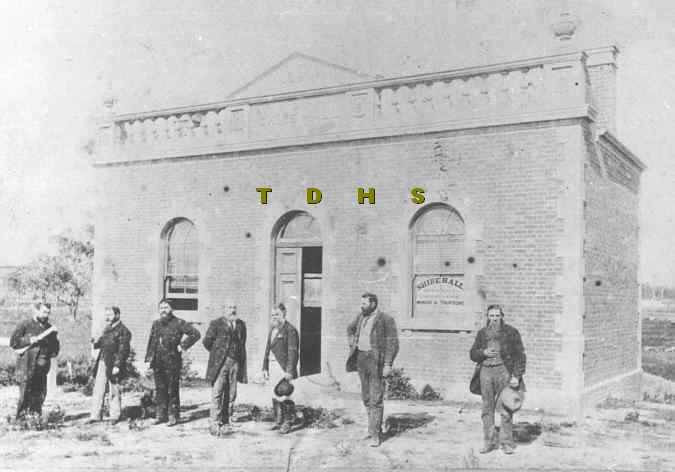
PHOTO: the Shire Hall, Traralgon, and the Shire Councillors, 1881. The Shire Secretary, James Campbell, is on the left, and the Shire President, Cr. Dugald Campbell, is second from the right.
All this time the Shire Hall was being planned. The Council had various pieces of land offered to it. Mr. Mitchell, who was always trying to build the town around his hotel, even offering a piece of land in Kay Street next door to his hotel for nothing. But the corner of Mitchell Street was finally chosen. Then, of course, the Shire President had to lay the foundation stone. Mr. Henry Breed, the Argyle Street butcher, was the man and, on 19th July, 1881, there was quite a ceremony. The band was not good enough yet to take part, but all the schoolchildren were there. Mr. James Campbell, the Shire Secretary and Engineer, had written a History of Traralgon, and the papers say that that history, together with all the newspapers of the time, was placed in a hole under the stone. No one seemed to remember where that stone was placed and, when the Old Shire Hall was pulled down by the Apex Club in 1966, they certainly found a bottle, but it contained only the old news- papers. There was no History of the Shire there at all. So it is a great pity that Mr. Campbell's story of Traralgon could not be read to the school children of Traralgon today, nearly ninety years later, just as the boys and girls heard it in 1881. The Hall was finished by October, and the Council moved in and held its first meeting there in November.
Tyers became part of Traralgon Shire in November, 1881. The idea at first was to take over all that part down as far as the Scarne, but eventually the boundary was fixed at Rintoul's Creek. There was now no question of sharing the cost of a bridge at the Bluff with Rosedale Shire, and Traralgon, with its £3 to £I from the Government together with another gift of £500 towards the bridge from the Government, was able to build it and have it opened during the year 1882. Before that, of course, the Tyers people had to go right down to the Scarne before they could cross the Latrobe.
With the opening of the Long Bridge, the traffic was no longer going past Mr. Kaye's Star Hotel on the way to Rosedale. In 1882, Mr. Kaye bought a piece of land nearer the road for a start, intending to rebuild his hotel there. Then he tried to get the Council to reduce the width of Rosedale Road. But all for no purpose. He eventually bought a piece of land in Argyle Street and built his hotel there, right next to the one already there. But I will come to that later.
The Council was very bridge-minded as you can see, for, in this same year, the Cordial Factory Bridge was also built, providing an easier way out of the town to the south when the low level bridge under the railway line was under water.
With a creek running through the town, Traralgon was always certain of water, but the idea of a town water supply came up in 1882. Before that there was just the town pump near the Long Bridge. Cr. Mattingley had the idea of boring for underground water, but no other Councillor would support him.
In May, 1882, Mrs. Jane Downing, who had bought the building on the corner of Church Street and Princes Street, which was originally a produce store, applied to the Court for a licence for a hotel there, which she called the Royal Exchange Hotel. She had made a few alterations to it, of course, but it was a good place for a hotel. Travellers to Morwell could have their last drink there before setting out on the ten mile walk or ride, and those coming from Morwell found it a very good place to pause for refreshment it they did not have enough strength left to reach the Club Hotel around the corner in Franklin Street.
In July of this year, another Campbell, James Campbell, bought the Rubicon Hotel from John Petersen. It was he who, in the following December, changed the name of the hotel to the "Commercial", because his boarders did not like the "Rubicon".
It was at about this time that the first chemist opened his shop in Traralgon. His name was Paul Kleesattel, and he was a Pole. He started business in the centre block in Franklin Street and, in about 1887, he moved his business into a new shop on the corner of Seymour Street, and there has been a chemist's shop there ever since.
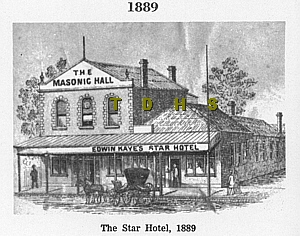 Poor Mr. Kaye in his Star Hotel was losing business now that the traffic across the Long Bridge was not passing his hotel. So he received permission from the Court to build his new Star Hotel right next door to James Campbell's Commercial Hotel in Argyle Street. Campbell tried hard to stop him, without result, and the new hotel was erected and, by arrangement with the Freemasons, a large assembly hall was built upstairs. The Masonic Lodge met here, and the hall was even used for skating and dancing.
Poor Mr. Kaye in his Star Hotel was losing business now that the traffic across the Long Bridge was not passing his hotel. So he received permission from the Court to build his new Star Hotel right next door to James Campbell's Commercial Hotel in Argyle Street. Campbell tried hard to stop him, without result, and the new hotel was erected and, by arrangement with the Freemasons, a large assembly hall was built upstairs. The Masonic Lodge met here, and the hall was even used for skating and dancing.
In March, 1883, I find that the Traralgon people were not at all happy about their Court still being held in the two rooms beside the Traralgon Hotel, and the Council sent the Shire President and others to Melbourne to see the Government. There was a move on, too, to get a proper Post Office instead of Campbell's house, "The Retreat", in Kay Street. So it was suggested that the Post Office and Court House might be built together in one building on the old Police Station corner, and the Government seemed to be quite ready to put it on the list of things to be done.
Traralgon was becoming big enough to run a Football Team, and the Traralgon Football Club was formed in this year. The first match was played against Morwell in June, 1883, and Traralgon won by five goals to none. In those days, behinds were not scored. Traralgon also played against Rosedale and Warragul. Our colours then were a blue guernsey with a red sash. The footballers also wore red sox and a red cap.

PHOTO: view of Franklin Street, looking South, in 1894. The Shire Hall is clearly visible on the far left, followed by Peterkin's Store on the corner of Argyle Street, and Franklin Street.
There were quite a number of shops in Franklin Street now. Coming from the Railway Station, there was nothing until you came to Day's delivery store where the Crown Hotel is today. Goods were stored there when they arrived from Port Albert before the railway came. S ullivan's blacksmith's shop was on the National Bank corner. Then down opposite the Police Station was Adair's bakery and then Peterkin's store on the corner. Around the corner in Argyle Street was the Commercial Hotel and then the Star Hotel with a couple of small shops in front, and then Henry Breed's butcher's shop.
Now we go back to the Railway Station and come up the west side of Franklin Street. The wooden Mechanics' Institute was on the corner of Hotham Street, and the Club Hotel was across the road. A little further on there were three shops - H. E. Henden, our first newsagent, was in the first, Kleesattel the chemist in the second, and Jones the jeweller in the third. Moving on, there was a shop selling ladies' underwear, then Lumley & Galbraith, the grocers. A. L. Galbraith the baker was next door, then Hector O'Neill had a boot shop. Then came the National Bank, and on Jeffery's corner Fred Smith had a saddler's shop. There was nothing at all in the next block until you came to the Police Station on the corner of Kay Street, and around the corner, going west, you came to Betteson & Ikin's grocery store.
Just compare that with the Franklin Street you know today. The shops were open every day except Sunday, and until 11 p.m. on Saturday night. Why, they even agreed to close their shops every Wednesday afternoon in 1883.
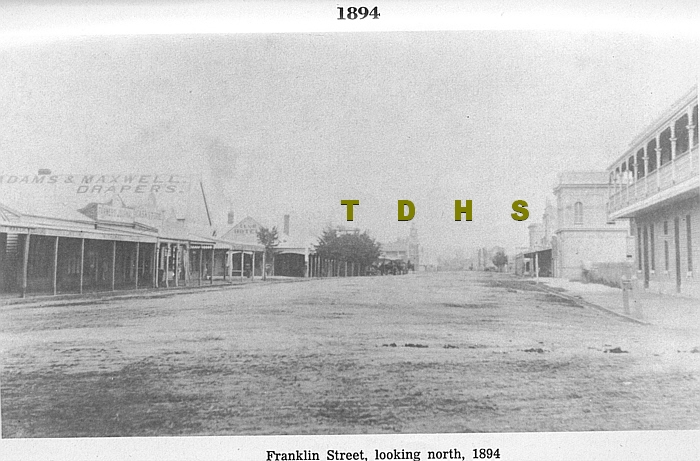
PHOTO: Franklin Street, looking North, in 1894.
And all this time there was no doctor in the whole of the Traralgon Shire which reached as far as Mirboo. The Council even advertised a salary of £150 a year to any doctor who would come here to live and to act as medical officer for the Shire. A number of doctors put their names down, but the fellow who received the job did not arrive.
In September, 1883, the Roman Catholics were able to move into their new brick Church which they had dedicated to St. Michael. You will remember how, until now, they had been holding Masses at the old Court House. Their first brick church was pulled down when the big new church was built in 1935.
In November, the railway line from Traralgon to Heyfield was finished, and trains started to run that far. Where a road crossed the railway there would be gates and a gatehouse, where today we have just a plain level crossing with flashing lights. The line repairers lived in these gatehouses. There was one at Collins Street, another on the road to Rosedale, and so on. Most of these were pulled down when they became too old to repair, with the result that we now have just the plain level crossings without gates or gatehouses.
Before the end of 1883, another important event occurred. The first newspaper was printed in Traralgon by young John Baird. He called his paper "The Record", and his printing press was set up in Day's old delivery store. He was able to move into his new office in Seymour Street twelve months later and, for nearly eighty years that building was never altered except to have a verandah built across the front. The "Record" and the "Journal" joined up in later years.
In 1884, the Council decided to put in some street lights. There was no gas and no electricity. These lights were kerosene lamps on a post. There were to be six - one on the corner where the A.N.Z. Bank is now. It was just a paddock then. Another was to go outside Jones' who now had the blacksmithy on the National Bank corner. A third was placed outside Fred Smith's the saddler's on Jeffery's corner, another on Peterkin's corner, one outside the Police Station where the Post Office now stands and another outside the Post Office in "The Retreat" in Kay Street.
The Council decided to name more streets too. As I told you earlier, the principal streets were named by the surveyor when he made the first plan of Traralgon in 1858. But people were building houses on blocks all around the town. Princes Street speaks for itself, Argyle was named after the Scottish clan of James Campbell the Shire Engineer, Mitchell after the publican in the Traralgon Hotel, Church also speaks for itself, Breed after Henry Breed the Councillor and butcher, Peterkin after the famous John Peterkin, Mason after the Member of Parliament who was doing so much for the town, Mill Street where Peterkin had his sawmill, Berry after another Member of Parliament, and Gwalia is another name for Wales.
While I am telling you about the street names, maybe I should jump ahead a little and tell you about the remainder of the early names. Campbell after the Traralgon Park Campbells, Service after another Member of Parliament, Deakin after the famous Alfred Deakin who, in later years, was the second Prime Minister of Australia, George and John after nobody knows who, Flora Street, a new name for Rosedale Road which did not stick, Munro after the first manager of the Bank of Australasia and, of course, High Street.
 Shortly afterwards, John Peterkin divided up Loch Park. These were the days of the land boom, when everybody went in for buying blocks of land. Mr. Peterkin named three streets after his daughters Ethel, Mabel and Olive. Olive Street was the top end of Henry Street, but it has been dropped too. Then Henry Breed sold up his land in Henry Street, and he named his streets Henry, after himself, and Ann and Albert after his children. Then Francis Mason cut up Hyde Park and named the streets there Charles, Marie and Rose after his children and, lastly, the Templeton's called the streets of their land Collins, Bourke and Swanston after those in Melbourne, and Morrison after Dr. Morrison, the first doctor to live here. PHOTO: Dr. R.G. Morrison, in 1890.
Shortly afterwards, John Peterkin divided up Loch Park. These were the days of the land boom, when everybody went in for buying blocks of land. Mr. Peterkin named three streets after his daughters Ethel, Mabel and Olive. Olive Street was the top end of Henry Street, but it has been dropped too. Then Henry Breed sold up his land in Henry Street, and he named his streets Henry, after himself, and Ann and Albert after his children. Then Francis Mason cut up Hyde Park and named the streets there Charles, Marie and Rose after his children and, lastly, the Templeton's called the streets of their land Collins, Bourke and Swanston after those in Melbourne, and Morrison after Dr. Morrison, the first doctor to live here. PHOTO: Dr. R.G. Morrison, in 1890.
And now back to 1884, when the Campbells built the first sawmill in the town, on the east side of the creek. John Peterkin bought them out and built another sawmill in the following year on the block next door to the offices of the Latrobe Valley Water and Sewerage Authority in Seymour Street. This was really a big mill, and even had its own railway line across to the railway yards. It worked twenty-four hours a day, and Peterkin cut out all the red gum on the west side of the creek. The bullock wagons hauling the logs into the mill turned Grey Street and Mill Street into a bog in winter time. But Peterkin's sawmills were the life-blood of Traralgon in these times.
You will remember how the Mechanics' Institute was rebuilt after being blown down in the big storm in 1876. It was standing on a good corner in Franklin Street, and the trustees of the institute thought that it would be a good idea to sell the land for a lot of money and to build another institute on a cheaper block. The Government in Melbourne gave permission, and Mr. Hickox of the Club Hotel bought the place at the auction sale. He moved the building right up to the footpath, and for many years it was used as a drapery store by Adams & Maxwell, and later on by W. D. Leslie & Co. The Mechanics' trustees bought some cheaper land in Hotham Street where they built their new brick building which was to be the Mechanics' Institute and public hall for Traralgon for the next forty years.
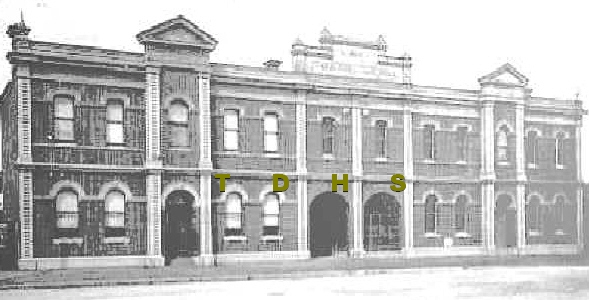
PHOTO: Mechanics' Institute in Traralgon
1884 was the year that Walter West came to Traralgon. He was a coachbuilder and blacksmith who, in later years, became Shire Secretary and also Member of Parliament for this district. Here is another instance where a tradesman, arriving in the town and setting up his business, was able to take an active part in the affairs of the people and to eventually reach the very top, West started off in business with his brother by buying out John Sullivan who, you remember, was once the blacksmith on the National Bank corner, but who now had a business further east down Seymour Street. The firm changed from time to time and, for a while, Walter West and James Mayze were partners. When Walter West became Shire Secretary in 1907, he sold out to people named Bruton.
When the railway was built some seven years before, they had to have water at the station to refill the engines. Although the creek was quite handy, it would have meant pumping water up into the big tank where the engines filled up. There was a better idea than that. Up in Hobson Park there is a big dam which we call the Railway Reservoir. This was built at the same time as the railway line, and pipes were run from the station up to the reservoir. Water was thus on tap at the station as soon as the first winter's rains filled it. In later years, when water was brought in from the Tyers River, the wall of the reservoir broke away, and the gully was dry for many years. But this railway reservoir comes into our story, for pipes were laid down Franklin Street during 1884 by the Council for use in case of fire. And Traralgon was due to have a really big fire within a few years.
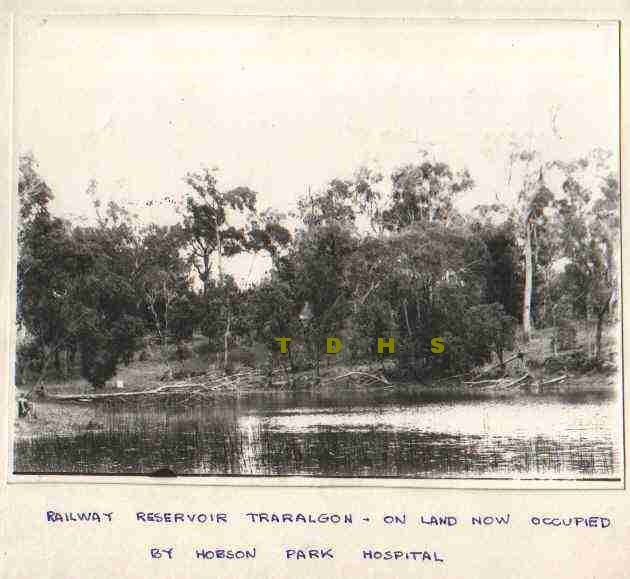
PHOTO: the Railway Reservoir.
During 1884, Dr. R. C. Morrison moved from Bairnsdale to Traralgon and became the first doctor to live in our town. The Council made him temporary Health Officer for the Shire in place of Dr. Macdonald, who lived at Eaglehawk, but practised in Sale. It had taken so many years to get a doctor to live here. Dr. Morrison's old house is still standing between Queen's Parade and Shakespeare Street, near the Cordial Factory Bridge.
In the next year, Dr. John Montgomery also came here and set up his consulting rooms in the Grand Junction Hotel. He was one of the Montgomerys from the Heart Estate at Sale. The Council then accepted Dr. Macdonald's resignation as Shire Health Officer and appointed Dr. Montgomery in his stead.
Two new hotels were built during 1884, the big brick Grand Junction Hotel and the wooden Crown Hotel. Hugh McAuley, who had the Wheatsheaf Hotel, found that all the trade was going to Franklin Street, so he built the Crown, which opened at the end of 1884, and closed the Wheatsheaf. The Sportsman's Arms Hotel at Tyers also opened at the end of 1884, and you can still see the old brick building on the north side of the river. Mrs. Jane Timms even opened a wine saloon on the Rosedale Road at this time.
Everyone has been to the Traralgon Show. The first event in the year 1885 was the formation of the Agricultural Society. Mr. Baird had the idea given to him a few months before, and he wrote it up in the "Record". So Mr. Dugald Campbell called a meeting, and they had two hundred members in no time at all. Mr. Campbell was made the first president of the Society and, as usual, the same batch of leading citizens formed the Committee. They were able to hold their first Show in the following November.
At this time, too, we lost another pioneer - Mrs. Elizabeth Windsor died on 24th January, 1885. You know how, in about 1846, the Windsors lived in the first house in Traralgon, which was on the Methodist Church corner. There they would provide meals and a bed for travellers before the Traralgon Hotel was built.
There were some people in Morwell who were not happy to think that their rate money was being spent in building a Shire Hall here in Traralgon, and this eventually meant that, just like when Traralgon was part of Rosedale Shire, the Government agreed to the Traralgon Shire being divided into three parts called Ridings. The town area became the Central Riding, Loy Yang and Callignee the Eastern Riding, and Morwell and Mirboo the Western Riding. We must keep these divisions in mind for, a few years later, the discontented people in the Western Riding were able to break away and to form their own Shire of Morwell.
Building was booming, and there were now four brickyards in the town. James Dunbar's yards were up the hill in Bank Street, Frank Hickox had bought out Peter Bonhomme who had the yards at the corner of Hazelwood Road, Oswald Marriage had his works up in Grey Street near Keys' Park and Albert Costin made bricks down on the Rosedale Road , where the Sewerage Board depot is today.
In August, 1885, the Freemasons formed a lodge here. James Campbell, the Shire Engineer, was the first master, and as I told you how he came from Argyllshire in Scotland, you can easily see how it took the name of the Argyle Lodge. It met in the room upstairs at the Star Hotel for the next seven years, and then moved to the Mechanics' Institute where meetings were held until 1925. Since then the temple on the corner of Church and Seymour Streets has been the home of the lodge.
You girls and boys have always known the racecourse to be up over Bye's crossing on the Princes Highway. As you already know, the first race meetings were held behind the Traralgon Hotel in Traralgon Park, But, in August, 1885, the Shire Council was able to get the Government to hand over a large piece of land out on Grey Street near the turn off to Tyers for a racecourse. Races were held there for many years, but the Racing Club lost so much money that, in the end, the citizens running the Racing Club had to pay the debts out of their own pockets. The Government sold the land, and it was used for grazing. For some years afterwards, the Racing Club still used the course, paying some- thing to the owner for each meeting. Things became better in later years, and the Racing Club was able to move to the new course up on the Princes Highway in 1914.
In these early days, too, we had some soldiers of the Victorian Mounted Rifles here in Traralgon, This was our first militia, and all the men were volunteers. They had to provide their own horses, but the Victorian Government gave them their uniforms, Edward Whittakers was the lieutenant in charge of the Traralgon men for a start and, some time later, Dr. J, P. Montgomery was a captain in the unit. Some of the young men who trained in the V.M.R. here, fought for their country as "Soldiers of the Queen" in the Boer War in South Africa. After the Commonwealth of Australia was formed, this unit in Gippsland became the 13th Australian Light Horse Regiment.
Roadmaking in the hills to the south of Traralgon was always difficult before we had the Country Roads Board, because of all the rain and the soft soil and no stone for road metal. The best method in the bad parts was to "corduroy" the road with round timber laid side by side across the road. It made travelling in a horse and cart very bumpy, but it was better than mud two feet deep. The chance of a railway to Yarram through Callignee seemed as far away as ever, and some people here in Traralgon tried to get the locals to put their money into a company to build a tramway out to Callignee. The idea was not popular, and so the company was never formed.

PHOTO: Callignee School with the school children and their teacher, Mr. Joseph H. Anson, in 1893.
But they did form a company to try to sell the brown coal which you know lies so thickly so close to Traralgon. The company spent all its money putting down a bore to see how far the coal went. Today we have the Government doing that for us, and since then test bores have been drilled all around Traralgon so that we know exactly where the coal starts and where it finishes.
You will remember that, back in the days of Duncan Campbell, the road to Rosedale went down the bank from the Argyle Street Post Office and across the Mitchell Street flat, and how it was not until the Long Bridge was built that people were able to drive straight down Argyle Street on their way to Rosedale. The Government felt that it was about time that this land was cut up into blocks and sold, despite the fact that it was once a swamp where Constable O'Connor used to shoot ducks. And so, in December, 1885, it was sold, but the little short street, called Wright Street, at the bottom of Grey Street, had to be left so that those who wished to use the old bridge could do so. The flat is now covered with houses, and when the Traralgon Creek is in flood, the whole area can still be covered with flood waters.
Another red letter day for Traralgon was 19th December, 1885. The Governor, Sir Henry Brougham Loch and Lady Loch visited our town. You need to go back to 1847 to the last similar happening when Superintendent Latrobe came here when he tried out the new Gipps' Land Road and slept in a tree near the Moe on his way. You will recall how Mrs. Hobson had him stay at her humble home. Although Latrobe became Lieutenant Governor to Sir Charles Fitz Roy, the Governor of New South Wales, when Victoria became a separate colony in I85I, this was really the first time that the Governor had honoured our town by his presence. He was probably in this part of the country because of the opening of the railway line from Morwell to Mirboo. He arrived here in the State Carriage on the train, and was welcomed by the Shire President , Cr. John Peterkin, and, of course, Ethel Peterkin, his daughter, presented the bouquet of flowers to the Governor's lady. Sir Henry said that he hoped to come back to lay the foundation stone of the new Post Office and Court House, but his wish never came true. We still remember his visit, for Loch Park was so named in his honour.
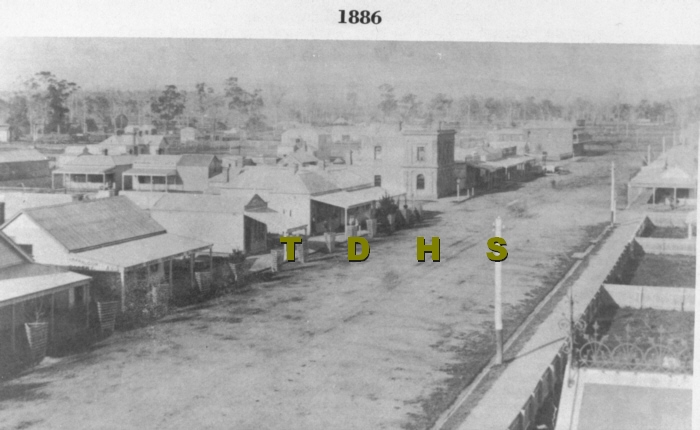
PHOTO: Franklin Street, East Side, from the Post Office Tower, in 1886.
In February, 1886, the National Bank opened a branch here. So we now had the Bank of Australasia around the corner in Kay Street near the present Infant Welfare Centre, the Colonial Bank in its new building on the corner of Seymour Street and the National in the room in the Grand Junction Hotel next to Woolworth's Apparel Store. About twenty-five years later, it moved into a new bank building in Franklin Street next door to the Court House and, when the National and the Colonial Banks joined forces in 1918, it went over to its present site on the corner of Seymour Street.
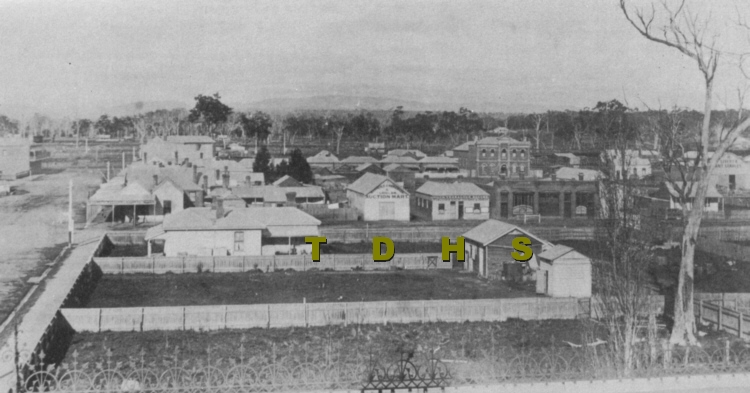
PHOTO: Franklin Street, West Side, from the Post Office Tower, in 1886.
Just in case you have the idea that all school children went to the State School, let me tell you that there were various private schools here in the early days. You will remember Mary Campbell, the school monitress with Mr. Henry Sanders, and who was later a pupil teacher when Mr. Mattingley was head teacher. After she married Mr. John Fynney, the Treasury Officer here, she started a small school of her own in the Campbell home, "The Retreat" in Kay Street. The Peterkin children went to her school. Hers was probably our first private school, but it was soon followed by several others, among them one where Mrs.Andersoon was the teacher and another where Mrs. Crowe was the teacher, and, as the years went by, more private schools were opened and closed - too many to put them all in our story.
In the early Eighties, there was a land boom here in Victoria, people buying land and cutting it up and making huge profits. There was no shortage of people ready and willing to buy the blocks. Here in Traralgon we had our share. Up until this time, the Government had been cutting up the land and selling it, but now we saw the local men taking the place of the Government. I told you a little about this when I was telling how the streets received their names, John Peterkin was the first, and he sold all the land between Breed Street and Loch Park Road right up to Kay Street, apart from twenty acres at the bottom of Henry Street. Henry Breed was next, and he called his twenty acres at the bottom of Henry Street the "Ben Venue" Estate. This land, which was sold by the Government for £4 an acre fifteen years before, brought £120 an acre at the sale. Then Richard Mackay, the auctioneer, outbid all others for the right to cut up and sell Hugh Dunbar's land beyond Loch Park Road, but the boom had burst by now, and his sale, in March, 1886, was a failure, A. W. Milligan tried to sell James Dunbar's land south of the railway line opposite where our Hospital is today, and he did no good either. That was the end of the big land sales in Traralgon for many years. These sales left us with many blocks of land on narrow streets which were not built on for 50 or 60 years. In those times, people did not see the necessity for nice wide streets, and we were left with Mabel, Ethel and those other narrow streets which will all need to be widened some day.
With shops closing here at 5.30 pm on weekdays and noon on Saturdays, it may be difficult for girls and boys today to realize that, in 1886, the Traralgon Traders were trying to have their members agree to close at 6 pm every evening except Saturday, when they remained open until 11pm. The late shopping night was popular with the public, but not with shop assistants, right up until the Second World War. Maybe it has gone forever in this country, although it is still popular overseas.
Traralgon waited forty years for its first doctor to live here, but it waited sixty years for its first dentist. In those early times, the doctors looked after the teeth of the people and, of course, if there was no doctor, why not the chemist? He should know. But trained dentists from Tasmania and Melbourne did come to Gippsland in the 1860's and they visited each of the larger towns like Sale. But there were also quack dentists about like Professor Mason who pulled out teeth free of charge in public just for advertisement, while his assistant, Sheridan, played the cornet to drown the shrieks of the patient. Our first chemist, Paul Kleesattel, was called on at times, but people said that, as a dentist, he was a good chemist. By 1886, we had visiting dentists coming here from Sale and Melbourne, but it was not until 1900 that Mr. A. J. Trood became our first resident dentist.

PHOTO: the Campbell home, "The Retreat", in Kay Street, which was the first Post Office before the new building was erected in 1886. This photo was taken before it was demolished in 1953.
It was during the year 1886 that the public buildings in Traralgon were constructed. The Post Office and Court House must have been, at that time, one of the best buildings in Gippsland, and Traralgon, small as it was, was fortunate in having the Government spend so much money here. The Post Office in "The Retreat" a few doors away in Kay Street was moved into the new office where Mrs. Starke, who had been the postmistress in "The Retreat" became the first postmistress there. Constable Donoghue was already in his new Police Station on the corner of Seymour and Franklin Streets, and the land between the Court House and the Police Station, was the paddock for the troop horse.
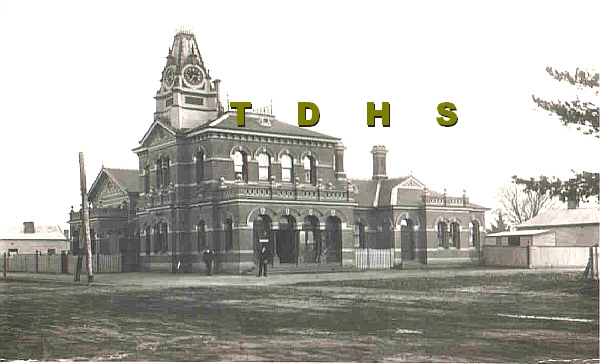
PHOTO: the Post Office and Court House constructed in 1886.
Traralgon was going ahead like wildfire. More and more new shops, mostly wooden, were going up in Franklin Street, and the people of Toongabbie thought that they, too, should join up with Traralgon Shire, just as Tyers had done. But nothing came of this move, and Toongabbie is still part of the Shire of Rosedale.
In September, 1886, another famous name comes into our story - Daniel Ryan bought the Commercial Hotel from Peter Kelly who then bought the Royal Exchange Hotel. Daniel Ryan was the father of Mr. Amby Ryan who, until his death recently, had been the licensee of the Commercial Hotel from 1915 to 1919. He then went into the Club Hotel for seven years, and in 1934 became the licensee of the Traralgon Hotel. Amby Ryan will be long remembered for his ability as a footballer. He was captain of the Traralgon Club for some years.
The year 1887 saw the second newspaper published in Traralgon. It was called "The Gippsland Farmers' Journal", and was printed by Mr. Thomas Allard Pettit, the first issue being on 27th January. The "Journal" office was up at the south end of Franklin Street, opposite Woolworth's Apparel Store, and the paper was printed there up until 1932. Mr. Edward Barbor became a part owner of the "Journal" in about 1921, and in a few years he was the sole owner. He bought out the "Record" in 1932 and amalgamated the two papers, closing the "Journal" office in Franklin Street and running one paper, still called the "Journal", from the "Record" office in Seymour Street.
So, if you have to read the story of Traralgon in the old newspapers, you have to read both the "Record" and the "Journal" up until 1932. By the way, the only full copies to that date are in the La Trobe Library, for, when the two papers were joined, all the old copies were taken out to the tip and burned.
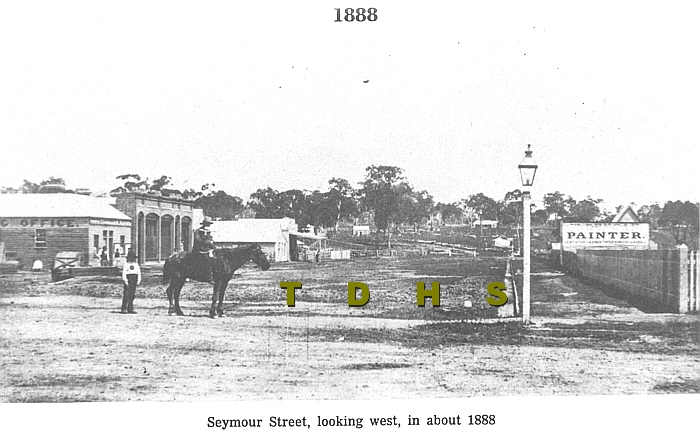
PHOTO: Click on the thumbnail photograph, for a full page view of a photograph of Seymour Street, looking west, in about 1888.
I think that I should tell you here that a second chemist opened a shop in Traralgon in 1887 to compete with Mr. Paul Kleesattel. He was J. G. B. Duncan. When the Government sold the old Police Station yard in 1891, he bought a piece of the land and built his shop where Mr. Grant now has his chemist's shop. Mr. Kleesattel then built his new shop on the Seymour Street corner and, for the next fifty years, we had just two chemists, and although the chemists came and went, the two shops were always chemist's shops. Mr. Duncan's old shop and residence were pulled down by Mr. Ward the chemist, some years ago when he built his new shop there.
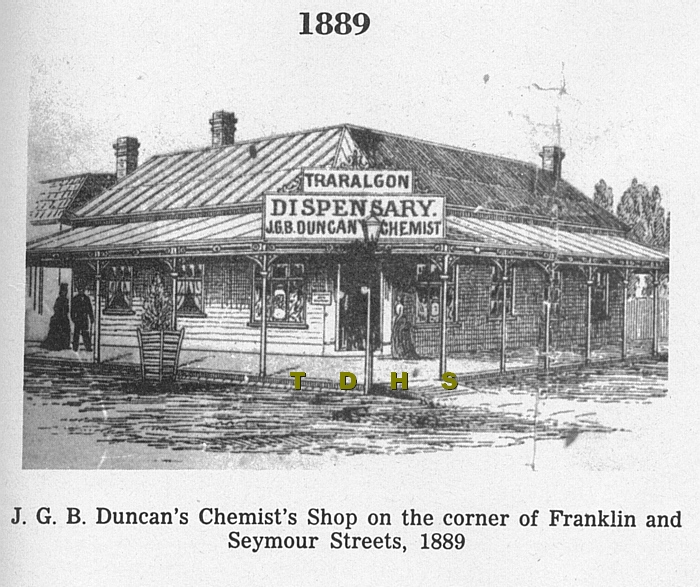
PHOTO: Click on the thumbnail photograph, for a full page view of a photograph of Mr. J.G.B. Duncan's Chemist's shop, on the corner of Franklin and Seymour Streets, 1889.
Probably our strongest Lodge in money and numbers is the Manchester Unity of Oddfellows. They, too, started up here in 1887, and one of their most famous members was Walter West, who joined in 1889. He became Grand Master for the State of Victoria in 1916, another honor to come to Traralgon.
And all this time the Traralgon Shire Council had been collecting £3 from the Government for every £I it gathered in in rates. They thought that they were going to lose it when some Shires up in the Wimmera, where destroying rabbits was costing them a lot of money, tried to come in on the scheme, too. So it might have ended up without there being enough money to go around. There was a big meeting held here in Traralgon by all the Gippsland Shires, and the usual big deputation went down to see the Government in Melbourne. But fate was kind. The Government kept up the money - Traralgon would have been in real trouble had it not done so.
For some time the Presbyterians had been dividing their services between the Church over in Campbell Street and the old Mechanics' Institute, and, in this year, they took over the Temperance Hall in Kay Street and held services there instead of in the Mechanics'. You all know the Temperance Hall which was the Presbyterian Sunday School for so many years, and which has now been moved around the corner into Church Street.
We now come to another name which is well known in the district. When a Police Station was first opened at Toongabbie in 1867 when the traffic started going through that way to Walhalla in greater numbers, Senior Constable Felix Keon was placed there in charge. In 1887, when Const. Donoghue retired to his home on the Highway near the present Racecourse, Senior Constable Keon came to Traralgon which, by this time, had two policemen on the Station.
Although Traralgon was still a small place, the people were bold enough to build wooden grandstand on the Recreation Reserve and also to put up a brick Mechanics' Institute.
It was a common thing in those early times for Councils to build a gas works so that they could light their streets by gas light as well as make a profit by selling gas to the public for lighting and cooking. A gas works engineer tried to get the Traralgon Council interested in 1887, and a public meeting was called. But the local people were not in favor, so nothing was done. Instead, the Council put in another kerosene lamp outside the Temperance Hall where the Presbyterians held Church.
At the end of 1887, James Parer took over the Grand Junction Hotel from Cornelius Neville. The Parers brought the first "safety bicycle" to Traralgon. Before that time, the only bicycles had been the penny- farthings and the bone shakers, and the arrival of the safety bicycle, our present cycle, helped to start the Traralgon Cycle Club. In a photograph which we have of the old Cycle Club, one lady has a type of tricycle with wooden wheels and with pedals on the front wheel. The Cycle Club was more of a social club, and outings were very popular with the ladies.

PHOTO: The Traralgon Cycling Club, in about 1898.
Early in 1888, the Council even went so far as to advertise in the paper its intention to ask the Government in Melbourne to build tramways from Traralgon to Callignee and from Boolarra to Mirboo. A survey of the line which it would take from Traralgon out through Traralgon South and up the valley of Stoney Creek showed that the grades would be too steep for the steam engines of that time, and the Council failed in its efforts. Callignee still had to depend on corduroy roads for many years to come.
I have already described Franklin Street as it was in 1883 to you. What a difference there was by 1888! Coming up from the south, you had the Grand Junction Hotel which also housed the National Bank. Then there was nothing on Steele's or the Bank corner, but there was a two-storied coffee palace in Hotham Street where the dairy is today. There were several shops in Franklin Street before you reached the first Crown Hotel. Then more shops and the Colonial Bank on the corner of Seymour Street. Around the corner to your right was Manning's butcher's shop and, further down, the coach-building works of West & Mayze. Returning to Franklin Street, there was Kleesattel, the chemist, on the corner, and then a series of shops right down to Peterkin's store where Clauscens are today. Around the corner in Argyle Street you found, first, the Commercial Hotel and, next door, the Star Hotel.
Starting at the Railway Station end and coming up the west side, there were shops all the way from the corner of Princes Street to Hotham Street where the old Mechanics' Institute was now a store. Across the road, the Club Hotel stood on the corner and there were more shops right down to Jeffery's corner. Around in Seymour Street we already had the "Record" office. The Police Station was across the street, and there was the police paddock which stretched to the Court House.
The other buildings of importance were the first Shire Hall, the Traralgon Hotel, and another store and the Bank of Australasia in Kay Street near the present Infant Welfare Centre.
In August, 1888, the Salvation Army started a Corps here in Traralgon, and the Army was active here until 1910. In the early days they had the support of the Army in Walhalla, and the Walhalla Salvation Army Band would often visit this town. Mr. Woodyatt, the storekeeper, complained to the Council that the Band frightened the horses in the street. The Army is now back with us after so many years absence.
These were the days when so many of our local bodies, which we now take for granted, were started. The Traralgon Fire Brigade, all volunteers, was formed in November, 1888. Each member had to Pay 2/6 to join and 1/- a month after that. Mr. James Dunbar loaned the Brigade a building in Hotham Street for a Fire Station, and the townspeople collected £160 and bought a pump which was worked by bars on each side of the firecart and 500 feet of hose. Just as well we had a Brigade a few years later when Traralgon had a really good fire. I will tell you about that later.
They seemed to be able to get money for everything. The Agricultural Society built a large wooden Exhibition Hall down in the Show Grounds, and it served its purpose right up until a few years ago, housing all the needlework and cookery exhibits.
The supply of water from the Railway reservoir was not good enough for the town, and every twelve months or so a move was started to get a Waterworks Trust going for the purpose of providing a good supply. The Council even asked the Shire Secretary to start the necessary steps to form a Trust in 1888, but nothing ever came of it, and it will not be until I tell you the story of the year 1905 that I will be able to relate how Traralgon first received the water from the Tyers River in 1908.
Now, at this time, the people of Traralgon had quite a choice of hotels - the Traralgon, Star, Commercial, Crown, Club, Grand Junction and Royal Exchange - but this was not enough. The gentlemen needed a Club as well. The Traralgon Club was started by Frank Hickox, and they built a timber and galvanized iron building in Argyle Street opposite the Star Hotel. Being built over the bank, it was single-storied in front and two-storied at the rear, and besides bedrooms for those who slept at the Club, there was also a tennis court and billiard room. But, with all the hotels selling beer until late at night, the Club lasted for only one year and then closed down because it did not pay.
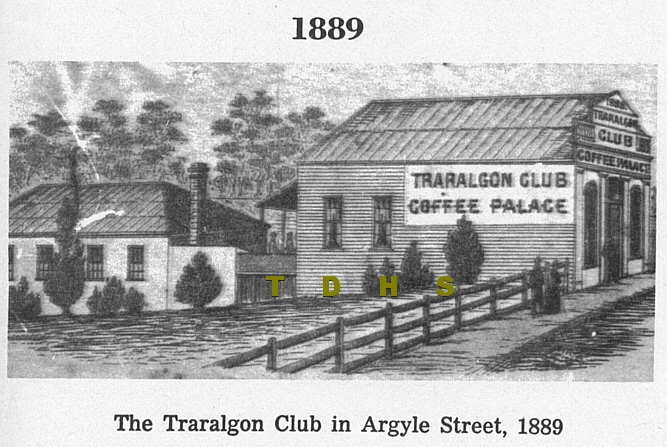
PHOTO: The Traralgon Club, in Argyle Street, in 1889.
From the beginning of 1889, the Traralgon Presbyterian Church which, up until that time, had been part of the Rosedale circuit, had its own Minister. Rev. J. G. Wilson from Rosedale moved here, and a search had to be made for a suitable manse for him. The Church did not have enough money to buy a place in the town, but it still owned the land given to it by the Government in 1871.
In 1890, a manse was built on the corner of Gwalia and Peterkin Streets, and when you go down Peterkin Street past the Scout Hall, you can see it there, standing on the site where the bark-roofed school should have been built instead of over in Campbell Street, although, of course, the Church sold that manse years ago.
The Bank of Australasia, now the A.N.Z. Bank, was built during this year. The Bank had started business in Peterkin's store in 1876, and then moved to its own building in Kay Street where Mr. John O'Brien lived until his recent death. His son, John O'Brien, now lives there. But when the new brick building was completed on the corner of Hotham Street, it moved there, and has been there ever since, although the old building was pulled down and a larger and more modern building put up in recent years.
And as the main thought of girls and boys each Saturday during the winter is the Traralgon football team, let me tell you that the first competition took place in 1889 when Traralgon, Morwell, Thorpdale, Trafalgar, Warragul and Moe competed for the S. Miller Cup. Morwell were premiers and Traralgon runners-up. And it was not until 1900 that Traralgon won their first premiership.
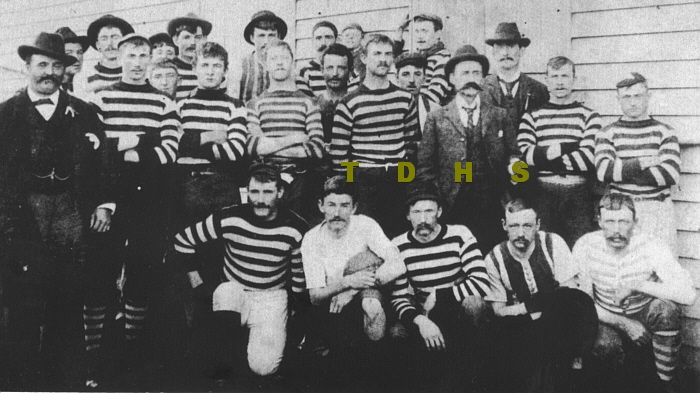
PHOTO: The Traralgon Football Team, in 1900.
By now, too, the land in Franklin Street near the Post Office was becoming too valuable to be left just as a paddock for the police horse, so the Police Station buildings were moved around into Kay Street where you have the new Station today. Next year the whole of the land was cut up into blocks and sold and, in no time, there were shops all the way down to the Court House.
The Council still could not make up its mind about a gas works, so it was left to Oswald Marriage, H. C. Jones, J. S. Milligan and other leading townsmen to form the Traralgon Gas Company and to build their own gas works. They chose the corner of Breed and Kay Streets which was all swampy, unsuitable for houses, and cheap. They were able to make agreements with the Council to change over the kerosene street lights to gas and, a few years later, to light the Railway Station, Post Office and Court House. But they were running at a loss after they paid the interest on the money that they had borrowed to build the works.
It was the object of every Agricultural Society to run the leading show in Victoria - called the Grand National Show. Traralgon Society, although it was formed only four years before, was given this honor in 1889, and in November it put on the Show. The Governor, the Earl of Hopetoun and his Countess were to attend, for this was the first Grand National Show ever to be held in Gippsland. But illness stopped the Governor from attending. The Council had prepared a beautiful address of welcome, too. Still, it was not wasted, for, in the following February, the Shire President and Shire Secretary and the President and Secretary of the Agricultural Society went down to Melbourne on the train. There they met the Governor, and Cr. Peterkin delivered his speech. Mr. Campbell, the Shire Secretary, handed over his address, and the Earl of Hopetoun even read the address he would have given if he had been able to make the trip two months before. It was not until 1894 that the Governor was able to keep his promise to visit our town. Some excellent trophies were competed for at this Show and the Drane family still have two of them which were won by Mr. Thomas Drane.
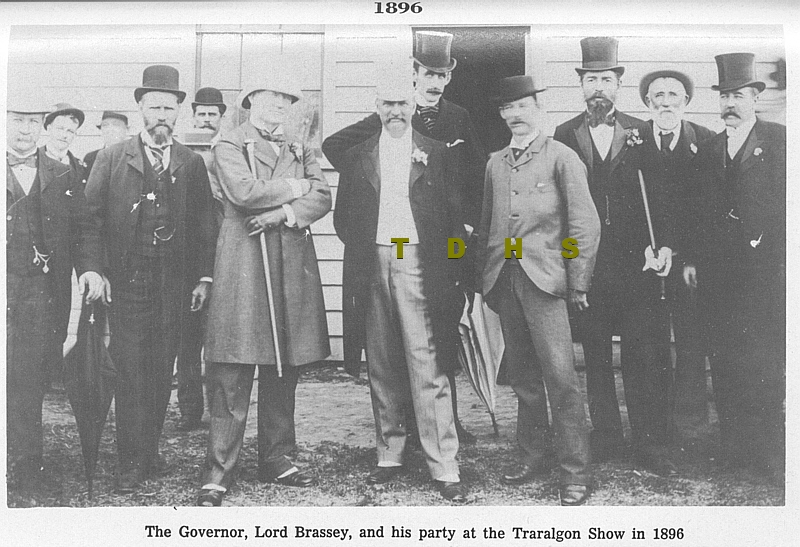
PHOTO: The Governor, Lord Brassey, and his party at the Traralgon Show in 1896.
Today we know exactly where all the brown coal lies around our town - how there is about 700 feet of coal not far below the surface at "Minniedale" on the road to Gormandale. Even in these early times, the people of Traralgon were looking for coal around the town. They knew that there was coal at Morwell and also at Boola Boola. They formed themselves into the Traralgon Coal Prospecting Association, and put down a bore themselves beside the railway line, close to the town. Nowadays the Government does all the boring, but, in those days, the Traralgon citizens thought that they could make money quickly by finding coal which was a little better than the brown coal which could be seen on the surface near where Yallourn is today. But our people found nothing and used up all their money. The Council stepped in, too, and asked the Mines Department in Melbourne to send down its diamond drill to help. The Department did send the drill, and it tried for coal around Rintoul's Creek.
I have told you how the railway made it possible to make butter in Gippsland and to send it to Melbourne for sale. Butter factories soon followed, but here in Traralgon our first factory was not built until 1890. Before this time, the Dunbars had a farm butter factory where the separator was worked by horse power. This was the first separator in the district, while the first hand separator was owned by Duncan Dunbar at Hazelwood. The butter made on the farms was sold by auction in the old auction mart in Seymour Street between the present "Journal" Office and Jeffery's corner where you will remember the Town Band used to practise. This home-made butter would sometimes bring only 3d, and 4d, per pound, and in summer time it was like oil before it reached the City, for the railways had not yet started using cool trucks full of ice to keep the butter cool during the summer.
Our first butter factory was started by the same busy people- among them were Hugh Dunbar, Edward Whittakers and John Peterkin, while Thomas Row was the Secretary. The factory was built at the east end of Seymour Street on the bank of the creek, and it became a bacon factory in later years, and then the bus depot until a few years ago. In its first year this factory turned out 50 tons of butter. As there were no separators on the farms, the factory bought the fresh milk, and the farmers took home the skim milk for their pigs and calves.
A second butter factory started up some years later when a Melbourne Company bought out the tannery. This was the Company which some years later built the large factory across the road from the Grey Street School. It stopped making butter there some years ago and the building is now used for making soft drinks by Alpine Aerated Waters. It was so many years before we had a doctor living in our town, but it was not until 1890 that the first solicitor came to live here. His name was Percy Pye Serjeant, and he started here as a partner with other solicitors who already had an office here. You see, solicitors from Sale had been coming to Traralgon for some years before this. In 1897, Mr. William M. Bruce joined Mr. Serjeant, and in 1907, Mr. Hugo Frost- Samuels of Morwell joined them. The legal firm of Serjeant, Bruce and Frost-Samuels served our town and district for years. Percy Serjeant's name comes up time and time again in the story of Traralgon. The firm is now called Bruce, Littleton and Hackford, the famous Serjeant name having been dropped.
In about 1890, the Town Tennis Club was formed and built its courts on the corner of Kay and Church Streets where there is now a service station. The leading player then was Barney Murphy, who worked for the National Bank, and he was good enough to go to England later on with the Davis Cup team. When these courts were sold, the Tennis Club moved to new courts around in Princes Street. These courts, too, have gone today, for the Bowling Club needed more land, and took over the courts.
In the middle of 1890, the people of Morwell were working to cut themselves off from Traralgon and to form a Shire for themselves.
The Morwell "Advertiser" printed a poem - let me give you the first verse:
"Dear Father, listen to the prayer
Of your ever grateful boy,
For all that you have ever done
To fill his heart with joy.
Your dear old face will always shine
Before my life for ever,
But Daddy dear, I've come of age,
And you and I must sever."
And so it goes on to complain that rate money collected in Morwell was spent in Traralgon, and so on. When the people of Morwell, headed by Mr. Murdoch, the builder of the Traralgon Long Bridge, had their notice put in the Government Gazette, the people at Mirboo decided that that would not suit them. They then asked to be taken over by the Shire of Woorayl on the other side of the Strzelecki Ranges.
On 25th January, 1891, the town was shocked by the death of Councillor Dugald Campbell who had been thrown from his horse. Although the Campbells were men of money, this did not prevent Dugald Campbell taking part in every movement which would assist his fellow citizens. His name has appeared so many times already in this story that you will not be surprised when I tell you that his funeral was the biggest that had ever taken place here up until then. A grateful public put their money together, and a very good portrait was painted of Mr. Campbell and was hung in the Council Chamber for all to see.
The Morwell people were still trying to get their own Shire. They had a petition drawn up for all to sign, and they insisted that anyone who signed it paid one shilling towards the cost of sending a deputation to Melbourne with the petition. Quite a good idea, don't you think? They were complaining that half the rates of the Traralgon Shire came from the Morwell and Mirboo areas, yet they had only three Councillors out of the nine. But the Government in Melbourne still refused to cut the Shire in two.
But 28th May, 1892, was an important day for the people of Morwell for, at long last, their efforts at getting their own Shire were rewarded. On that date the Government in Melbourne set up the new Shire, and Traralgon Shire was now just about half its previous size.
In the early Nineties, another factory was opened here for turning pigs into Bacon. Peterkin & Price opened a bacon factory on the corner of Campbell Street and Rosedale Road. This factory was followed in later years by another much larger factory. When the butter factory opened its new factory in Franklin Street in 1906, its old factory in Seymour Street was changed into a bacon factory by Mr. A. Saunders. The Saunders family carried on bacon curing there for the next forty years.
John Peterkin left Traralgon in June, 1892, instead of remaining here in retirement like so many of our senior citizens seem to do. His departure must have been a loss when we look back on what a great part he had played in our History. Shire Engineer, James Campbell, also resigned, and we lost another good citizen.
When Traralgon was first settled, there were thousands of koalas here. How many of you have yet to meet a koala up in the bush at Le Roy? The farmers shot hundreds of koalas just for their skins, and, in 1893, Mr. F. Shiells, the saddler, was advertising that he wanted to buy good skins at once. And the price he paid was probably about 3d. a skin.
This was the time, too, when the Council first started to use the old brick holes for rubbish. They picked Costin's old yard where the Sewerage Board Depot is now in Rosedale Road, and it soon filled. The Council was then able to use it for a Pound where horses and cattle found wandering on the roads could be locked up by the Ranger.
The Traralgon Gun Club was formed in about 1893, when shoots were held at the Recreation Reserve. Nowadays Gun Clubs shoot at clay pigeons tossed in the air by a machine, but live sparrows were used at these early shoots. There were no starlings here then. When starlings made their way into Gippsland, they could be trapped in thousands in nets when they roosted for the night on the reeds around the Gippsland Lakes, and the Gun Club then used starlings for its shoots. The Club held its shoots in later years up near Keys' Park, and in about 1914 it used land near the Cordial Factory Bridge. There were more moves - over the bridge at the north end of Franklin Street and elsewhere as houses were built and people objected to shooting going on at their back doors.
Our volunteer Fire Brigade moved into its new Fire Station in Princes Street in August, 1893. The old building was pulled down when the Brigade received its new brick station from the Country Fire Brigades Board in 1921, but the old fire bell was left in the Railway reserve for many years, and anyone who wanted to call out the Brigade could ring either the bell at the new station on the corner of Franklin and Argyle Streets or at the old one in Princes Street.
The Governor, the Earl of Hopetoun and Lady Hopetoun, were able to come and see Traralgon for themselves in 1894. We have a good photograph of them with other members of their party taken outside the Grand Junction Hotel. They can be seen ready on their horses for the ride out to Callignee. In another photograph, which was taken out at Callignee, you can see them there among the big trees, surrounded by the farmers from that small settlement.
During the last war, our country needed flax for making web equip- went for our soldiers, and farmers were asked to grow flax instead of other crops. There was a flax mill at Drouin where the flax was treated to clean the long tough fibres from the straw. Would you be surprised to learn that flax was grown hereabouts from 1895 onwards? The Woolf Brothers grew crops at Callignee and at Tyers. The Government was trying to make the crop a regular one among the farmers, and even paid them £2 an acre just for growing it. But flax was not a popular crop, and flax growing has never been a major crop in Gippsland.
We had our first big fire in March, 1896. It started in Price's butcher's shop in the centre block and burned down all the shops from Jeffery's corner and the Auction Mart, down to the brick wall at Hunt's, the hairdresser's. They were all wooden shops with residences at the rear, and belonged to Hewitt, the saddler; Kinna, the bootmaker; Price, the butcher; Hales, the baker; Barden, the draper; Miss Tanner, the dress- maker, and the storeroom of Bain & Macdonald. The Traralgon Fire Brigade was there and did its best with the water from the 1½ inch pipe from the Railway reservoir. Its equipment was just the old hand firepump which was called "Ethel" after Ethel Peterkin, and a newly arrived hand reel. That fire cost the people concerned £3,000 for their buildings and a further £3,000 for their contents - a lot of money in those days.
In 1896, the Presbyterians were able to sell the old Church over in Campbell Street, and with that money they were able to buy the Temperance Hall in Kay Street for £175. Mr. Sutherland Williamson bought the corner of Church and Kay Streets for £45 and made a present of the site for a new Church which was not built for nearly twenty years.
 The Council then decided to buy the Gasworks (picutred left). It cost £2,000 as a going concern, and was handed over by the Traralgon Gas Company in February, 1897. Some people were not happy about this and, after six months, they got up a petition against the Council buying the works. But the street lights were costing less, and there was enough profit to pay the interest on the money still owing. So the Council kept the Gasworks for the next sixty years.
The Council then decided to buy the Gasworks (picutred left). It cost £2,000 as a going concern, and was handed over by the Traralgon Gas Company in February, 1897. Some people were not happy about this and, after six months, they got up a petition against the Council buying the works. But the street lights were costing less, and there was enough profit to pay the interest on the money still owing. So the Council kept the Gasworks for the next sixty years.
Earlier in our story, I told you a little about Walter West. In April, 1897, he won a Council election, and became a Councillor. He thus started on his long career with the Traralgon Shire Council. All the very old boys and very old girls of the Traralgon School will remember their teachers, and it was in about 1897 that Mr. Smithwick, who took over from Mr. Dwyer, left Traralgon. The next Head Teacher was Mr. A. Birrell, who was here for about eight years.
The Boer War had now started, and one famous man left Traralgon for the War. He was Dr. H. R. Horne, who was given quite a send-off at the Club Hotel before he left for camp in February, 1900. He had a romantic career before he returned, for he even went to China to help in putting down the Boxer Rebellion. He was stabbed there by a Boxer rebel, but lived to return here to practise again as a doctor. He met his death here in a motor car accident while driving one of those early motor cars out along the Highway near Sheepwash Creek.
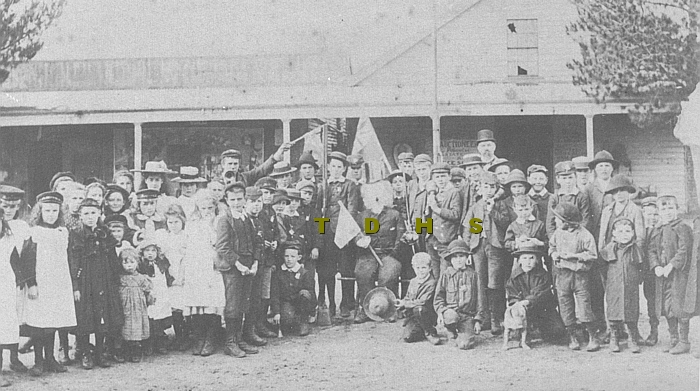
PHOTO: Traralgon school children celebrating the Relief of Mafeking in May, 1900.
In September, 1900, James Rogers, the grandfather of Mr. H. D. Rogers, became licensee of the Star Hotel. He will be mentioned again in connection with this hotel in our next chapter.
This was the year that Traralgon won their first football premiership. Mr. T. W. Ord, who was licensee of the Club Hotel, was President of the Club, and he gave a cup for competition. There were only three teams in the competition - Traralgon, Toongabbie and Gormandale, and Traralgon defeated Gormandale to take the cup, In 1899, the previous year, Traralgon had been playing in the Morwell Association for the Hall Cup, the teams being Traralgon, Morwell, Boolarra, Yinnar, Toongabbie and Gormandale, but our team won only six matches out of sixteen played.
Now, I have taken you through the first twenty years of the Shire of Traralgon when Traralgon grew so rapidly that, by the year 1900, it was quite a good country town, far larger than Rosedale, its early rival, but still a long way behind Sale, which was a borough already in 1863.
In my next chapter, you will read about Traralgon - the Country Town, and I will take you up until 1936 when the secret was let out- the Australian Paper Manufacturers Ltd, was about to build a big paper mill here.
Before I start to tell you this part of our story, I should take you back again into the last chapter. You will remember how everything was booming, and how blocks of land were selling like hot cakes. Then the bubble burst, and many of the banks closed their doors, for every one wanted their money at once, there was not enough money in the banks to pay them. People with money in some banks lost it all. And, when something like that happens, it takes years and years for things to come right again. The Traralgon banks closed their doors, but, fortunately, they all re-opened again after a while, but people were not now too ready to spend their money in building shops and factories.
And so our town really stood still for years.
But the Railway Station, which had been put up in the Seventies when the railway first opened, had become too small to handle all the passengers and parcels, and in February, 1901, a new weatherboard Stationmaster's Office and parcels office were built. Those buildings are still there today. An extra piece was put on the Melbourne end of the platform too, for the trains were getting longer with the new carriages. Maybe the time will come when a new railway station will be built here, perhaps even on the town side of the line where it should have been built in the first place in 1877.
I have not told you of the Traralgon Rifle Club which was holding shoots at this time. They used to fire their rifles from the flat over near the High School, and the targets were up on the hill where Hilltop Reservoir is now built. For targets they used large iron discs. If the shot was a miss, there was no sound, but, if it was a hit, you could hear the ring in Franklin Street. There was no road along the creek flats to Traralgon South then, the road being that which passes the High School and takes you out to the tip, and which you have heard called the "Switchback". When the Rifle Club moved from this range the butts were set up close by the Princes Highway west of Traralgon and near the Golf Club property of today. Following a rifleman, by accident, shooting two dairy cows instead of two target bulls, this range was also evacuated.
A new road had now been constructed over the Traralgon Creek flats, and the targets were moved to Koornalla, where there was no danger to travellers and little to stock. Later still, two further moves brought the range nearer to Traralgon, the first being along the same road seven miles from the town, and the second on to Mr. N. Thompson's property, where big bore shooting still takes place.
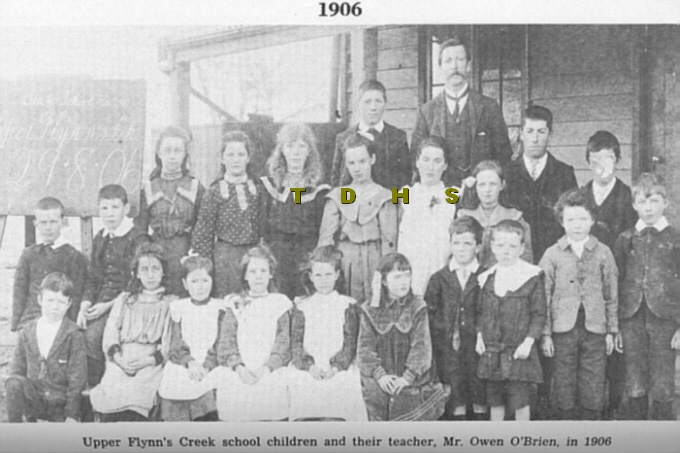
PHOTO: the Upper Flynn's Creek school children and their teacher, Mr. Owen O'Brien, in 1906
At the end of this year, the Junction Hotel at Flinnstead was closed. The State School carried on the name as "Flynnstead" for years, but the district is now known as Flynn.
On 27th April, 1902, St. Michael's Convent School was opened by the Sisters of St, Joseph. They had 35 pupils for a start. A cottage and a block of land had been bought, and the school was built on the land and the cottage was enlarged to serve as a convent.
The Boer War ended in May, 1902 and, by that time, about ten men had left Traralgon for South Africa. One was killed. I have already told you about Dr. Horne leaving here for the war, but among the list of the soldiers I find well-known names like King, Christensen, Lang and Drane.
It was in August, 1902 that Walter West was elected Shire President. This was the only time he was President for, when he became Shire Secretary some years later, he had to give up his position as. a Councillor.
Early in 1903, the Railway Department decided to bring their repair depot here from Sale. This meant that the engine drivers and firemen and the turners and fitters and cleaners all came here too. Some of these. men were to come here from Warragul as well, and both Sale and Warragul were up in arms. Deputations were sent down to Melbourne, but the Railways were not going to be told how to run their lines. So the depot was built here between the Railway Station and the creek, and Traralgon became a "Railway" town, so many of its people were working for the Railway Department, The coming of so many Government workers with wages being paid so regularly was certainly welcomed in Traralgon, and, of course, the new people were soon to take a large part in running many sporting bodies and other societies here.
Among those railway men from Sale was Mr. West, who was the secretary-treasurer of the Sale Baptist Church. He invited Rev. W. S. Rollings, the Minister of the Church at Sale, to visit here, and Baptist services were held in the Mechanics' Institute. This was the beginning of the Baptist Church here.
Peterkin's old store on Clauscen's corner was occupied at this time by a man named Ikey Owens, and it was not a credit to Traralgon for it was very much in need of repair. In 1903, Mr. J. Colvin took over the store and pulled it down. He built a quite impressive building in its place for his Gippsland Trading Company. He also had shops at Warragul and Maffra at this time. He sold his Traralgon store to the Coupars, and the Gippsland Trading Company under Mrs. Coupar and her son Les was our biggest shop here for the next thirty years. There was also a branch at Walhalla.
Traralgon has had a hundred or more different societies and clubs - far too many to list here, even if I knew them all, and, quite truly, I do not. So I will slip one in here and there in our story. In 1903, the citizens formed a Musical Society which held competitions here which lasted a week. P. P. Serjeant, the local solicitor, was one of the leaders in this Society.
The next Shire President was E. S. Whittakers, of "Fernhill". This was his first term, and he became Shire President for five further terms. Like his father William Whittakers, who came here in 1871, "Ned" Whittakers did more than his share in helping to run our town and shire.
At the end of this year, Mrs. Fuge did not bother to take out a further licence for her Sportsman's Arms Hotel at Tyers. I told you in the last chapter that the old brick hotel is still to be seen there. It was a stopping place for the coaches running between Traralgon and Walhalla.
Although we had many changes, Traralgon always had two doctors from the time when Dr. Montgomery came here to share the work with Dr. Morrison. In March, 1904, Dr. Thomas A. McLean, father of Dr. Trevor McLean, bought the practice of Dr. W. A. Spring. Dr. McLean Snr., served the people of Traralgon for the next forty years and, during World War I, when our second doctor, Dr. Henry Hagenauer, enlisted in the A.I.F., Dr. McLean had to care for all our citizens on his own. Dr. McLean played football for Geelong before he came here, so he was a star in the Traralgon team. He was a leader in the Town Band, and was also Secretary of the Racing Club for thirty years.
In May, 1904, the Traralgon Literary and Debating Society was founded. It had about fifty members. H. R. Sandford, the solicitor, was the first President, and Dr. T. C. Anderson the second President, and Mr. Lampe, the Head Teacher of the State School was the Secretary. The Society even put on the trial scene "Bardell v. Pickwick" for one of its open night. When the Orchestral Society and Minstrel Troupe was formed in July, 1905, to try to raise money to buy instruments for the Band, there was a movement afoot that the three Societies should join together and run competitions.
The wooden Star Hotel with its Masonic Hall was burned down in January, 1905. Mr. James Rogers, the licensee, rebuilt the hotel, this time in brick. This brick hotel also caught fire so many times during its existence that it was known as "The Burning Stump". After the hotel lost its licence in about 1920, it became a coffee palace, and has since disappeared to make way for a service station.
We now come to the first steps to obtain a good water supply. There were a number of ideas put forward, One was for the pumping of water from the creek near Seymour Street or at the top end of Franklin Street. Then there was a proposal for a reservoir on the creek near Dunbar's "Homestead". A further idea was a pumping station on the Latrobe River, which was, at that time, a nice clear stream. But Mr. A. K. T. Sambell, the Shire Engineer, had the best scheme - to run the water all the way by gravity from a weir built up on the Tyers River. Up there, the river winds about in its gorges and, by tunnelling through a hill, a good drop for a start could be obtained in a very short distance. The Council thought it was an excellent idea, but many people in the town thought otherwise. They even formed a Property Owners' League to fight the Council. So the Council asked the people to vote twice on the idea, and the Tyers scheme was favored each time.
As a result the Council asked the Government in Melbourne to set up a Waterworks Trust, a body of local citizens who could take charge of the whole idea and who could tax or rate the people who owned land which was likely to get water when the pipes could be laid all the way out to the Tyers River.
The Lodges were still taking part in every procession that marched up Franklin Street on special days. In April, 1905, the Ancient Order of Druids established a Lodge here. All of the original members are now dead, but Mr. C. H. Welch and Mr. A. Dunbar were leading Druids in later years, but they are now dead.
The Golf Club was reformed in 1905 when the Campbells of Traralgon Park gave the club permission to play on the park.
Then there was another big fire in the central block in Franklin Street on 23rd October, 1905. Gilbert the baker, Bicknell the jeweller, McFarlane the hairdresser, and Ellis the fruiterer, were burnt out. The fire was stopped before it could burn down Mr. H. E. Henden's newsagency.
In January, 1906, the Baptists were able to open their church on the corner of Church Street and Hotham Street. The church sold this corner only recently and the shop of Office Systems has been built on the site. The old wooden church was taken away and was used to build sheds on farms.
We now come upon a name that is well known in Traralgon - Marsh the Butcher. In 1906, G. H. Marsh bought out J. Manning who had his butcher's shop in Franklin Street where Croft's have their self-service store today. Marsh had been managing Redman's butcher's shop before this time, and some years later he bought out J. W. Grubb & Co, who had their butcher's shop next door to the A.N.Z. Bank.Here G. H. Marsh, his sons and grandsons have carried on the same service to the public for nearly sixty years.
Another bank opened in Traralgon in 1906. This time it was the Union Bank, and it started in a shop in Franklin Street opposite the Grand Junction Hotel. When the National Bank joined the Colonial Bank in 1918, the Union Bank moved down into the old National Bank building next door to the Court House. But the Union Bank has now gone. It joined up with the Bank of Australasia a few years ago to trade under the new name of the A.N.Z. Bank, and the old bank premises have now become a shop again after nearly fifty years.
The Australian Natives Association is another Lodge which has a branch here in Traralgon. The branch was formed in 1906, and some well-known and respected citizens, among them Peter Dunbar, Alfred Cross, Thomas Standing and Duncan Christensen, all now passed on, were active members in their day.
In 1907, Walter West took another step forward in his long career when he became Shire Secretary to relieve A. K. T. Sambell, who had been carrying on both as Shire Engineer and Shire Secretary. Of course Mr. West was still secretary of the Mechanics' Institute. At this time, too, Mr. F. Burnet was manager of the Colonial Bank. He had two famous sons Mr. Alan Burnet, of Glengarry, and Sir Macfarlane Burnet who, as you all know, received the Nobel Prize in Stockholm as a result of his work in the study of disease.
On 15th May, 1907, the Government in Melbourne set up our Waterworks Trust. There were the six Shire Councillors and Mr. J. S. Milligan on the Trust, and they set the scheme going. Nine and a half miles of pipe line had to be laid out to the weir on the Tyers River where two tunnels had to be made.
The Traralgon people were still looking forward to that railway over the range. This time it was to run from Traralgon to Meeniyan through Carrajung and, to help pay for it, the people along the line were to pay 10/- an acre a year. The Council was not too happy about this idea, and did not push the scheme with the Government in Melbourne as hard as they might have done.

PHOTO: the Koornalla School, in about 1906.
In 1908, Mr, Charles Du Ve, the Clerk of Courts at Rosedale, retired. Although he was not a Traralgon citizen, he had been a Gippslander for many years. After managing a cattle station at Benambra, he came to Rosedale, where his first Government job was as poundkeeper in 1867. He was appointed Clerk of Courts at Rosedale in 1872, and opened the Courts at Traralgon, Morwell, Moe and Mirboo North, and also visited Toongabbie. He was, of course, an authority on the history of the early days in Traralgon, and he often wrote stories for the "Journal" and the "Record" fifty years ago Those stories have helped in my writing this story for you.
Let me take you along Franklin Street in 1908. On the corner of Princes Street was "Scotty" Macdonald's general store. T. G. Cobbledick could be found in his workshop where Jim McDonald's Kyama Milk Bar is today. Then came Miss Ray, who sold drapery and ladies' wear, Childs who sold out to Russo and Santamaria, fruiterers, William Thomas, the tailor, the "Journal" Office, C. H. Welch, the jeweller and watchmaker, who had bought out H. M, Hewett, then the Union Bank, then Bert Ennis, the tailor, and H. O. Cornell in the old Mechanics' Institute on the corner. He sold out soon afterwards to H. W. Bond.
Across Hotham Street, the Club Hotel, where William Clues was the hotelkeeper, was on the corner. There were several shops in the hotel building. A. McLean & Co., the auctioneers, being in the first, then Harris, the hairdresser, a saddler's next door, and then H, E. Henden's newsagency. From there you found W. Ellis the fruiterer, McFarlane the hairdresser, H. Ladson in his bootshop, P. G. Bicknell the jeweller, G. White the painter and paper-hanger, T. R. Gilbert the baker, Neilson the butcher, Wallis the saddler and Christensen and Bowden on Jeffery's corner.
After crossing Seymour Street, you would see J. S. Milligan's store on the corner, John A. Kay, chemist, Robert H. Ikin the tailor, Fraatz the boot repairer, Marsh the butcher, Cleveland the hairdresser, Mrs. Joe May in her fruit shop, D. J. McCarthy the plumber, E. Clarkson the photographer and then H. White & Co.
Now you should return to the other end of Franklin Street to the Grand Junction Hotel, The National Bank was in the hotel next to Woolworth's Apparel Stores, Grogan Brothers had the drapery and grocery there in those days, and F. and E. Grubb, plumbers and hardware, were on the corner. Across Seymour Street, the Bank of Australasia was on the corner, and next door were J. W. Grubb & Co., butchers. Then W. Hewett, the saddler was beneath the upstairs offices of Serjeant, Bruce and Frost-Samuels, the solicitors, and you then came to Theo B. Little & Co., the auctioneers; Dan Bouscarle in his boot shop; H. R. Sandford, the solicitor; the Crown Hotel, Shiells and Menardi, saddlers; Ralph Kinna, the bootmaker, and then the Colonial Bank on the corner of Seymour Street. When you crossed the street, you came to James Brinsmead, the chemist, on the corner, then Miss Childs; E. T. Stammers, the tailor, then J. Mayze & Sons, the coachbuilders, where the State Electricity Commission is today. Across the lane to A. L. Cross the baker; W. "Starry" Christensen in his mart, and you finished with the Gippsland Trading Company on the corner.
Now that we have new saleyards on the road to Rosedale, it is interesting to look back fifty years or more, The council was looking for five acres of land in the town for such yards even as far back as 1888, but, in 1908, the Council very nearly bought land for the yards. Conferences were held, and also public meetings, and, in April, 1908, the Council even held a poll when the ratepayers voted on the matter. But it took fifty years for the Council to squeeze out the auctioneers and the private saleyards that they held here and there in the town, including the huge square where the Civic Centre is now built. Of course it was necessary for the future of the town that good yards for the sale of cattle were here to bring trade. Market Day was always the busiest day each week, with a huge crowd of buyers and sellers down at the saleyards, and the wives and daughters of the farmers crowding the stores on their weekly visit to town to do their shopping. Maybe it was fortunate for the Borough that the large Town Square was kept for saleyards for so long, so that the Borough Council was able to use it for our Civic Centre.
A public meeting was called in 1908 to see if a Bowling Club could be started. Mr. E. J. Box, the State School head teacher, was the leading spirit, and there was great support given by other citizens. A green was constructed where the bowling greens are today, and the club was opened later in the year. The first President was Percy Serjeant, the solicitor, and Mr. Box was the secretary. Bowls was such an important sport here that, when the club held an excursion to Walhalla, the Council declared a public holiday here to allow the citizens to go to Walhalla with the bowlers.
I know that the boys of the town all have an interest in fishing. Fifty years ago, the Traralgon Creek was deep and dark, covered with ferns and full of deep holes where the big blackfish lay among the logs. It is not like that today. The opening up of the Creek valley, the cutting down of the timber and the bush fires have caused the heavy rains to fill up the creek with gravel, and the floods have filled in all the deep holes. And the big blackfish have all gone. However, in 1908, it was decided to try trout in the creek to add some variety to the fishing. Percy Serjeant was in this too and helped the Fisheries Inspector to release 1,000 trout in the creek. Two years later, Arthur French, a dentist who used to come here regularly from Melbourne, caught the first of these trout, and some say, that for this reason, his name will never be forgotten by Traralgon anglers.
In October, 1908, we had another big fire here in Franklin Street. This time it was in the Post Office block, and the shops of Cleveland, Fraatz, Barker, McCarthy and Cobbledick went up in smoke. That would be the area from Croft's down to Bambit's, but Clarkson the photographer's shop was saved. The Fire Brigade still had to use their old hand pump to pump water out of the underground wells behind the shops, for the water from the Tyers River did not reach the town until a few weeks later.
And what a difference it made - the pressure was so great that the stream of water from the hoses at the next fire nearly blew over the walls of a burning house in Princes Street.
Now I told you how in 1864 the miracle of the magic wire, the telegraph, first reached Gippsland, and how, eleven years later, in 1875, Miss Kate Campbell had a telegraph sounder placed in her little Post office in her father's house in Argyle Street. It was not until 1909 that the telephone first came to Traralgon, and, when telephones were placed in houses in the town, Dr. Hagenauer was No. I and Dr. T. A. McLean was No. 2.
In November, 1909, the first State Savings Bank was opened here in Hotham Street. There was an old cottage on the land, and it was pulled down and a new brick bank built. When the bank opened, all the Savings Bank accounts which had, until then, been held at the post office, were taken over by the bank. The bank which was built in 1909 was pulled down only recently to make way for the new building in Hotham Street. The new bank in 1909 opened forty new accounts on its first day.
The narrow gauge Railway line from Moe to Walhalla was opened in 1910, and this also changed the lives of the Traralgon citizens. It meant that the coaches from Traralgon out through Tyers and Happy Go Lucky soon stopped running. And, when Walhalla started to fold up, quite a number of houses there were pulled to pieces, loaded on the train, and brought round to Traralgon where they were re-built.
It was at this time, too, that the Traralgon Fish and Game Protection Society was started. Because some people were fishing and shooting ducks out of season, the local sportsmen formed the Society with Mr. Bert Coates as secretary. The Society is still going, and, now that the blackfish have gone from the creek, the Society has done a lot in keeping it stocked with trout.
For the last couple of years, some of our people had the idea of setting up an electric light plant for Traralgon. The scheme was to use the water of the Tyers River out at the water supply intake to drive a turbine which, in turn, would generate the electricity which could be brought in by a line through the bush. Launceston in Tasmania already had its electricity generated by water power. But, if electricity were to come here, it would mean that the gasworks, which were owned by the Council, would have to compete with electricity. And the Council still owed £1,700 for the gasworks. And there was all that money to be paid for the new water scheme. And there was also the cost of the tramway from Dunbar's to bring road metal into the town for the making of Franklin Street which was all mud in wintertime. So the idea was just talked about for the next few years until, when the Great War started in 1914, all ideas of electricity schemes had to be put off while the more important task of beating the Germans was finished.
In 1911, another well-known name came to Traralgon when Senior Constable Chenhall took charge of the police station from Senior Constable Murcutt. Senior Constable Chenhall served here until his retirement in 1922, and his son, Mr. W. J. Chenhall still resides here. In 1920 Mr. W. J. Chenhall bought Dan Bouscarle's boot shop, and he carried on his business there for nearly fifty years.
For some years the State School over in Campbell Street had been too small for all the schoolchildren in the town, and the infants were being taught in the Baptist Church. When the Traralgon Park was cut up and sold, the School Board of Advice was able to get the Education Department in Melbourne to buy the corner of Grey Street and Church Street.
There, in 1912, a big new brick school was built. It had six rooms, but soon became too small for the growing town, and in 1914 the old wooden school was moved over from Campbell Street and re-erected along the Grey Street boundary of the schoolground. The Franklin and Grey Street corner had been bought by the Shire Council, but the Council decided to give it to the Education Department so that the school ground now had streets on each of the four sides.

PHOTO: Grades 7 and 8 at the Traralgon State School with their teachers, Mr. Richard H. Griffiths, and Mr. Harold Tanner, in 1911.
Coursing with greyhounds after hares, was a popular sport at this time, and Mr. E. S. Whittakers allowed the Coursing Club members to blast out all the stumps on part of "Fernhill" and to fence it in for coursing. There were plenty of hares about, but they used to escape, and the Coursing Club used that ground for just one season. In 1914, the club ran open courses on Mr. Lang's property at Glengarry hoping to make enough money to buy hares for the enclosure on "Fernhill", but the Great War changed all that, and coursing, too, was forgotten for the time being.
The grand parade at the Traralgon Show always has quite a parade of new motor cars as well as the prize-winning cattle and horses. The first motor car appeared at the Show in about 1904, but, in 1913, the first motor cars were there as exhibits. They were Fords, and were shown by Messrs R. Farrin-Webb and Ike Cone. When cars started to be parked around the arena, the old timers in the buggies were not happy about it. The Agricultural Society held a special meeting on the ground, and a sign was placed there with "Cars" on one side and "Buggies" on the other. But, as the years went by, the post had to be shifted further and further around the fence until today it is not possible to get all the cars into the Showgrounds on Show Day.
As I told you earlier, the Racing Club bought its new racecourse up over the Maffra railway line in 1914. A proper course was laid out there and buildings built. Races were held there until 1936 when, because every race meeting was showing a loss, the Racing Club decided to sell its course and to pay off all its debts. This it was able to do, and the club was wound up. The late Dr. T. A. McLean was still the secretary at the time.
I should now tell you something about the Latrobe River. When Hobson came here in 1844, he had a mile wide morass at his front door. Swamp tea tree, reeds, lagoons - it was almost impossible to get through to the bank of the river. But there it was, a beautiful clear stream in the summer, full of logs from trees which had grown upon its banks and had fallen in over the centuries. Of course, those people in Sale and Melbourne who had thought of sailing steamers up as far as the Moe a hundred years ago had not really counted the cost of pulling out the snags. But, when the Government built the railway to Sale, all ideas of having steamers on the river taking away the carriage of goods from the railway could not be considered, and although many deputations went down to Melbourne seeking improvement of the river, nothing was done for years. And so each year the river flooded, and the mass of scrub held the water back for weeks at a time. As the farmers slowly cleared the river flats of the scrub and rushes, these floods spoiled their pastures year after year. A River League was formed in about 1890, but the farmers were unable to borrow money with which to do the work, and the first real step to stop the flooding was not taken until 1914, when a cut was made across one of the bends out near the Scarne. If the river should rise, the water could flow through the cut instead of right around the bend, and the first step had been taken to turn this land subject to flooding into permanent farms. But the Empire was soon at war with Germany, and the scheme for cleaning out the river was also put aside until the war was over.
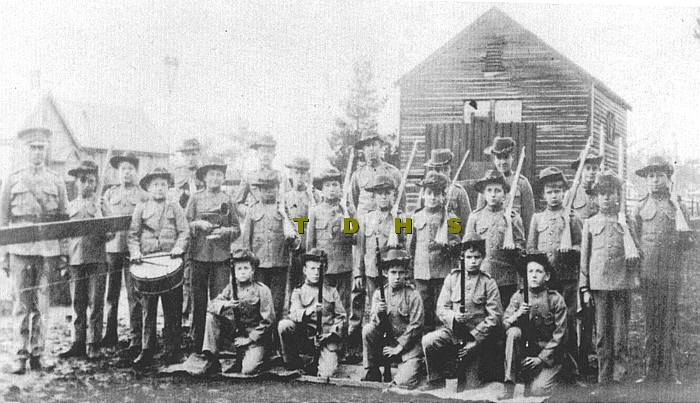
PHOTO: Traralgon State School Cadet Corps and their teacher, Mr. Edward J. Box, 1910.
The Council decided to do something about making the road in Franklin Street which was all mud in winter time. Carts became bogged in the street, and tea tree scrub was brought in and laid over the mud. It was decided to bring in the metal from Dunbar's on the creek, and the Council spent £1,500, which was a great deal of money then, in building a tram line to carry the stone into the town. The chief lament was, that that £1,500 would have made a lot of road.
In January, 1914, Mr, John Campbell died at the age of 93 years. He was a citizen who had seen Traralgon grow, for he and his brother Duncan had taken over the Traralgon West Run from James Purves in 1855. For many years he was a leading drover in charge of the mobs of cattle which were driven through the bush to the Melbourne market, But the droving was killed by the railway when it opened in 1878. For some years, too, his daughter Kate was postmistress first in the family home in Argyle Street and later in "The Retreat" in Kay Street.
In those days, the local newspaper printed the telephone directory on its front page, Here is the 1914 list:-
I. Dr. Hagenauer
2. Dr. McLean
3. Mr. Challman
4. T. B. Little & Co.
5. Christensen & Bawden
6. G. H, Marsh
7. Layton Bros.
8. L. Lay
9. W. A. Clark
10. The "Journal"
11. Whittakers Bros.
12. J. English
13. Shire Hall
14. J. D. Campbell
15. J. S. Milligan
16. Robert Farmer
17. Nurse Miller
18. Gippsland Trading Company
19. F. L. Grubb. Jr
20. Mathieson & Davis
21. P. Dunbar
22. Co-operative Store
23. T. G. Cobbledick
24. T. H. Row
25. Serjeant & Bruce
26. A. McLean & Co.
27. G. H. Monds
28. Grand Junction Hotel
29. Railway Station
30. Savings Bank
31. Butter Factory
32. Police Station
33. National Bank
34. Pentland & Canfield
35. C. E. Clarke
36. Clerk of Courts
37. The "Record"- J. W. Guest
38. A. J. Trood
39. F. Peiper
40. F. Grubb
41. J. Robinson
42. R. F. Webb
43. W. Christensen & Co
44. R. Widdis
45. Rev. W. J. T. Pay
46. Picone
47. W. McDonald
48. H. Campbell

PHOTO: Traralgon Hotel, which was built by Duncan Campbell in 1858. (This photo was taken in about 1913).
The most imposing building in the Traralgon of a hundred years ago was pulled down during 1914. I have told you how Duncan Campbell had built the "Travellers' Rest" in 1858 with redgum weatherboards sawn in the sawpit where the first Shire Hall was built twenty-three years later. There were already two brick hotels - the Grand Junction and the re-built Star, and Miss Hoare, who owned the Hotel, decided to re-build in brick. The hotel provided what was at that time thought to be the best in accommodation. It even had two bathrooms, and room for twenty outside sleeping compartments on the balcony. And the upstairs bedrooms even had fanlights for better ventilation. The hotel still has the same outside appearance as it did in 1914, but improvements have been made to the interior.
The Presbyterians were able to build their brick church on the corner of Kay Street and Church Street in 1914 after having put up with the temporary accommodation for so long in the Temperance Hall, which then became the Sunday School.
The boys and girls of today show no surprise at the basketball competitions and the table tennis competitions. Fifty years ago quoits were the rage, and there were very strong quoit competitions running here in the town as well as with neighbouring places like Moe. When it started in 1914, the Great War caused the quoits to fold up too, and when the war was over, the competitions were not revived.
In March, 1915, the Traralgon Higher Elementary School was opened. The old school building which had been moved over from Campbell Street, had been altered and improved, and Traralgon really had a better Higher Elementary School at that stage than any other town of its size in Victoria. The new course in secondary subjects was largely for the benefit of the school children of Traralgon itself, for it was many years later that the system was started of bringing boys and girls in from the surrounding district by bus to the Higher Elementary School. The little country schools still had their eight grades, whereas Traralgon had Forms F and E.
St. Michael's Roman Catholic Church was created a parish along with Glengarry in May, 1916, when it was separated from Morwell. Fr. W. J. McLaughlin was our first pastor here, and he was to guide the destinies of the parish for the next twenty years. It was largely through his efforts that enough money was collected to enable the building of the present Church to be planned. In March, 1916, a new brick convent had been opened here just before the separation of the parish.
And all this time the Great War was the first thing in the minds of our citizens. So many of the young men of the town had left with the A.I.F. or the Navy. There were 232 who had joined up, and, of these, 52 did not return. Most were just young fellows who might have been playing in the football team - ages 18, 19 or 20. You remember them all on Anzac Day each year, and you will find their names on the War Memorial in the Kay Street gardens. The trees around the Grey Street school ground were also planted in memory of the boys who did not come back.
I should mention here one of our best known servicewomen, Sister McCarthy, who was a returned nurse from that war and who was in charge of the Infant Welfare Centre here for very many years on her return.
When the boys came home from the war, life in the town changed once again. Some of them started shops of their own; others sought land to become farmers. You already know how the large areas close to the town, which were used only for grazing, may have been one of the reasons why Traralgon grew so slowly. For the last seventy years, the Government has had power to step in and to buy large pieces of land like "Traralgon Park" and "Fernhill" and to cut them up into farms - we call it Closer Settlement. There has been very little of this Closer Settlement near our town until recently, but, after the First World War, the Government did take over some land for Soldier Settlement. One of the first near here was the farm at Tyers which was sold to Mr. H. F. Christensen when he came home from the war, But we had no big scheme here like the large Soldier Settlement out on the flat at Hazelwood South which meant so much to the prosperity of Morwell forty years ago.
In 1919, Traralgon were premiers of football once again. There had been no football during the war, and, when the boys came home we had a really good team. You will know some of them - Lou Bell and Bert Coates - they are still living here in Traralgon. At the end of this year, the Commercial Hotel and the Star Hotel, the two hotels in Argyle Street, did not renew their licences, and this left the town with its present four hotels and the Club Hotel, which was to keep going until 1932, when Mr, James Rogers bought it and pulled it down to make way for a modern shop.
Among the soldiers who were now running their own businesses here were David and Walter MacCubbin, timber merchants, J. B. Robinson the chemist, P. T. Remington the dentist and Bert Coates in his book shop. There were others too, but these five remained in business here for the next twenty years or more.
There are no saleyards in the town now, but it was not so many years ago that, on the afternoon of sale days, you might see a mob of pigs heading full speed along Church Street for the railway yards for trucking to Melbourne. In 1920, there were four separate yards. Mathieson & Davis had their office in the Club Hotel building in Franklin Street, and their yards were in Breed Street near Hotham Street. A. McLean & Co. were opposite Woolworth's Apparel store in Franklin Street, and their yards were at the corner of Hotham and Breed Street, opposite Mathieson & Davis. Theo. B. Little & Co., the third firm of auctioneers, were next door to the National Bank, and their yards were on the square where the Civic Centre is today. Skews & Patterson had their yards in Grey Street behind the Traralgon Hotel. And, although McLean & Co. and Theo. B Little & Co., joined up in later years and continued to use the Kay Street yards, Mathieson & Davis' yards were eventually taken over by Thomas Standing & Co., and we had two cattle sale yards here right up until the new sale yards beyond the Maffra railway line were opened in 1958.
Although the construction of the present sewerage system for Traralgon was not started until 1940, the idea of sewerage for the town was being considered in 1921. The sanitary service was costing the Council £12 a week, and they had thought that it might be better to spend that £12 in paying interest on a loan which could be used for putting sewers throughout the town. But the idea didn't get very far - the sanitary service at £12 a week was paying its way, so the Council left it alone, being very thankful that it did.
 PHOTO: of the official opening of the Fire Station in 1921
PHOTO: of the official opening of the Fire Station in 1921
We obtained a new fire station in 1921, when the Council gave the corner of Franklin and Argyle Streets to the Country Fire Brigades Board, and the Station was built by the Traralgon people paying half the cost and the C.F.B. Board the other half. You may have noticed how the doors on this old fire station were placed on an angle so that the fire engine could get a straight run into the three streets which lead away from the corner.
In the same year, the Fish and Game Protection Society built a hatchery on the Tyers River. This was a community effort - Mr. Bert Christensen giving the land, Messrs D. and W. MacCubbin a lot of the timber, and the Society most of the labour. The idea was to trap the big trout swimming up from Lake Wellington to spawn in the Tyers River and to hatch the eggs so that the fry could be released in the local creeks. This prompted the Fisheries and Game Department in Melbourne to build a second hatchery out at Traralgon South on the Traralgon Creek. These hatcheries later fell into disuse when the Department decided to do all its trout breeding at Snobs Creek near Eildon Weir. The biggest trout ever caught in Traralgon Creek was caught in 1921 by Mr. E. Bohlmann in the big hole at the junction of the Jeeralang Creek. It weighed 6 lbs. 1 oz.
In 1922, Walter West, the Shire Secretary, was elected as the Member of Parliament for Gippsland South, the first and only citizen to become a Member of Parliament. He served as our Member until an election in 1929 when Mr. Herbert Hyland, of Leongatha, opposed him. More people voted for Mr. Hyland than for Mr. West, and Mr. West lost his seat in Parliament. He returned to his former job of Shire Secretary which he held up until his death in 1934.
Mr. Herbert Hyland, who was later knighted by the Queen for his services, served as a member in the Victorian Parliament until his recent death. I feel that he would have been no stranger to many of you.
It was in 1922 that our second resident solicitor, Mr C. H. Ford Snr., opened his office here. For many years Mr. Percy Pye Serjeant had been carrying on the business of Serjeant & Bruce upstairs in a two-storey building where Learmonth's now have their shoe shop, and Mr. Ford opened his office in the room in Cobbledick's buildings on the corner of Service and Franklin Streets, the State Electricity Commission occupying the rest of the building in later years.
The new Church of England was dedicated on 7th October, 1922. It was to replace the old wooden church which had been in use since 1880, and was built by two young returned soldiers, David and Walter MacCubbin, who had established themselves in our town as timber merchants and builders.
We have the Gippsland office of the State Electricity Commission in Franklin Street nowadays, but, if we go back fifty years, we find that the S.E.C, was just beginning. A small temporary power house was built at Yallourn in 1923, but most of the towns in Gippsland had their own electric power houses. As you know, Traralgon had no electricity - just the gas works. The power lines from Yallourn soon started to stretch as far as Drouin in the west and Sale in the east. In 1923-24, electricity reached about twenty homes in Tyers and, before long, 300 houses in Traralgon were connected. And so the S.E.C. found it necessary to open an office here. The first manager, Mr. V. Crowley, was allowed to use part of the old Shire Hall until he could open a small office next door. After twelve months, the office was again moved into the old galvanised iron building in Argyle Street which had been built for the Traralgon Club in 1888. In 1926 it was moved again into the two storied brick building on the corner of Princes Street opposite the Grand Junction Hotel. The modern headquarters at the northern end of Franklin Street was built in 1938 when the S.E.C. purchased the old timber coach building works of J. Mayze & Sons, and the Traralgon office now controls the smaller Commission offices which have appeared in every important Gippsland town.
In 1923, Tom Standing, who had just left Wesley College, joined the Traralgon Football Club, and proved to be the best player that our team has yet produced. He played with the team for the next ten years and served for some years as captain. He played for the Gippsland team against the Wimmera League on several occasions on the Melbourne Football Ground, and won many football awards. Thomas Standing, Snr., his father, who had been here since 1903 as manager for Mathieson & Davis, stock and station agents, bought out his employers in 1923, and for some time traded as Mathieson, Davis, Standing & Co., although most of you are familiar only with the name of Thomas Standing & Co. I have already told you how the herd of pigs would race along Breed Street after the pig sales in Standing's yards on their way to the railway trucking yards. Mr. Thomas Standing, Snr., took an active interest in football, and for some years was president of the Gippsland Football League.
Another fine citizen comes into our story at this period. William E. Cumming, who lived here until his death a few years ago, was elected Shire President for the first time in 1923. He served in that Office for three further periods, and was a Councillor for over twenty years and a Commissioner of the Waterworks Trust - twenty years of dedicated service to his fellow citizens.
In June, 1924, the 1st Traralgon Boy Scout Troop was formed by Rev. J. B. Blundell of St. James' Church. "Pinky" Carruthers was the Assistant Scoutmaster, and the first four scouts enrolled were Clem Jones, Allan Bissett, Harold Downie and Alan Burge. Trevor McLean joined the troop soon afterwards. At the same time, a Wolf Cub Pack was also formed, the Cubmaster being Major G. E. Bruce. At times the Scout Troop and Cub Pack have almost folded up, but, due to the efforts of interested citizens, particularly Mr. and Mrs. Tilbury, the Scouts and Cubs have prospered in later years, with now nine Scout Troops here. The gift by Miss Newman of the piece of land on the east side of the creek has enabled a permanent home for scouting to be built for the scouts and cubs of today and the scouts and cubs of the future, although there are other scout halls in other parts of the city.
In early times it was usual for an officer of the Treasury in Melbourne to be stationed in country towns, to collect money due to the Government and to pay Government bills. He was called the Receiver and Paymaster, and his office was the Receipt and Pay Office. Here in Traralgon, the Court House was on one side of the Post Office, and the Receipt and Pay Office on the other, where the mail is now sorted. I am telling you all this because the last officer here was Mr. J. G. Keys, who was Receiver and Paymaster from 1890 until his death in 1924. The Clerk of Courts, Mr, J. E. Thomson, then took over the additional job. But Mr. Keys will be remembered, for he owned all that land near Cumberland Park. His widow gave the land - 13 acres in all - to the Church of England so that a memorial hall might be built there in memory of Rev. J. B. Blundell, but most of it has since been sold, and the offices of the Country Roads Board in Kay Street are on part of the land. She also gave a large block of land over in Hyde Park to the Traralgon Hospital. It has since been cut up into blocks and sold. These were fine gifts by Mrs. Keys to the town where her husband had made his home for 34 years.
It must have been a big day for the Fire Brigade in 1924 when the first motor hose carriage arrived. Up until then the hand-pump "Ethel" had been the pride of the brigade. But the Traralgon Fire Brigade did not get the new carriage as a gift - they had to pay £200 towards cost. In 1934, another new motor carriage arrived - this time a Dodge --and the old carriage was passed on to another brigade which was worse equipped even than our Brigade.
 Boys and girls of today give very little thought to the Mechanics' Institute. It has always been run by a Committee of local people who have been elected by those who chose to join and pay a small fee so that they could use the library, the reading room or the billiard room. In earliest times, the people had to use the two rooms next door to the Traralgon Hotel until the first Institute was built on the corner of Franklin and Hotham Streets in 1876. Traralgon then had its first public hall. When the new Mechanics' Institute was built in brick In 1887, it was the pride of the town. Here you could find the only public library and reading room where the newspapers could be read and where, in later years, the first moving pictures were shown on Saturday nights. The moving pictures were paying very well, but, instead of keeping this profitable show to themselves, the committee of the Institute decided to share the wealth with the Shire. In 1925 the Institute gave to the Council, free of charge, the land next door in Hotham Street, and between the Institute and the Council, the Town Hall and Council Chambers were built for £10,000. The Institute managed the hall and ran its own picture theatre there, with the result that, in twenty years, the whole cost of the building was paid off. You may not look on that building with pride after forty years, but it was built in the same style as the Institute so that the two buildings would match. The Committee of the Institute deserves every credit for its planning ahead and its generosity towards its fellow citizens.
Boys and girls of today give very little thought to the Mechanics' Institute. It has always been run by a Committee of local people who have been elected by those who chose to join and pay a small fee so that they could use the library, the reading room or the billiard room. In earliest times, the people had to use the two rooms next door to the Traralgon Hotel until the first Institute was built on the corner of Franklin and Hotham Streets in 1876. Traralgon then had its first public hall. When the new Mechanics' Institute was built in brick In 1887, it was the pride of the town. Here you could find the only public library and reading room where the newspapers could be read and where, in later years, the first moving pictures were shown on Saturday nights. The moving pictures were paying very well, but, instead of keeping this profitable show to themselves, the committee of the Institute decided to share the wealth with the Shire. In 1925 the Institute gave to the Council, free of charge, the land next door in Hotham Street, and between the Institute and the Council, the Town Hall and Council Chambers were built for £10,000. The Institute managed the hall and ran its own picture theatre there, with the result that, in twenty years, the whole cost of the building was paid off. You may not look on that building with pride after forty years, but it was built in the same style as the Institute so that the two buildings would match. The Committee of the Institute deserves every credit for its planning ahead and its generosity towards its fellow citizens.
I have told you how the first Traralgon tannery was built up at the north end of Franklin Street beside the creek. One of our early butter factories took over the old tannery and, in later years, it was able to exchange that land for the piece of land on the corner of Franklin Street and Grey Street which was owned by the Council. So the Council used the old butter factory as its depot and, in 1925, the Butter Factory Company was able to build a two storey factory on its new land which fell away so steeply that the top storey was level with Franklin Street. Of course you now know that that factory, which turned out so many tons of butter, is now turning out many bottles of soft drinks for Alpine Aerated Waters.
Coursing hares with greyhounds had died out during the first World War and, in 1925, the local coursing enthusiasts decided to form a plumpton. Dr. Hagen headed the move, and many prominent local citizens, among them J. S. O'Brien, M. Phelan and J. Fithie took part in the meetings. The Coursing Club had the use of the racecourse, and, during the next six years, held monthly meetings during the winter months. The financial depression, which struck the world in the early 1930's, and the growth of speed coursing in Melbourne were the eventual causes of the club being wound up.
After the first World War, some of the returned soldiers and sailors joined together and formed the Returned Soldiers and Sailors Imperial League of Australia. They wanted to make sure that those who went to the war and who did not return were not forgotten, and that those who had come back to Australia and needed help were still able to turn to their comrades for assistance. The soldiers in Traralgon formed their branch in August, 1926. Mr. Bert Coates was the first president and, from this small beginning, the branch here has grown and grown, with its own clubrooms, and a membership of over 300, possibly the strongest club here after the anglers.
The boys and girls at Grey Street State School have all heard of the Richard Canfield Memorial Prize given each year by the Rotary Club to the outstanding girl and boy at the school. Who was Richard Canfield? He was just a painter and paperhanger who came here to Traralgon ninety years ago. It was he who painted the interior of the Post Office and Court House when they were built. In later years he was a real estate agent, but he is remembered for the years of service he gave to the town. He was a Councillor and was Shire President twice, the first time in 1926, and when he died in 1943, the Rotary Club considered that his service to the community was of such a high standard that his memory will be kept fresh by the annual award of these prizes.
Although I have told you about the Crown Hotel when it was first built in 1884, when Hugh McAuley closed his Wheatsheaf Hotel and transferred the licence to the Crown, I must not pass by the period when Mr. Michael Phelan was licensee of this hotel. He first held the licence in 1927, and finally left the hotel in 1957 to live in retirement. The first Crown Hotel, a single storey wooden building, was pulled down in 1934 when the present two storey modern hotel was erected on the site.
The Latrobe River was still quite a clear stream and, as there were no Town Baths then, the Traralgon people would travel out to the Sandbank at Tyers to swim. The reserve, in the bend of the river between the two Tyers bridges is still there, but Yallourn and the Paper Mills together have ruined the river for swimming. The fishing in the river has never been really good, although, at this time, huge Gippsland perch and conger eels could be caught by "frog walloping" at night. The Fish and Game Protection Society decided to try to introduce Macquarie perch into the river, and, in November, 1927, a party of eight members went up to the Goulburn Weir, where they hooked 1002 perch. They were released in the Latrobe and they commenced to thrive, but the pollution from Yallourn proved too much. It killed all the weeds and most of the fish in the river, and the hopes of the Society that the Latrobe River would become an anglers' paradise were ruined.
The first step towards Traralgon becoming a city was really taken in 1928. Back in 1885, the shire was broken up into three parts called Ridings, and each Riding sent three Councillors to the Shire Council. Then, in 1892, the Morwell Riding was cut off and became the new Shire of Morwell. The two Ridings that were left still sent their three Councillors each to the Shire Council until the year 1928, when the central part of the Shire, where nearly all the people lived, was made into a new Riding, called the Town Riding. It, too, was given three Councillors, making nine Councillors once again. In the next chapter I will tell you how this move led to the cutting off of the central part of the Shire to form the Borough of Traralgon. The whole Shire could not be made into a Borough, for a Borough must not have a greater area than nine square miles.
In 1928, it was decided to do something to give a better water supply to the people in the Loch Park area. In hot weather, the people in the lower parts of the town drew most of the water direct from the pipes, and this often resulted in very low pressure in summer. So the Waterworks Trust built the water tower at the top of Henry Street. It would hold 120,000 gallons, and was able to fill up during the night to give water to the people on higher ground when those down in the town were all hosing their gardens.
The Royal Exchange Hotel was rebuilt in 1930, when the old building which had started off as a hay and corn store was pulled down, and a modern hotel built in its place. The brick rooms which had been built on to the old hotel by the licensee Peter Kelly seventy years ago were still left in Princes Street, and were used as part of the hotel for many years afterwards.
In December, 1930 there was another bad flood in the Latrobe. The people along the river were at last stirred into action, and they formed the Latrobe River Improvement League, of which Mr. A. G. Burnet was the secretary. This league organized the farmers, and they put up such a good case for river improvement that the Government in Melbourne decided to hold an inquiry. The eventual result was that the Government gave £46,000 to snag the river all the way from Yallourn to Sale, and to make cuts across some of the big bends. But worse was to come in 1934.
A town landmark disappeared in 1932 when, in July, the licence for the Club Hotel was surrendered. The wooden hotel had stood on the corner of Franklin Street and Hotham Street since 1879. It was pulled down by Mr. J. H. Rogers, who built three new shops on the site. T he old billiard room at the hotel was moved up to a block of land in Kay Street opposite Cumberland Park, where it was used for a house.
The two newspapers, the "Journal" and the "Record" were still running, the "Journal" from its office opposite the Grand Junction Hotel, and the "Record" from its office in Seymour Street. Mr. Edward Barbor, the owner and editor of the "Journal" bought out the "Record" in 1932. He closed the old "Journal" office, and ran only one paper - "The Journal and the Record" - from the old "Record" office. Have a look at your paper today, and you will see that it is still called "The Journal and the Record”.
The town was still growing, and every summer there was trouble with the water running out, despite the fact that the Henry Street water tower had been built only five years before. It was decided to put a wall across a steep valley on the east side of the creek to make a reservoir which could fill up during the winter months and also take all the spare water which came through the pipe from Tyers at night. And so the Hilltop reservoir was built in 1933, and, when it is full, it holds 12 million gallons.
In 1934, Mr. Walter West the Shire Secretary, died, and his daughter, Miss E. M. West, who had been working in the Shire Office for many years, was appointed in his stead. Many of you would have known Miss West, who died recently. She went to school over in Campbell Street, and she saw the town grow, And as she took such a large part in all the happenings in your town over the last 70 years and made local history one of her interests, she was able to help me to write this story for you.
The Crown Hotel was pulled down in 1934, and the present two-storey building erected in its place. Mr. Michael Phelan was the licensee at the time, and the new hotel was quite a meeting place for gentlemen visiting Traralgon on Friday nights while their wives were doing their shopping, all the shops being open until 9 pm in those days. The Crown was like a beehive until the police stepped in, with the result that about thirty of those gentlemen had to explain their presence in the hotel to the Magistrate.
Traralgon was soon to boom when the Paper Mills started up, so let me take you along the main streets in 1934. Down at the south end of Franklin Street, Richard Canfield had his estate agency, Raymond Farrin-Webb his garage, and Graham Silvester a tyre service. Starting then from the Grand Junction Hotel, Thomas Standing & Co. had their office in the hotel building in Franklin Street, and next door was Layton Bros. drapers shop and then their grocery. Around the corner John Row had his estate agency and acted as Registrar of Births and Deaths, and Secretary to the Cemetery Trust and the Agricultural Society, and then W. H. Plant & Sons had a timber yard which ran through to Princes Street.
On the other side of Hotham Street there was a dairy, and Cecil Coulson, the plumber was next door. The Bank of Australasia was on the corner. Moving north along Franklin Street you would pass Roy Marsh the butcher, then Herbert Lloyd the saddler, Serjeant, Bruce and Frost-Samuels the solicitors upstairs, W. J. Chenhall in his boot shop, Albert Jenkins in his delicatessen, and then the new Crown Hotel. H. Terrill the saddler was across the lane, then McLean & Little Pty. Ltd., the stock and station agents, where Mr. Dick Hill was chief and John McMillan his right hand man, and the National Bank was on the corner.
Across Seymour Street, J. B. Robinson the chemist was on the corner, then Mrs. Rayner's cafe, E. T. Stammers the "Wrong Side" tailor and mercer, J. Mayze and Sons coachbuilding works where the State Electricity Commission office now stands, Munro the baker, E. Osborne the hairdresser, Norman Berryman in his bicycle shop, Frank Reeder the butcher, Miss O. Marten who dealt in babies wear, the Blue Bird Cafe, and then the empty store of the Gippsland Trading Company on the corner. Around the corner William Ikin, the founder of our first bus services, had his garage, and then stood the old delicensed Star Hotel, which was then a coffee palace.
Starting again at the other end of Franklin Street, T. G. Cobbledick had his garage around the corner in Princes Street. The State Electricity Commission District Office was in the brick building on the corner, and Mr. C. H. Ford the solicitor was to be found in his office on the corner of Service Street. Across that street Alf Brereton the grocer was on the corner, then Walter Mathieson in his stationery business, Guiseppe Cincotta the fruiterer, Miss Louie Feldt the dressmaker in the old "Journal" office, Miss Bambrook the confectioner, Herbert Ennis the tailor and Miss Madge Holt ladies' wear on the corner of Hotham Street.
In Hotham Street, next door to the Savings Bank, J. C. Cuddigan had his store, then came Miss Josie Grace, a ladies' hairdresser, H.C. Kent the dry cleaner, then the Mechanics' Institute and the Town Hall, then E. Kennedy the baker, the Misses Rogers confectioners, D. and W. MacCubbin timber merchants, and Fred Judd in his bicycle shop on the corner.
Starting at Roland Hill's garage across the street, you would find William Mclntosh timber merchant and undertaker, and James Rogers was building his new shops on the corner of Franklin Street on the site of the old Club Hotel.
Going north in Franklin Street, the first shop was B. Johnson's fruit shop, then M. C. Brown newsagent, O. Gilpin Ltd. drapers, J. E. Vickers fruiterer, Rew Hunt hairdresser, J. Tomkins mercer, Alf Brown bootmaker, C. H. Welch jeweller, Geo White painter, Seth Plant baker, S. P. Stoddart butcher, Williams the Shoemen, Moran & Cato grocers, and then Jeffery's drapery store on the corner. In Seymour street, the only shop was D. O'Keefe, the boot repairer, in the shops beyond the "Journal" office. There were no shops on the other side of Seymour Street, and Bullock's the grocers were on the corner of Franklin Street. Next door was Fred Hesse's men's wear, then Layton Bros. men's store, W. J. S. Tanner in his garage, H. A. Peck hairdresser, H. T. Cooper Photographer, Miss Henderson ladies hats, S. Channing fruiterer, R. Farrin-Webb estate agent, Don Wallace bicycle shop and B. K. Coates stationer.
The boys and girls reading this story will now realise that there were no shops at all except in the central part of the town. All of the newer housing areas were yet to come. There was an old derelict shop in Bank Street, and another small one at the top end of Seymour Street and, apart from those, there was not one place of business away from the Franklin Street area. The modern idea of having a batch of shops in each new area did not reach Traralgon for another twelve years or more.
In December, 1934, the biggest flood of modern times hit Traralgon. It rained for nearly a week over the Mount Baw Baw area from where most of the water in the Latrobe River comes, and a few nights later a wall of water came down the river. The Princes Highway and the railway were washed away, the river flooded and filled up the Yallourn open cut, Morwell Bridge was flooded, and the old wooden bridges at Rosedale were all under water. Out near the Scarne, the Maskrey family were trapped in the ceiling of their home with flood waters all around. A truck rushed a fishing boat from Bairnsdale. It was taken off at Rosedale, and was rowed across the river there and brought on to Traralgon. It was launched again out at the Scarne, and the fishermen rowed it out to Maskrey's. They took some boards off the side of the house and rescued the Maskrey family, including young Jack, who in later years was to become Councillor Jack Maskrey. The flood backed up the waters of the Traralgon Creek too; and all the lower parts of Traralgon were under water, and bridges were damaged. After this near tragedy, the Government did do something about snagging the Latrobe in the hope that, if we ever had such heavy rain again, the river would never rise to the same level as it did in 1934.
In 1936, another well-known citizen sold up and left Traralgon. Edward Barbor, who had been a part owner, and then sole owner of the "Journal" since 1921 and who had bought out the "Record" in 1932, and amalgamated the two papers, sold out to Mr. W. A. Thompson, who had been a member of his staff for many years. In those days the "Journal" was printed on pink paper like the "Sporting Globe" of today, and Mr. Barbor and his pink paper were known throughout Gippsland. Mr. Thompson, who is well known to all of you, sold his ownership of the "Journal" a few years ago. I am telling you this to remind you how our local newspapers are the recorders of our history, and how important this can be, for we all like to tell others the stories of events that happened in the past, especially if we think we know more about them than our listeners.
But Traralgon was still just standing still. The depression, which had hit the world a few years before, was almost over, and there was more work about. Here in Traralgon the only industry of any kind was the railway workshops. Of course there were the butter factory and the bacon factory, but they employed only a few men. One citizen knew how Ararat and Beechworth both leaned rather heavily on their mental hospitals to keep the town going, and he realized how there was not one such hospital in all Gippsland. So he suggested to the Chamber of Commerce that here was a chance to ask the Government in Melbourne to do something about building the mental hospital for Gippsland here in Traralgon. Old Dr. McLean, of course, said that all that they would have to do would be to put a fence around the town, but, all jokes aside, the Chamber of Commerce did take up the idea. And now, nearly thirty years later, Hobson Park Mental Hospital has been built and has many patients.
We are now at the end of this chapter. In the next I will tell you the story of the Traralgon of which you know - the Paper Mill, all the new houses, and the new shops in Franklin Street.
End of Chapter 6
In the year 1936, Traralgon was just one of the country towns in our State of Victoria - a little bigger than Morwell, a great deal larger than Moe, but still a long way behind Sale, the Capital of Gippsland.
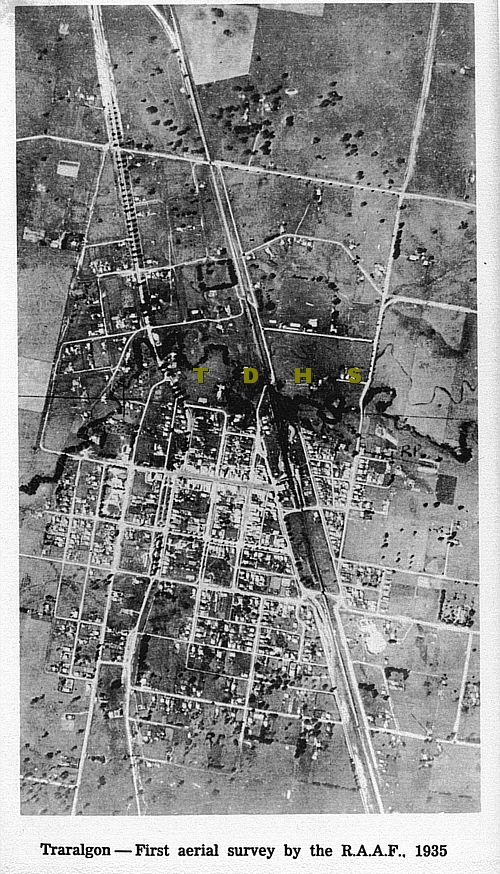
PHOTO: the first aerial survey of the town of Traralgon by the R.A.A.F. in 1935.
But, in December of that year, the Government in Melbourne made an agreement with a New South Wales Company whose name you now all know - The Australian Paper Manufacturers Limited. It was agreed that if the Company built a mill in Gippsland to make paper pulp out of the waste parts of the eucalyptus trees in the forests, particularly around Mount Baw Baw, the Government would make sure that they would be able to obtain enough pulpwood to keep going for at least fifty years. It was talked about in Parliament in Melbourne, and Parliament decided to pass an Act to make the agreement legal.
Nobody here in Traralgon seemed to know exactly how far this new paper mill would affect the town, or where it would be built. The Company eventually decided upon a site on the Latrobe River at Maryvale, which is the old name for the Morwell area, just over the border into the Morwell Shire. This was a blow to our citizens, for the rates which would be paid by the mill would be quite a good sum, and they would all be paid to the Shire of Morwell. But, when about 70 out of every 100 workers at the mill decided to live in Traralgon rather than in Morwell or elsewhere, the population of our town started to grow and grow, and this eventually meant more houses, more shops, more schools - and, of course, with all those pay envelopes being spent here each week, more prosperity for all.
Many people in Traralgon left their jobs to take on a job at the Mill, and, for the first time this century, there were more jobs in the town than men to fill them. New faces were to be seen everywhere. Before the Mill was built, few people came and went, and everybody knew everybody else. At school, the same children attended year after year. But when the new families came here, every week there would be new boys and girls starting at our schools.
The most impressive building in the town was completed at this time. St. Michael's Roman Catholic Church was opened by Bishop Ryan of Sale. Mr. John Dwyer, a staunch member of the Church, had left £3,000 in his will, and this enabled the Traralgon Catholics to build in stone from Briagolong, a Church, which would stand on its corner for centuries, the colour of the stonework getting better as the years go by.
The Racing Club had been losing money when it held race meetings upon the new racecourse beyond the Maffra railway line, and it was decided to wind up the Club at this time. The Club owned the racecourse, and it sold it by auction in 1939 to pay its debts. The 60 acres was sold for £940. Everybody was paid, and the racecourse was then used for grazing cattle. When horse racing started to boom again after the War, the new Race Club had high hopes of being able to buy back the course. But the cost proved to be too much, and eventually the Traralgon City Council took over the racecourse for the people of Traralgon and kept it in order.
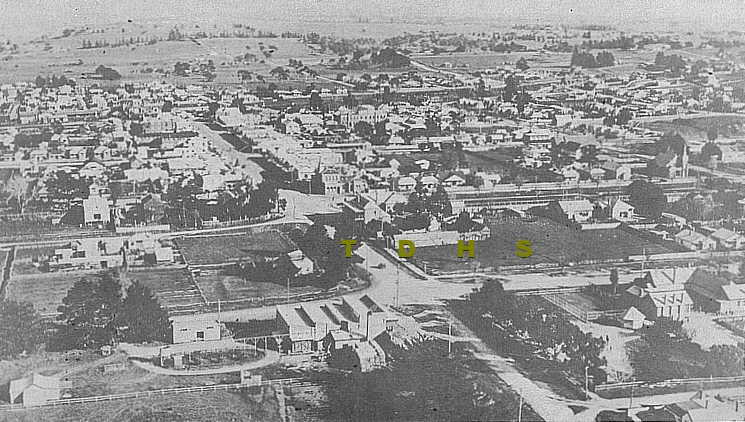
PHOTO: a remarkable panoramic photo of Traralgon. The Post Office building is clearly visible in the middle of the photo. The Mechanics Institute and Town Hall complex a little to the right above the Post Office. The Grey St schools in the lower right.
 The old Police Station, which had first stood on the corner of Franklin and Seymour Streets, was moved some years later to the land in Kay Street where the Police Station now stands.
The old Police Station, which had first stood on the corner of Franklin and Seymour Streets, was moved some years later to the land in Kay Street where the Police Station now stands.
But, by 1937, the old wooden building was much in need of repair, and a new Station was built in Seymour Street next door to the Vicarage. Senior Constable F. P. Sloane moved there when the old Police Station was removed from its site in Kay Street over to Livingstone Street where it was used as a private residence. Since then our present Station has been built in Kay Street and the Seymour Street Police Station has become the residence of the Sergeant of Police.
Out at the Paper Mill, a small mill called a pilot mill had started working by December, 1937, producing paper pulp at a rate of 10 tons a day. This mill was more of an experiment to enable the Australian Paper Manufacturers to find out all about this new type of pulp before the big mill was built.
In 1938, another type of greyhound racing was started. Up until now, any coursing had been carried out on the land where the racecourse is today, where pairs of greyhounds chased a hare and were given points for the way in which they chased and turned the hare. But this time many local citizens formed the Traralgon Speed Coursing Company which bought land on Park Lane. Here they built a greyhound racing track, and meetings were held at night under electric light. The hares were let go well ahead of the dogs which raced around the track after they were released from the starting boxes. This new sport in Traralgon drew greyhound racing fans from all over Gippsland, and greyhound racing was very popular every Thursday night until World War II started.
For many years, the young men of Traralgon had been training as soldiers. You will remember how there was at first a Troop of the Victorian Mounted Rifles here some eighty years ago, and how, later on, this became part of the 13th Light Horse Regiment. During the 1930's, military training was being increased, and a unit of foot soldiers, the infantry, was also formed here. These soldiers used to train in an old wooden billiard room behind a shop at the railway end of Franklin Street, where Maryvale Motors are now. This place was most unsuitable, and, at about this time, the Defence Department in Melbourne decided to put up a proper drill hall in Railway Street - a street which changed its name to Queen's Parade after the visit of Her Majesty to Traralgon in 1954.
I have already told you about the big flood of 1934. The Government in Melbourne had been stirred into action by all the damage that it caused, and it set up a Committee to hear what everyone thought to be the best way in which to stop the river flooding again. £46,000 was granted by Parliament in 1939 so that all the snags in the river between Yallourn and Sale could be pulled out. For hundreds of years huge trees had fallen into the river and had been washed down in the floods to become snags, and you all know that red gum takes ages to rot in water. There was also enough money left over to pay for channels to be cut across some small bends to let the water flow away more quickly. As a result, we have never had a really bad flood since that time.
During this year, the new Headquarters for the Gippsland Branch of the State Electricity Commission of Victoria was built. The Commission had been using a two-storied brick building on the corner of Princes Street and Franklin Street. There is now a service station on that corner. The coach-building works of J. W. Mayze & Sons, an old wooden building, had been bought and pulled down, and the fine offices for the Commission were built on the site. Mr. Mayze moved his works over into Mitchell Street, just down the hill from the hotel.
In January, 1939, we had one of the worst bush fires that ever ravaged our district. It burned out Jumbuk, Jeeralang, Koornalla, Callignee, Callignee North and Carrajung. It started west of Jeeralang on a roasting hot day and, with a 60 mile an hour gale behind it, it roared through the gullies and leaped from hilltop to hilltop, burning everything. Many of our hill settlers lost everything, but the people of Traralgon rallied round and helped to replace many of the articles of clothing and furniture that they had lost.
It was in this year that the people of Traralgon felt that their town was not keeping up with Morwell where sewerage had been installed, whereas Traralgon still put up with the night carts. The gentlemen who had been appointed to run the Waterworks Trust were also made the Sewerage Authority for the purpose of getting the scheme going. It was decided to lay big mains through the back yards in all parts of the town. These mains were to all join up down at the Long Bridge where there was to be a pumping station to pump the sewage up beyond the Maffra railway line. At that spot, there was to be a treatment plant, and the treated sewage was to be run out over the paddocks where it would soak away into the soil. It was thought that the whole job would cost about £52,000.
I will soon be telling you of more and more schools, but the first one which I must mention in this chapter is St. Michael's Convent. The increasing number of children going to the Convent school made it necessary for the Sisters of St. Joseph to have it enlarged to provide three classrooms and a hall, the previous Convent school, which had been rebuilt twenty years before, having become too crowded.
In 1940, big excavating machines arrived and started digging the trenches for the main pipes of the sewers. A factory for making concrete pipes was set up, and most of the older part of the town was finished ready for the connections to be laid from the houses. But the war had started, and, in 1942, the whole scheme had to be put aside until Victory had been won.
When they started to build the paper mill out at Maryvale, there were no empty houses in Traralgon in which the men could live. Traralgon had only about 2,000 people then. The A.P.M. decided to put up their own houses, and bought the land between Kay and Grey Streets for the houses of the manager, chief engineer, and the other head men. The A.P.M. also bought a large piece of land in Cumberland Park, and here houses were built for workmen. This part was really outside the town at this time - really out in the paddocks - and the A.P.M. even had to pay for their own water supply system for the houses, joining it on to the town mains. In later years, the Waterworks Trust took over this system from the A.P.M. The married workmen were placed in the new houses in Cumberland Park, but the A.P.M. built a large hostel for the single men down in Anderson Street across the creek. The Company found that it had to keep this hostel going for the next twenty years before selling it to a new owner who tried to make a success of running it as a motel.
When the pilot mill was being built, it became necessary to take the workers out from Traralgon each day. These men were not all from Traralgon - many lived in Morwell - but there were enough to fill several buses. The first Traralgon bus service had been started a few years before by Mr. William Ikin, who had a garage around the corner in Argyle Street. He had been running several buses since December, 1934, to bring shoppers from Yallourn and Morwell to Traralgon on Friday nights and Saturdays. This scheme had been helped by the Traralgon traders who gave back to the shopper half the price of his used bus ticket. Mr. Ikin had built the body of his first bus himself, and his later models were not much better. They were terrible buses in which to travel, but by now the war was on, and no better vehicles could be provided. Before Mr. Ikin started his bus service up Grey Street to the mill, the only kind of public transport by road were the hire cars and the mail cars which ran across to Yarram, through Gormandale and through Balook, and out to Tyers. The running of buses out to Maryvale made it necessary for the Traralgon Shire Council to improve the road beyond the turn-off to the Cemetery and Tyers along which there had been no traffic at all before the mill was built.
By September, 1939, the main paper pulp mill had been completed out at Maryvale, and it was starting to make paper pulp. Loads of pulpwood were coming in from all parts of the district by road as well as by rail, and the pulpwood truck was a common sight grinding its way up the Grey Street hill at all hours of the day and night.
You already know how our first chemist, Paul Kleesattel, after starting in the central block of Franklin Street, built his chemist's shop on the corner of Franklin and Seymour Street. In September, 1939, sixty years later, Mr. J. B. Robinson, the chemist, bought the shop from Miss Elsie Kleesattel, thus ending the long association of the Kleesattels with that corner.
The second World War had started in September, 1939. Soon many young men from Traralgon had enlisted in the A.I.F., the Navy, or the R.A.A.F. Familiar faces were missing, but it was not until 1942, when Japan attacked the Americans at Pearl Harbour that the war really affected Traralgon, when the militia units into which many Traralgon lads had been drafted were called upon to serve outside the Australian mainland,
The new Methodist Church on the Princes Highway had been completed, and it was opened in November, 1939. The old wooden church was left alongside the new one for use as a Sunday School, and in later years it was moved further back on the block to make room for a new hall. This corner is always of interest, for it was here that Thomas Windsor built his house in the1840's, where it was the accommodation house where travellers along the Gippsland Road stayed overnight, both while Windsor and then Peter Jeremiah Smith were living there, before Duncan Campbell built his Travellers' Rest on the Traralgon Hotel corner in 1858.
In 1940, there were about 350 children going to the Grey Street State School, and it became necessary to enlarge the school. New classrooms were built on the Grey Street side of the school. The old wooden building which had been brought over from Campbell Street some ten years before to be used as a Higher Elementary School was proving rather cramped, and further Higher Elementary School classes were now able to use some of the rooms in the State School.
The paper mill at Maryvale had started off by making paper pulp, and the next step was the building of a huge machine which would turn that pulp into paper. By the end of 1940, this machine was making brown wrapping paper in one wide sheet which was running out of the machine on to a big roller faster than you can run. I know that many of you have seen that machine out at Maryvale when you have been there on school excursions.
In September, 1941, the Rotary Club of Traralgon was formed. Its charter to carry on was presented to it in March, 1942. The first president was Mr. Roland Hill, and the first secretary was Mr. Hugh Linaker, the manager of the Gippsland Branch of the State Electricity Commission. The club, which is made up of men who are chosen because they are leaders in their trades or professions, has started various schemes for the improvement of our town. The best of these was to call together our citizens to form a Hospital Trust which led to the Government in Melbourne building a hospital here far bigger than the men of Rotary had ever imagined in their dreams.
Franklin Street was not a very bright place at night, and the traders decided to join together to take out all the poor lights under the shop verandahs and to replace them with hanging white glass bowls all the way down each side. What an improvement it made! It was called "The White Way", and it did really brighten up the street at night. But it was not used for very long for, as soon as Japan started the war against us, all street lighting had to be blacked out. So, for the next four years, the lights of "The White Way" just hung there, getting dirtier and dirtier and dirtier. On the day that Japan surrendered, "The White Way" was switched on in the middle of the day to celebrate the victory. "The White Way" is not in use today because the wiring is now too old.
A large town without a public hospital is seldom found today. However, for years Traralgon had put up with small private hospitals. The chief standby at this time was the Cumnock Private Hospital in Moore Street, which had been run for years by Sister Donovan, and there was also a smaller private hospital called "Ewington" conducted by Sister Fennell over in Shakespeare Street. Those people who could not afford to pay for treatment in a private hospital had to be sent to the nearest public hospital, the Gippsland Base Hospital, at Sale. The big hospital at Yallourn served the State Electricity Commission area only. The Rotary Club called its public meeting in June, 1942, when it was decided that a Hospital Trust should be formed. In the next four years this trust, which was made up of local citizens with Dr. T. A. McLean, Snr., as president, and Mr. Eric Burgess, of the State Electricity Commission as secretary, collected nearly £50,000 by public donations and grants from the Government. In 1946, the trust bought the ten acres of land on the Highway where it decided to build its public hospital with the money which it had in hand. In the meantime, Sister Donovan had to sell her hospital, and in later years it was run by our three local doctors - McTeigue, McLean and Considine - until the new hospital was ready to be opened.
In 1943, it was decided to try to reform the Racing Club, some townspeople thinking that, by holding a race meeting, money might be obtained for patriotic purposes for use in our war effort. Although there were some who thought that the idea was ridiculous, a new club was formed and a strong committee with Mr. Jim Cuddigan as president and hard-working Mr. Reg Collier as secretary held the first meeting on the Traralgon race course by permission of Mr. Ike Cone who then owned the land, and they made a profit of £450. Further meetings were held during the war, and much of the profits was passed on to patriotic efforts and to charities such as the Blind Institute. Since those days the race club has progressed to the stage where it is able to run meetings eleven times a year. It is now one of the strongest country racing clubs in Victoria. Traralgon City council took over the racecourse for the people of Traralgon in October 1964, and it will now be kept and used for all kinds of sport for all time.
Although Edward Hobson had come to Traralgon 100 years before, there had never been a factory of any kind here to make anything to send away to sell in Melbourne. Of course you will want to point out Peterkin's sawmill, the bacon factory, the butter factory and the railway workshops. The paper mill at Maryvale might be thought to be an attempt to build up a local industry, but in 1944, a Melbourne company was persuaded to start a factory here. La Mode Industries Pty. Ltd, were able to use the drill hall when the Volunteer Defence Corps of old soldiers, who were ready to stop any attack by the Japanese on Gippsland, was disbanded, and the company commenced making ladies' brassieres with five girls from Melbourne who, in turn, taught the local girls. Within two years, seventy girls were working at La Mode, and in a town like Traralgon, where there was so little work for girls except in the shops or out at the mill, this new method of using female labour certainly helped to find jobs for so many Traralgon girls who might have had to go to Melbourne to work or to stay here with no chance of finding a job. In the following year, La Mode built its own factory, here in the town, but times changed, and the factory was closed down because it was found to be much cheaper to make goods in Melbourne than in the country. It has now been re-opened by Kayser.
I have told you how the A. P. M. built a large number of houses in Cumberland Park for its workers. In 1945, it was still impossible for people not working out at the mill to find an empty house, and the Victorian Housing Commission took over a large piece of Traralgon Park in Gordon Street. The Commission called for people to give a price for building houses there, and Mr. J. J. Clift from Melbourne was successful in getting the job, Mr. Gavin Blythman, his foreman, came up from Melbourne, and work was started. The Commission built 199 houses in this particular part of the town, the scheme in this area being finished in 1952.
The war finished at the end of 1945, and many of the soldiers, sailors and airmen were given Commission homes on their return home. Traralgon had played its part in winning the war - 405 men and 16 women served in the army, 19 being killed; 111 men and 6 women in the air force, of whom 8 did not return, and 5 men in the navy, one of whom, Ross Berwick, was a member of the crew of H.M.A.S. "Sydney", and was reported "missing" when that ship was lost in the fight with the "Kormoran". Our effort for King and Country was not a bad one for a Shire, which had a population of less than 4,000, but, of course, you must always remember that Australia, with but 7,000,000 people then, had 1,000,000 in the forces. One out of every seven men, women and children was serving his or her country. There was probably no other country in the world with one-seventh of its people in the forces.
When the men were returning home from the war, the Legion of Ex-Servicemen and Women was formed, chiefly to help and continue the comradeship for those who could not join the R.S.S.A.I.L.A. because they had not served in any war area. A branch of the legion was formed here in 1946 and, although it did not have as many members as the R.S.L., its members were very active in looking after the interests of servicemen.
You will remember how I told you that a counting of the people, a census, is held every ten years. It is usual to hold it in the year ending in the figure "1", but the war prevented the 1941 census being held until 1946. The total number of persons in the whole of the Traralgon Shire at the 1946 count was 5,396 and, of these, only 700 did not live in Traralgon. Today the city of Traralgon has 14,600 people - quite a gain in twenty-five years.
In 1946, it was decided that the future Civic Centre for Traralgon would be on the Traralgon Creek with Mill street and Argyle Street as the boundaries. Seven acres of land was bought there by the Shire Council, and plans were made for building a modern Town Hall to replace the Town Hall in Hotham Street. In the meantime, the land was to be laid out as a park with lawns sloping gently down to the creek.
At this time Mrs. Black, of Traralgon South, presented to the Traralgon Boy Scouts the old State School ground at Koornalla. The school had been taken away many years before this date, and Mrs. Black had been renting the land from the Education Department. This area is of particular historical interest, for Count Strzelecki's map shows that he crossed the Traralgon Creek in this locality in 1840 after he had been trying to find his way over the Callignee Hills with his horses. There is a monument to Strzelecki outside the Scout Reserve. The scout committee built a hut from tent floorboards bought from Army camps, and regular camps were held at the reserve by the local Scout Troop.
During the years of the war, the banks had to close up branches in some towns where there were really too many banks for the number of people. But none were closed here in Traralgon where we had the National Bank, the Bank of Australasia, the Union Bank and the State Savings Bank. When the war was over, the banks began to open new branches where they were needed. Traralgon was starting to grow quickly, and in October,1946, the Commercial Bank opened here in a shop next door to the Crown Hotel. Since then all the other banks have come here for, like you, they felt that Traralgon would soon become the chief city of Gippsland. We now have, in addition to the banks I have mentioned, the Bank of New South Wales, the Commonwealth Bank, the Commercial Banking Co, of Sydney, and the English, Scottish and Australian Bank.
Traralgon was 100 years old in 1944. As you remember, Edward Hobson and Hugh Reech arrived here -with their mob of cattle in about June, 1844. All thought of celebrating that event here in Traralgon had to be put off because of the war, and it was not until December, 1946, that our Centenary celebrations were held. Under Councillor H. J. Saunders as president, and Mr. Harold Hanning as organiser, every committee and club in Traralgon joined together in making the celebrations a success. Each was required to send two members to the first meeting. At that meeting committees were formed to handle decorations, entertainments and to welcome home returning former residents.
An Historical Committee was also formed, and that Committee set out to write the first History of Traralgon. That history was the beginning of a much bigger History of which this story, written especially for the girls and boys, is taken. The celebrations lasted for a week, and included the Centenary Show, a floral carpet, an historical exhibition, a race meeting, back-to-school, and a Coronation Ceremony when the Queen of Victory was to be crowned by General Sir Thomas Blamey. He became ill and Councillor George Purvis, from Moe, the founder of Purvis Stores, who was the president of the Shire of Narracan, acted in his stead. The Governor of Victoria, Sir Winston Dugan, came up from Melbourne, and one of his acts while here was to visit the site of our hospital where he turned the first sod to start the work that, in later years, resulted in the building of our hospital which cost £1,500,000.
In 1946, Miss Eva West resigned as Shire Secretary, thus bringing to an end the long association between her and her father, Walter West and the Traralgon Shire Council. I have told you how Walter West was first elected a Councillor in 1897, and how he became Shire Secretary in 1907, an office which he held until his death in 1934, when his daughter followed on as Shire Secretary.
The land at the bottom of the Kay Street hill had always been a swamp. In early times, the coaches had quite a job getting through the mud on their way from Morwell along the Old Melbourne Road. After the end of the First World War, the Council put in a drain which ran right from the swamp through the Chinamen's gardens in Traralgon Park to the creek. Because it was dug by men who had been soldiers at the War, some people called it the "Suez Canal".
This land belonged to Mr. J. E. Thomson, who was Clerk of Courts here until 1927, and, when he died, the Council bought the land for use as a park. When the big tunnels were being dug for the sewerage mains, a lot of the clay and soil was carted to this swamp, and it was not long before it was filled in. In 1947, the Traralgon Tennis Club asked the Council if it would let the Club have some of this land for seven years so that it could build some tennis courts there. The Bowling Club was cramped for room down in Deakin Street, and when the Tennis Club built the two new courts over in Kay Street, the Bowling Club was able to take over the old tennis courts and to extend its green right out to Princes Street.
In May, 1948, the Boy Scouts were able to build their first hall. Up until St. James' Hall was burned down in 1937, they had met there. But the generosity of Miss Ellen Newman, who had given the Scouts a large piece of land on the east side of the creek enabled plans to be made for building a hall there. In the meantime, they had held their meetings in various places, including the old shire hall. The Scout Committee had made plans for a log cabin like that which had been built for the scouts at Moe, but logs were rather costly, and there was not enough money in hand for that to be done. However, Mr. Duncan Cameron, who was a builder, and his sons who were in the Scouts, helped by many willing hands, brought in an old house from Gormandale, and re-erected it on the land which is now called "Newman" Park", and since that date the scouts have always had a home of their own.
 Dr. T. A. McLean passed away in August, 1948. He had come here in 1904 as a young doctor, fresh from Geelong Hospital. He had played football with Geelong and was, of course, a star player with Traralgon. During the years of the First World War, he was the only doctor in the town, Dr. Hagen having joined the A.I.F. He knew the private lives of most of our citizens, and had played a leading part in many committees and clubs. He was also chairman of the local Justices of the Peace. The old white-haired doctor could look back on forty years of service to the town, much of it without any reward other than the thanks of the people he was serving, both as a doctor and also as a townsman.
Dr. T. A. McLean passed away in August, 1948. He had come here in 1904 as a young doctor, fresh from Geelong Hospital. He had played football with Geelong and was, of course, a star player with Traralgon. During the years of the First World War, he was the only doctor in the town, Dr. Hagen having joined the A.I.F. He knew the private lives of most of our citizens, and had played a leading part in many committees and clubs. He was also chairman of the local Justices of the Peace. The old white-haired doctor could look back on forty years of service to the town, much of it without any reward other than the thanks of the people he was serving, both as a doctor and also as a townsman.
It was also at this time that the first ice works was opened in the town at the bottom of the hill in Grey Street behind the Butter Factory. Before this date, ice had always to be brought from Morwell.
You already know that the Traralgon Rotary Club was founded in 1941, and how the Rotarians set about doing things for the town.
There was also a similar club called Apex, and it was decided to start an Apex Club here as well. The Apex Club of Bairnsdale set the Traralgon Club going in October, 1948. Young men of Traralgon who were ready to work hard for their town joined in, and the club received its Charter from Apex in March, 1949. Mr. Ian Archibald was the first president and Mr, Jack Mole the first secretary. They were both engineers here with the State Electricity Commission. One of the first jobs taken on by the Apexians was the cleaning of the "White Way". The big globes had not had a good wash since they were put up nearly ten years before.
So many boys wished to join the Traralgon Cub Pack that, in February, 1949, another pack was formed. Mrs. F. A. Tilbury had been running the pack for some time, assisted by her sister, Mrs. C. Johnson. When the second pack was formed, Mrs. Johnson became "Akela" of the new pack, and the two sisters continued the difficult task of conducting both packs. In later years, a third Traralgon Cub Pack was formed with Mrs. James as "Akela" and Mr. Bruce Adams as "Baloo". It first met in Cumberland Park Tennis Club Hall, and is still a very strong pack.
The Recreation Reserve or, as you know it, the Showgrounds, was proving too small for the needs of the town. In 1950, extra land was bought on the south side where you now find all the sideshows on Show Day. The playing area was re-formed, and a bicycle track laid down around it. The old grandstand, which had served for fifty years, had been pulled down, and the Traralgon Football Club built a new stand there, the first of a series of buildings to be erected at the reserve.
The Apex Club realised the need for a further playing field in our town and, in 1951, it took on the job of preparing Apex Park up in Grey Street. It cleared the land of trees and stumps, laid out and fenced the oval, and handed it over to the people of Traralgon ready for the playing of sport.
Nowadays we have taxi and bus services throughout the town, but seventy or more years ago we had "Bait and Livery Stables" where a horse could be hired for riding, a buggy hired for driving, or where you could put up your horse for a feed or for the night. Of course, the hotels also provided a stable and a feed of oats for the horses of travellers lodging for the night. The largest of the livery stables was that of Mr. E. Roberts who sold out to Mr. Peter Dunbar. It was a large wooden building in Hotham Street opposite the Town Hall and, in later years, became Mr, Roland Hill's garage. In 1950, Mr, Hill pulled down the old building after it had been severely damaged in a storm, and erected the first part of the modern Roland Buildings on the site. This new building contained a cafe as well as a garage in its lay-out, with offices upstairs, and was the first of a number of new buildings containing shops and arcades which were erected in Traralgon after the war. Mr. Hill completed his buildings in 1956.
The bricks made from Traralgon clay are renowned for their quality and have been used widely throughout Gippsland. You can see these bricks in the walls of the Court Houses in Traralgon and Warragul. However, for some years a new type of brick made from sand and lime, cooked in a steam box, called an autoclave, had been made at Frankston. In 1950, Traralgon people were asked to put in their money to create a new company the Great Eastern Brick company, to make bricks here. The company set up its works on the south side of the town where silica bricks, as they were called were made by a staff of twenty men. The company now has fifty men engaged in brickmaking. One of the effects of this new type of brick being made here so cheaply was the closing down of the only clay brickworks left in the town. Mr. Reg Wigg was making bricks, and his clay hole and kilns were on the corner of Hickox Street and Bank Street. He sold out to Mr. Schwartz in 1951, and the last bricks were made there in 1958. The other clay holes around the town had been filled in for years, and this clay pit also has now been filled with rubbish from the town and has been made into an excellent cricket ground - the Duncan Cameron Memorial Oval.
In the same year of 1950 the number of boys wishing to join the scouts made it necessary to form a 2nd Traralgon Troop. Normally a scout troop. has 29 scouts in four patrols of seven scouts with a troop leader, but that number was quite insufficient. The 2nd Traralgon Troop shared the hall and all the other facilities owned by the 1st Traralgon Troop. But there are now nine troops here, the 3rd Boy Scout Troop, which was formed in 1952 serving the Cumberland Park area and the 4th Troop being attached to St. Michael's Church.
The Governor had turned the first sod on the land set apart for the Traralgon Hospital in 1946, and his successor, Sir Dallas Brookes came up here in September, 1950 to lay the foundation stone of the new building. A large hospital had been planned, and it took six years to build it.
Most of the boys and girls reading this story went to kindergarten before they started school, but, if they had been very young before the year 1950, they would have had to wait until they were nearly six years of age before they could attend any school. However, in November, 1950, the first kindergarten here was started in the Presbyterian Sunday School Hall in Kay Street, and since then, of course, many other similar kindergartens have been opened for our small children.
More children were attending school here, and the Grey Street State School was not able to hold them all. The Education Department built the first separate school up in Stockdale Road, and it was opened in 1951 with Mr. A. Womersley as head teacher. It was intended to be only for children in grades I to 4 who would came from the Housing Commission area and the A.P.M. houses. The older children still had to go to the Grey Street school, but 193 small children attended Stockdale Road school in its first year.
This transfer of the smaller children to Stockdale Road fitted in quite well with the raising of the Higher Elementary School to a High School in the same year. There were now 2l7 boys and girls going to the High School in the Grey Street School where Mr. H. E. L. Jones, its first principal, carried on under difficult conditions while steps were being taken towards finding a piece of land on which a separate High School could be built.
In October, 1951, the Bank of Australasia and the Union Bank joined together under the name of the Australia & New Zealand Bank. You will remember how the Bank of Australasia opened here first in 1876, while the Union Bank did not open its branch here until 1906. With the merger of the two banks, both branches kept open here for some time until the Union Bank premises were taken over by the Colonial Mutual Life Assurance Society, which altered them and built two shops on Franklin Street which are now occupied by Dunn's Heating, and O.P.S.M., while the Colonial Mutual Society has its offices in the part which used to be the residence of the bank manager.
Up until this time, there had been no school in all Gippsland for training retarded or spastic children. The citizens of Traralgon formed a committee which decided that it was time that something was done for these boys and girls. A special school was started for them in the Presbyterian Sunday School Hall in 1952 where, at first, five children were helped to become good citizens. This school grew and grew until, in 1957, a special building, "Cooinda Hill" was built. The school now has 50 children in attendance, some from as far away as Moe and Mirboo North.
In August, 1952, South Eastern Milk Products took over the Traralgon Butter Factory. By this move, the company intended to change the factory into a depot for bottling milk for Traralgon. The day of the sale of milk in billies was going, and bottled milk would soon be the rule. This meant that, instead of picking up cream in cans from the farmers, the company began collecting milk in big tankers. I told you earlier how the opening of the railway to Melbourne in 1879 enabled factories to be built to make butter which could be sent to Melbourne on the train for sale. And now, after 80 years, the making of butter at the Traralgon Butter Factory was soon to cease. There was now to be no skim milk on the farms to be fed to the pigs, and you will notice how this change of the butter factory into a milk bottling depot must have affected the kind of goods which the farmer could now sell. In August, 1963, South Eastern Milk Products opened a large new factory on the Glengarry Road, and it then closed down the milk depot in the town. The old butter factory has now become a cordial factory.
You may remember how the Salvation Army met in Traralgon from 1888 to 1910, when the local corps was disbanded. Early in 1953, it was decided to re-open the corps, and an old army hut was erected in Roosevelt Street where 2nd Lieut. Doreen Johnston was the officer- in-charge of the new corps.
In the early 1920s, the Mechanics' Institute started showing moving pictures in its hall each Saturday night. Of course, there had been the odd travelling show here before then showing some special film like "The Great Train Robbery", but the Mechanics' Institute provided a show regularly each week. When the Town Hall was built next door in 1925, the picture show moved there, and the profits really paid off the Town Hall. Sometimes these picture shows were packed, especially in later years when films like "The Overlanders" were shown.
It was not long before private showmen who could raise enough money to build their own theatre stepped in, and Lawrence Brothers built the Valley Theatre in Grey Street. The comfort of the new theatre with its carpeted foyer was quite a change from the draughts and discomforts of the Town Hall, and although both theatres continued in opposition for some time, the competition proved too great. Traralgon was not large enough for two picture theatres and the Town Hall Pictures eventually closed down in August, 1953. Mr. Ted Conchie, our Boer War veteran, who is so well known to all of you, had been the manager of the Town Hall Pictures for over twenty years, and was forced to retire.
In this same year, another industry came to Traralgon. For many years it had been known that quite good limestone could be found, in the ranges at the back of Tyers, and the A.P.M. had a limestone quarry there. Some engineers thought that this limestone might be burned in a kiln with local brown coal and changed into cement. Many local people put their money into the new company called the Gippsland Cement and Lime Company. A cement works was built on the south side of the town, and the first cement was made by the staff of 50 in December, 1953. The limestone in the Tyers area cost a lot of money to get out, and the company found it cheaper to get its material from a bed of limestone in the Merriman's Creek area to the south of Rosedale. The cement works has grown larger over the years, and 125 men now work there.
There are many citizens in that part of the town who are not at all happy about the works being so close to the town, having regard to the dust that is made when the cement is being crushed, and the continued noise of the machinery, but our Councillors at the time who gave their permission for the factory to be built there might not have had any idea how the works, which brought so much work for the men of the town, would have turned out to be so unpopular with those people who have their homes near the factory.
On 3rd March, 1954, Her Majesty the Queen visited Traralgon on her first visit to Australia. This was probably the most important day in our history, and, on that day, there were more people here in Traralgon than ever before. Her Majesty could not stop to meet her subjects at every small town, and as Traralgon was one of the more important towns in Gippsland, people gathered here from all parts of the Shires of Rosedale, Traralgon, Morwell and Mirboo to greet her. The President of our Shire, Councillor Clem Little met and welcomed Her Majesty on behalf of all her loyal subjects here in Traralgon. The R.A.A.F. had flown the Queen up to Sale from the city, and she then travelled back to Melbourne by train. Our welcome to her took place at the railway station.
Another new school was opened in Kosciusko Street in March, 1954, to provide a school for the younger children who lived in the western part of the town. The school started off with 177 scholars in six classrooms, but that part of the town has grown so fast that there are now 480 children there in 12 classrooms.
I have already told you how the Traralgon Waterworks Trust was formed into a Sewerage Authority for the purpose of putting sewers throughout the town, and how the scheme had to be stopped during the War. After the war, the Government in Melbourne began to think of building a huge gasworks at Morwell to make gas out of brown coal and to pump it down a pipe all the way to Melbourne. A gas works uses a lot of water, and the first task was to find somewhere to send all this filthy water. It could not go back into the Latrobe River again, and the engineers thought that the best plan would be to run it down to the sea in a pipe. The A.P.M. also had a lot of dirty water which it was pumping out into huge ponds near the works at Maryvale from where it might soak away. Some of the water, which was not too dirty was going back into the river, and it was intended to put this waste water from the A.P.M. into the pipe as well. In 1954, it was decided to form the Latrobe Valley Water and Sewerage Board with its head office here in Traralgon. A big pipe was to be laid down the valley of the Latrobe River to take the waste water from the Morwell gas making plant and the A.P.M, at Maryvale down to Dutson where it could be used to irrigate and to fertilize land which was of very poor quality. This new scheme called for more pipes, and the Hume Pipe Company built a works here to make concrete pipes for the job.
When the new houses were built in the north-east corner of Morwell, it was decided to put the sewage from this area into the big pipe, rather than to extend the treatment works which were serving the older area of the town. In Traralgon, houses and shops were connected to the sewerage mains, and, in 1956, the sewerage scheme commenced operating. Sewage was pumped up the hill and treated and discharged on to the sewerage farm just over the railway line that goes to Maffra. After about two years of operation, it was becoming necessary to find more land for treating the sewage, but when it was found that there was still room in the big pipe, it was decided to put all the sewage from Traralgon into it. Thus the use of the sewerage farm at Traralgon ceased. By 1964, most of our town had been sewered. The Latrobe Valley Water and Sewerage Board built a new two storey building for its headquarters at the eastern end of Seymour Street in 1956.
 The Traralgon Gas Works, which had been built in 1889, chiefly to light the streets of the town with gas in place of the kerosene lamps, were still losing money - almost £10,000 a year. The Council owned the Gas Works and so had to make up this loss by collecting heavier rates from the townspeople. So the Council was really glad when, in 1954, the Government in Melboume decided to buy the Gas Works as a going concern for nearly £50,000. In April, 1957, Traralgon became the first country town to be supplied with gas direct from the Morwell Gas Works. It cost £35,000 to put in the pipe from Morwell here, but it also made it possible to close down the Gas Works on the corner of Breed and Kay Streets. The gasometer and buildings have now all gone, and their site has been used for the enclosure around the town baths, known now as the Hubert Osborne Memorial Park.
The Traralgon Gas Works, which had been built in 1889, chiefly to light the streets of the town with gas in place of the kerosene lamps, were still losing money - almost £10,000 a year. The Council owned the Gas Works and so had to make up this loss by collecting heavier rates from the townspeople. So the Council was really glad when, in 1954, the Government in Melboume decided to buy the Gas Works as a going concern for nearly £50,000. In April, 1957, Traralgon became the first country town to be supplied with gas direct from the Morwell Gas Works. It cost £35,000 to put in the pipe from Morwell here, but it also made it possible to close down the Gas Works on the corner of Breed and Kay Streets. The gasometer and buildings have now all gone, and their site has been used for the enclosure around the town baths, known now as the Hubert Osborne Memorial Park.
The Boy Scouts had at last built their new hall in Newman Park across the creek. Although the original idea had been to erect a log cabin, that idea was abandoned, and a fine brick hall was built instead. It was opened on 23rd October, 1954, by Mrs. McNairn, the sister of Miss Ellen Newman, who had given the land to the Scouts. Mrs. McNairn is the only living child of Samuel Newman, a carrier who came here in the late sixties and who later married Miss Patience Liddiard, the daughter of another pioneer family.
Mr. Cecil Stammers built the first part of his Supermarket in Seymour Street during 1954, and the front portion was opened in January, 1955. There had never been a shopping arcade in Traralgon before, but now there are several. The second part of Mr, Stammers' Supermarket was not opened until 1958.
The Traralgon Agricultural Society had built a large wooden Exhibition Hall in the Show Grounds in 1889, and it was now getting into bad repair. The old Grandstand had been pulled down in 1951 by the Apex Club, and, in 1955, the Exhibition Hall was also demolished by Apex. The Grandstand and the Exhibition Hall had both been built during the first few years that the Traralgon Show was held. The few people living here in those days had certainly built well with but little money.
There had been a croquet green next door to the Bowling club and, in 1955 the Club bought this land. The new club house was built there, and it was opened in 1958.
Up until this time, all mothers who wished to go to an Infant Welfare Centre with their babies had to go to the centre in Kay Street. The A.P.M. houses in Cumberland Park were really still well out of the town, and the Shire Council agreed, in 1955, to open a second centre in the Cumberland Park Hall.
The number of pupils attending the Traralgon High School had caused serious overcrowding at Grey Street School. At long last, the Education Department in Melbourne had bought a large block of land on the corner of the Gormandale Road and the Switch Back Road, where a High School of 16 rooms, a large theatre, a gymnasium, and other rooms was built. It was opened at the beginning of the second term in 1955 with 470 pupils under Mr. H. E. L. Jones as Principal. When built, it was probably the most modern High School in our State, for it cost about £185,000. Since then it has become necessary to add a further eight rooms to the School, and there are now 900 Pupils there with 46 teachers, and Mr. Jones retired as principal in 1967.
The Housing Commission had used up all its land in the area of Gordon Street, and the Commission was about to build on a new estate. This was on Liddiard Road on the other side of the town and the first houses were erected there at the end of 1955.
The Hume Pipe Company had won the contract for supplying the big pipes for the 26 mile sewerage pipe line down to Dutson, and in 1955 it built its factory on the highway beyond the railway line where it made the pipes. After the pipe line had been laid, the factory was closed down, for there was no great need in Gippsland for such huge concrete pipes.
In 1954, a boys' club was started by Lieut. Johnson of the Salvation Army. She arranged with one of our policemen to instruct the boys in physical training and boxing. The first meetings were held in the Salvation Army Hall, and the boys really rushed the classes. Soon the hall became too small and the job too large for Miss Johnson. A public meeting was called during 1956, and a committee of citizens formed to help the Traralgon police under Sergeant R. F. Brown to run the club as the Police Boys and Girls Club. In its best years the club had 750 girls and boys taking part in its activities.
For some years past, there had been a movement here in Victoria for what we call "Town Planning". The idea was to get the experts together to draw up a plan for each town in our State to decide which parts were to be used for factories and which part for houses, and where future roads should be laid down. A plan was prepared for Traralgon as a guide for the citizens of the future. This plan even showed where the Princes Highway would come down Kay Street and run on down Mitchell Street to keep all the heavy traffic out of Franklin Street. The completed plan was put on show in the Traralgon Town Hall in February, 1956, so that people who did not agree with the Town planners could register their objections. That plan has now been settled, and the Traralgon City Council requires that all future buildings must be in accord with the plan. You are not permitted to put up a shop or a factory in parts set apart for houses unless the council gives you special permission.
Up until this time, those parents who desired that their sons should receive their secondary education in a church school had to send them to either Sale or Melbourne. However, the Roman Catholics were the first to act, although many of their boys had been students of St. Patrick's College at Sale. The Marist Fathers with Father Davis as principal founded St, Paul's College at the beginning of 1956 with boys in the first classes. The college had been built at the western end of Grey Street on land donated by Mr. S. P. Stoddart, and it consisted of a brick school with a residence next door for the teaching fathers with plenty of grounds where the boys could play sport.
Ever since the railway was opened from Oakleigh to Sale in 1877, the trains had taken about four hours to reach Traralgon. After the war, railway engines were altered to burn oil instead of coal, and it was possible to get up speed quicker. The trains leaving Traralgon would steam at full speed up the cutting on the way to Melbourne instead of crawling as before. But so many trainloads of briquettes were being sent from Yallourn to Melbourne each day that the Gippsland railway line was extremely busy, and the Government decided to put in another line so that trains could run each way at the same time, and also to electrify the line all the way to Traralgon. This would make it the longest electric railway line in Australia. It cost £8,000,000 to do this, and the first electric locomotive pulled its train into Traralgon in March, 1956. We are really fortunate in having electric trains all the way to Melbourne. Our railways had only started to use the big diesel locomotives, and it has now been found that it is cheaper by far to change from steam engines to diesel locomotives rather than to put in all the wires and other gear to drive the trains by electricity. So our electric railway line to Melbourne will probably be the last long line of its kind in Victoria.
Although Sir Winston Dugan, the Governor of Victoria, had turned the first sod on the site for the Traralgon Hospital when he came here at the time of the Centenary Celebrations, and the foundation stone was laid by his successor, Sir Dallas Brooks, in September, 1950, it was not until 1956 that our new hospital was completed and ready to take patients. It had been built at a cost of £1,500,000, which is a great deal of money for the Government to spend here, but our hospital is intended to receive most of the sick people from the Latrobe Valley, especially when the Yallourn Hospital has to be pulled down. You all know that that hospital is built on the brown coal bed, and in a few years time the open cut will need the land on which the hospital now stands. So our hospital is designed to provide for the people of Yallourn and Morwell as well. In July, 1956, the Governor-General of Australia, Sir William Slim, officially opened the new hospital which has beds for 208 patients. With the opening of this hospital the smaller private hospitals, such as "Cumnock" in Moore Street, closed their doors, although, of course, we now have other places such as "Dalkeith" and a small private hospital caring for elderly people.
The Maryvale mill was still getting bigger. A second paper machine had been installed, and it started turning out paper during 1956.
Franklin Street was changing. In 1957, the A.N.Z. Bank on the corner of Hotham Street was pulled down. In 1890, when it was built, it was one of the outstanding buildings in the town, but we must progress. A fine new building has been erected by the Bank on the same corner.
In 1957, a new police station was built. as well. The office in the station in Seymour Street had become too small, and additional offices had been built in the front garden. The growth of Traralgon can be gauged by the size of the police force. In 1936, there were a senior constable and two men here, but, by 1957 there were a sergeant, a senior constable and six constables. The land on which the old police station had stood in Kay street had been proposed as a site for extensive new Government offices to house all the Government Departments in the town - Lands Department, Agriculture Department, Country Roads Board, Transport Regulation Board, and others. But it was decided eventually that the land would be used for a new police station and that the station in Seymour Street would be used solely as a residence for the sergeant.
You will remember how the Shire Council bought the land down at the Long Bridge with the view to make it the site for the future Civic Centre. In 1957, it was able to buy the saleyards right in the centre of the town. It cost us £12,750, but you will agree with me that the Council was indeed fortunate in securing this much better place for the Town Hall.
In 1957, our second shopping arcade, the National Mutual Arcade, was built. The front part was built first, and then, in 1961, the garden section was extended to join up with the arcade from Seymour Street. This made it a throughway between Hotham Street and Seymour Street.
I must now take you back to the days when the Latrobe was a good river in which to swim. The water was quite warm out at Tyers, for it had been used in the Power House at Yallourn to change the hot steam back into water as it came out of the turbines. But the water in the river was rather dirty with briquette dust, and some of the boys in the town preferred to swim in a big hole in the creek just below the Cordial Factory Bridge in Shakespeare Street, or in other holes further downstream. In about 1930, the Shire Council built some dressing sheds down at the hole in Campbell's Traralgon Park, where the camping park is today. As this hole was downstream from the main town drain, a shower was really necessary after a swim in that part of the creek. The Shire Council now thought that the time had come for a town baths to be built, and, in 1934, the first baths were opened on that triangle of land where Princes Street joins Hotham Street near the railway yards. The pool was not large, and it was of untiled concrete, but there was a steady flow of fresh water from a fountain feeding the pool. There was no chlorination plant here then. This small pool was very popular, but, when the town started to grow, it was decided, in 1957, to build a new pool of Olympic size. It was fortunate for the Traralgon people that the council had bought all the swamp at the foot of the Kay Street hill. It had been owned by Mr. J. E. Thomson, the Clerk of Courts, for many years, and was just a mass of rushes. It was thought that to put in a pool of the correct size would cost about £40,000. The Government paid its share, the citizens gave their part, and the council borrowed the rest. The final payment was made in 1968. But you know how well that money has been spent on the beautiful tiled chlorinated swimming pool in its setting of green lawns.
At this stage maybe we should retrace our steps and mention Traralgon's better water supply. Ever since 1908, the town had been using the water brought from the Tyers River by our first water scheme. Then, of course, we had the water tower added in 1928, and Hilltop Reservoir in 1933. The Latrobe Valley Water and Sewerage Board had decided on bigger things, and a new 18 inch water main was laid out to Tyers to a pumping station on the Tyers River quite a long way below the place from where the water was coming here by gravity. Water was pumped into the new main for a start until the huge 60in. pipeline from the Moondarra Reservoir to Morwell was finished. Then our new 18in. pipe was connected to the 60in. one, and, since the summer of 1956, we have been using the water from the Moondarra Reservoir here in the town.
The Roman Catholic boys were receiving their secondary education at St. Paul's and this was soon followed by the erection of a college for the girls. In 1958, the Brigidine Nuns, who had taken over St, Michael's School from the Sisters of St, Joseph, established Kildare College with 72 students in a new brick school in Seymour Street, next door to St. Michael's Primary School. This school soon proved to be too small, and it became necessary to build a new two-storey college in Kosciusko street. This school was opened in 1962, and St, Michael's was able to take over the empty school rooms in Seymour Street.
By now you have all realised how Traralgon grew up from a place where the mobs of cattle on the way to the Melbourne market camped overnight to a town where cattle sales were held each week. And you also remember how the sale yards were dotted here and there in the town until finally we had just the two yards, McLean & Hill, where the Civic Centre is today, and Thos. Standing & Co,, in Breed Street at the top of Hotham Street. For years and years there had been suggestions made that the Council should build its own saleyards and close down the private yards. But this never happened here. The local auctioneers decided to build combined yards themselves, and the new yards up on the Princes Highway beyond the Maffra railway line were opened in July, 1958. This meant that the sites of the other two yards in the town were no longer required, one having already been bought by the Council for the Civic Centre, and the other by the Government as a site for Government offices.
Another of Traralgon's colorful personages passed away in 1958. Ambrose Michael Ryan had been a worthy citizen of the town. His life had been associated with the hotel business. His father, Daniel Ryan, was the licensee of the Commercial Hotel in Argyle Street for thirty years, and Amby took it over in 1915. Four years later, he took over the Club Hotel for seven years, and in 1934 he became the licensee of the Traralgon Hotel which he held until his death. He played football with Traralgon Club from 1900 until 1921, and was captain for some years.
Over the years, the practice has grown up of supplying blood to injured people who might otherwise have died through loss of blood. Bottled blood is kept at hospitals ready for such emergencies, and we have our own blood bank here in Traralgon. The bank was started here in January, 1958, when twelve people gave one pint of blood each to the bank.
In about 1888, the Parers of the Grand Junction Hotel had brought the first "safety bicycle" to Traralgon, and the young gentlemen and ladies soon joined the fashionable Cycling Club for outings. But modern cycling had turned to road racing, and Traralgon had its Cycle Club which ran its road races, a favoured circuit being a race out through the mill to Morwell and home along the highway. The Shire Council helped to put in a proper cycle racing track around the oval on the Recreation Reserve, and it was opened for use in March, 1958.
Mr. William Maxwell Bruce had been for many years a Traralgon member of the law firm of Serjeant, Bruce and Frost-Samuels. His wife was a descendant of the McMillans who were early settlers at Hazelwood. After the death of Mr. Bruce and his wife, their residence "Dalkeith" was changed into a home for the elderly citizens of Traralgon and named "The Grace Bruce McMillan Memorial Home". It was opened in March, 1958. It was at this time, too, that the old Shire Hall was handed over to the elderly citizens for a club room in the town.
I have told you how the first kindergarten was started in the Presbyterian Sunday School hall in 1950. In April, 1958, another kindergarten was started up in Pax Hill where children from the Housing Commission area could attend.
The Traralgon Shire officers moved into their new offices in Kay Street in November, 1959, and the new Civic Building was first used in December, 1959.
For many years, the nearest Technical School to Traralgon was at Yallourn. Boys leaving the sixth grade at school had either to go into the Higher Elementary School, or later, the High School, or to catch the bus down to Yallourn. For girls there was no technical education at all. And those apprentices who had to attend the senior technical school as part of their training for their trades all had to attend the classes at Yallourn. However, the Traralgon Technical School was opened in the Traralgon Police Boys and Girls Clubrooms in Roseneath Street in February, 1960, with 88 boys in the first classes, and with Mr. T. E. Clement as the first principal. Of course, the students doubled in number in the next year, and trebled in 1962. The Education Department built a new Technical School at the western end of Grey Street, and it was opened in August, 1961. he Technical School now provides tuition for both day and evening classes.
You will not have forgotten how, thirty, years ago, old Dr. McLean felt that there was no need for a mental hospital here in Traralgon - a fence around the town would have been sufficient. But the efforts then taken by Traralgon Chamber of Commerce were now producing results. In 1938, the Government in Melbourne started inspecting sites. All the big towns in Gippsland became interested, but the final decision was made between Traralgon and Sale, Traralgon being selected in 1944. It was thought that land on the north side of the town would be best, but, because these sites were too close to the paper pulp mill, it was eventually decided to put the hospital on the south side of the town further away from the fumes from the pulp works. But nothing was done, and at one stage it was almost decided to put the hospital at Warragul because the Traralgon site would be affected by dust from the new S.E.C. works at Hazelwood. At this time, 1952, there were 292 Gippsland people in hospitals scattered elsewhere in Victoria. Work on building the hospital did not commence until 1960, and it was not until November, 1963, that the hospital was opened with beds for 84 patients. The hospital now has 172 beds and a staff of 80. A hospital as large as this will really create another industry in the town and provide jobs for many of our citizens, and this was the reason why, so many years ago, our Chamber of Commerce set the ball rolling and started the idea. Of course there is no need for me to tell you from where the Hospital, Hobson Park, received its name.
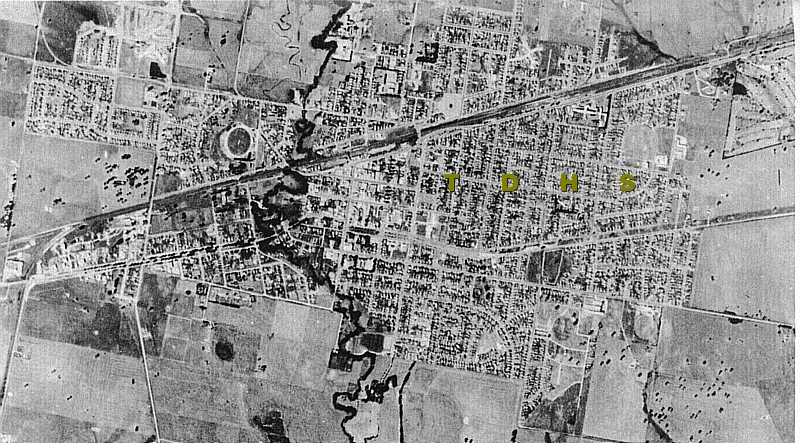
PHOTO: aerial view of Traralgon in 1965. Towards the upper left you can see the showgrounds arena, and the black line of the creek meandering through the town. The newly built hospital is visible in the middle upper right, adjacent to the railway line bisecting the town.
I have taken you through the different forms of Local Government that we have had here in Traralgon. From the arrival of Edward Hobson in 1844 up until 1869, the settlers and others were under the control of the Crown Lands Commissioner, Mr. C. J. Tyers, and later the Central Road Board in Melbourne which looked after the few roads and bridges. In 1869, you will remember that the Rosedale Road Board was appointed. and its territory stretched west as far as the Morwell River. Then, in 1871, the Road Board District was turned into the Shire of Rosedale. This was the state of affairs until 1880, when the part from Flinn's Creek to the Morwell River and from the Latrobe to the Strzelecki Ranges was cut off to become the Shire of Traralgon. Later on, the Morwell area was taken away to form the Shire of Morwell and, in 1885, the Traralgon Shire was divided into Ridings. The town area contained all of the shops and most of the houses. In 1961, the Councillors decided that it was time that Traralgon stepped up a little, and that the town area should be a Borough.
Sale had started off as a Borough in 1863. I told you earlier that a Borough must not contain more than nine square miles, and it was quite easy to get all of the built up areas within the Borough boundaries. On 31st May, 1961, our town was proclaimed a Borough with Councillor J. Maskrey as the first Mayor.
In April, 1961, another primary school was opened, this time at East Traralgon. There was a real need for a school here, for the Housing Commission had built a large number of houses to the east of Liddiard Road, and the children had been causing serious overcrowding at the Grey Street School. Liddiard Road school started off with 235 pupils, most of them coming from Grey Street, and there are now 650 children at the school.
The creation of Traralgon as a Borough in 1961 was just a step on its way to becoming a City. Sale had been a City for years, and Moe had taken that step on 6th March, 1963. Sale was created a Borough over 100 years ago, and many years later became a Town and then, in later years, a City. However, the Traralgon Borough Councillors decided to step straight from a Borough to a City. On 2nd April, 1964, Her Majesty the Queen's representative, Sir Rohan Delacombe, the Governor of our State of Victoria, proclaimed the City of Traralgon here at the Civic Centre in the presence of all the school children and their parents.
It took my mind back to that day in July, 1881, when all the children at the Traralgon State School were present at the old Shire Hall when Councillor Henry Breed laid the foundation stone of that building, which has now been removed to make way for the new highway down Kay Street.
And now boys and girls, I have come to the end of my story. I hope that you will have read it right through to the end. Of course, there are many other happenings about which I might have written, and I may have made a few mistakes, but, in writing it, I have had to make the tale of "The River of Little Fish" a story which will be of real use to you in your classes at school.
Some day, in years to come, one of you may feel like re-writing my story to bring it up to date for your grandchildren so that they, too, may know all about our City where they, also, learn its history at school. It is my sincere hope that you do so, and that you will find as much pleasure as I have had in putting all the bits and pieces together in this, your very own history.
Illustrations from the book
Read articles about the History of Traralgon and find out about Becoming a Member.
